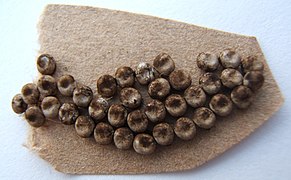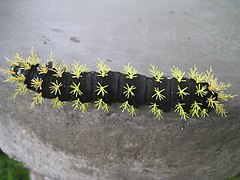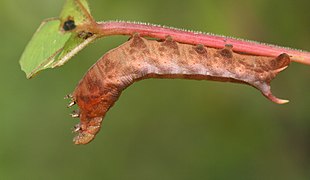Bombycoidea
 | |
|---|---|
 (Saturniidae) | |
| Classificazione scientifica | |
| Dominio | Eukaryota |
| Regno | Animalia |
| Sottoregno | Eumetazoa |
| Superphylum | Protostomia |
| Phylum | Arthropoda |
| Subphylum | Tracheata |
| Superclasse | Hexapoda |
| Classe | Insecta |
| Sottoclasse | Pterygota |
| Coorte | Endopterygota |
| Superordine | Oligoneoptera |
| Sezione | Panorpoidea |
| Ordine | Lepidoptera |
| Sottordine | Glossata |
| Infraordine | Heteroneura |
| Divisione | Ditrysia |
| Superfamiglia | Bombycoidea Latreille, 1802 |
| Sinonimi | |
| Sphingoidea | |
| Famiglie | |
I Bombicoidei (Bombycoidea Latreille, 1802)[1] sono una superfamiglia di lepidotteri, diffusa in tutti i continenti con oltre 6 000 specie.[2][3][4]
Etimologia
Il nome della superfamiglia deriva da quello del genere tipo, Bombyx Linnaeus, 1758,[5] a sua volta ricavato dal termine latino bombyx (baco da seta).[6]
Descrizione


Si tratta di falene eteroneure appartenenti ai Ditrysia, di dimensione media o grande, con abitudini tendenzialmente notturne o crepuscolari, e solitamente robuste e dotate di buona capacità di volo. Il torace e l'addome appaiono spesso ricoperti da una fitta peluria. Il dimorfismo sessuale può essere anche macroscopico, e interessare sia la forma e il colore delle ali, sia altre strutture anatomiche, come ad esempio le antenne, che possono essere più frequentemente pettinate o bipettinate negli esemplari di sesso maschile. Una caratteristica alquanto diffusa è rappresentata dalla riduzione o assenza di diverse strutture immaginali, quali ad esempio le appendici boccali.[3][7]
La superfamiglia, che rivela forti affinità con i Lasiocampoidea e i Mimallonoidea, risulta essere certamente monofiletica, sulla base di quattro caratteri autapomorfici, che si possono così riassumere: 1) procoxe fuse anteriormente tra loro nella larva di ultima età; 2) sull'ottavo somite addominale, setola dorsale D1 sorretta da una protuberanza mesodorsale (di solito uno scolus); 3) ala anteriore con Rs1+Rs2 vicina e parallela a Rs3+Rs4, o addirittura fusa con essa; 4) nel genitale maschile, posizione modificata dei "muscoli 4".[8] Va specificato che l'assenza del primo carattere negli Apatelodidae e in alcuni Eupterotidae,[9] così come l'assenza del secondo carattere negli Eupterotidae stessi e in pochi altri gruppi (Apatelodidae), è da considerarsi un'evoluzione secondaria.[3][7]
Adulto

Capo
L'occhio composto può rivelare o meno la presenza di setole interommatidiali. Non sono presenti ocelli funzionali né veri e propri chaetosemata.[3][7]
Le antenne possono essere bi-, tri- o quadripettinate, con la sola eccezione degli Sphingidae, nei quali subiscono modificazioni secondarie; in quest'ultima famiglia, si possono osservare antenne filiformi, con apice uncinato, ma anche antenne clavate simili a quelle dei Papilionoidea.[3][7]
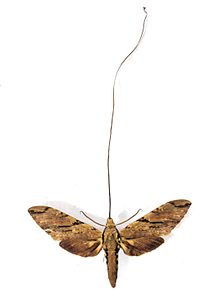
Le appendici boccali sono solitamente ridotte oppure del tutto assenti, seppur con diverse eccezioni. I palpi mascellari sono spesso vestigiali, mentre quelli labiali possono essere da ridotti a molto sviluppati e ascendenti. La spirotromba è di regola ridotta (ad esempio nei Bombycidae e negli Eupterotidae) o del tutto assente (molti Saturniidae), ma può essere ben sviluppata e superare anche diverse volte l'intera lunghezza del corpo, come nel caso degli Sphingidae appartenenti alla sottofamiglia Sphinginae.[3][7]
Torace
Nel mesotorace, la coxa si articola in un meron e un epimeron, uniti da una linea di giunzione lunga o abbastanza lunga. Il metascuto è diviso in parte o completamente in due sezioni in senso antero-posteriore. Non sono presenti organi timpanici toracici.[3][7]

Nell'ala anteriore, Sc è spesso unita per un tratto più o meno lungo con R1, o comunque corre parallela e molto ravvicinata a quest'ultima; i rami di Rs possono essere tutti liberi oppure essere uniti parzialmente o completamente in combinazioni differenti; in alcuni casi Rs1+Rs2 può costituire il margine anteriore di un'areola; M presenta di solito tre rami che corrono separatamente dal margine esterno della cellula discale fino al termen; CuA è presente con due rami mentre CuP è di regola assente o vestigiale; 1A+2A presenta di solito una biforcazione basale più o meno allungata, mentre 3A è assente.[3][7]
L'ala posteriore ha sempre una venulazione molto differente e più semplificata rispetto all'anteriore: la regione omerale può essere particolarmente sviluppata; Sc ed R1 sono di solito parzialmente o completamente fuse tra loro, e in alcuni casi anche con la porzione discale o postdiscale di Rs; i rami di Rs sono di regola ridotti a uno solo, che corre molto vicino e parallelo a Sc+R; sono presenti i tre rami di M e i due di CuA, mentre CuP è di norma assente o vestigiale; 1A+2A è di solito priva di biforcazione basale, mentre 3A può essere presente, ma con un percorso ridotto.[3][7]

Nell'accoppiamento alare, frenulum e retinaculum possono essere ben robusti e articolati, come in alcuni Sphingidae, ma di regola sono ridotti o completamente assenti, e si può avere un accoppiamento di tipo amplessiforme (ad es. negli Endromidae).[7] A differenza dei Lasiocampoidea, qui non si rileva la presenza di una spinarea. L'apice può essere falcato, come nel caso di alcuni Bombycidae e Saturniidae, ma più spesso è arrotondato.[3][7][10]

Nelle zampe, l'epifisi può essere fortemente ridotta, e talvolta assente, mentre la formula degli speroni tibiali può essere 0-2-4 (ad es. negli Eupterotidae), 0-2-2 (come negli Endromidae) o anche 0-2-3 (alcuni Saturniidae); le tibie possono avere spinule omogenee oppure di grandezza differente, o ancora esserne del tutto prive; la forma, il numero e la grandezza delle spine rette dai tarsomeri possono assumere valore tassonomico (vedere in proposito la chiave dicotomica proposta di seguito), così come la presenza e la struttura delle appendici rette dal pretarso, quali arolio, empodio, pulvilli, unghie e così via.[3][7]
Addome
Come nel torace, anche nell'addome non sono presenti organi timpanici. Sulla superficie dei tergiti possono essere presenti delle spinule, molto più rare sugli sterniti (p. es. negli Anthelidae).[3][7]
Nell'apparato riproduttore maschile, uncus e gnathos possono essere ben sviluppati e talvolta anche bilobati, oppure essere del tutto assenti, a seconda del gruppo preso in considerazione; l'edeago può essere dotato di un coecum penis anche allungato, oltre che di uno o più cornuti disposti lungo la vesica.[3][7]

Nel genitale femminile, il corpus bursae può essere ridotto e privo di signum, ad esempio nei Carthaeidae, ma anche sviluppato e provvisto di robusti signa, come nel caso di alcuni Saturniidae e Sphingidae; anche la lunghezza del ductus bursae può variare notevolmente, come pure quella delle apofisi anteriori e posteriori.[3][7]
Uovo
L'uovo ha spesso una forma sferoidale, come in molti Sphingidae, oppure appiattita e pseudocilindrica, come negli Endromidae o nei Saturniidae, con un chorion relativamente liscio, sebbene negli Eupterotidae e nei Brahmaeidae sia frequente la forma verticale. Le uova vengono talvolta deposte in gran numero e in particolari formazioni costituite da più file ordinate, che possono essere molto caratteristiche.[3][7]

Larva
La larva possiede di regola setole primarie, più raramente secondarie (ad es. nei Bombycidae), ma l'aspetto macroscopico può essere riassunto in due tipologie diverse: il corpo può essere densamente rivestito di lunghi peli, come nel caso degli Anthelidae, Apatelodidae, Eupterotidae e alcuni Brahmaeidae, oppure può essere pressoché privo di peli evidenti, come nei Bombycidae, Carthaeidae, Endromidae, Saturniidae, Sphingidae e nella maggior parte dei Brahmaeidae; nel secondo caso, almeno nei primi stadi larvali, è frequente la presenza di un processo dorsale sull'VIII segmento addominale, oltre che di un paio di altre protuberanze (cornetti, scoli e così via) su alcuni o tutti i segmenti toracici. I peli possono essere urticanti[11] e in alcune specie gli scoli possono rilasciare sostanze più o meno tossiche, accumulate dal bruco con funzione difensiva.[12] Colorazioni sgargianti e aposematismi più o meno evidenti non sono rari, come nel caso di Carthaea saturnioides.[3][7]

Capo
Il capo è di solito piccolo rispetto al resto del corpo, soprattutto negli ultimi stadi di sviluppo, con un apparato boccale di tipo ipognato, a indicare un tipo di alimentazione non condotta all'interno di mine, bensì all'aperto, sulla lamina fogliare. Il frontoclipeo è talvolta alquanto allungato. Sono presenti normalmente sei stemmata per lato, spesso disposti su un arco più o meno regolare.[13]

Torace
I segmenti toracici possono talvolta essere allargati e provvisti di evidenti macchie ocellate sui lati, come nel caso dei Saturniidae della sottofamiglia Oxyteninae, o di alcuni Sphingidae; questa caratteristica, associata una postura "minacciosa", costituita dal capo ritirato nel protorace e dai segmenti toracici sollevati, può talvolta ricordare la testa di un piccolo serpente, e avere funzione di difesa quando l'animale viene dispurbato. Lo scudo protoracico può essere alquanto sviluppato e sclerificato, come nel caso di alcuni Saturniidae, ma spesso il secondo e il terzo segmento toracico appaiono notevolmente più sviluppati rispetto al primo (ad es. nei Bombycidae).[3][7][13]
Addome
I segmenti addominali possono rivelare macchie ocellate in corrispondenza della linea degli spiracoli, come nel caso dei Carthaeidae.[7] Spesso sono presenti uno o due processi dorsali sull'VIII segmento addominale; nel caso degli Sphingidae, il cosiddetto "cornetto caudale" può essere notevolmente sviluppato già nelle prime fasi di sviluppo, ma in alcuni casi può essere ridotto ad una semplice protuberanza, o anche mancare del tutto.[13][14]

La larva matura ha cinque coppie di pseudozampe, robuste ma non molto allungate, sui segmenti III-VI e X; l'ultimo paio di pseudopodi, quello anale, appare spesso più sviluppato dei precedenti.[3] Nelle pseudozampe, gli uncini sono di regola robusti e disposti su linee ellittiche incomplete, costituite da uno o più spesso due ordini.[7][13]
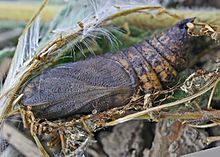
Pupa
La pupa è obtecta, tozza e ovoidale (Saturniidae) oppure più fusiforme (Sphingidae), con tegumento scuro e fortemente sclerificato e antenne ridotte; la spirotromba, laddove presente, è fusa col resto del corpo. L'addome è munito di due soli segmenti mobili, A5 e A6, facilmente distinguibili, e in alcuni casi può presentare una minuta dentellatura dorsale. Non sono frequenti setole secondarie e il cremaster, quando presente, è normalmente costituito da una serie di setole uncinate, poste all'estremità caudale. Il bozzolo sericeo, di regola presente, è spesso elaborato e in talune specie assume rilevanza commerciale (ad es. nei Bombycidae).[3][7]
Biologia
Ciclo biologico
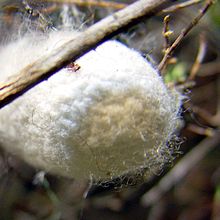
Le uova vengono deposte sulle foglie delle piante ospiti, singolarmente, oppure in formazioni talvolta ordinate e molto caratteristiche; l'adesione al substrato è assicurata dalla presenza di una sostanza viscosa prodotta da alcune ghiandole accessorie della femmina durante la deposizione, come nel caso dei Saturniidae.[3][7]
Tranne poche eccezioni, sia le larve, sia gli adulti sono principalmente attivi durante la notte.[7]
Qualora siano disturbati, alcuni bruchi sono in grado di emettere suoni (una sorta di schiocchi ottenuti dalla ripetuta chiusura delle mandibole), che in parte sono percepibili anche dall'uomo, e che spesso precedono o accompagnano il rigurgito di sostanze tossiche precedentemente accumulate; è possibile che tale comportamento, riscontrato ad esempio nelle larve di Antheraea polyphemus (Saturniidae), sia da considerarsi una forma di "aposematismo acustico", dal momento che si sarebbe dimostrato efficace nella difesa contro piccoli predatori, quali formiche o topolini.[15]
In alcuni gruppi può essere presente il fenomeno del gregarismo nello stadio larvale, soprattutto nelle fasi iniziali dello sviluppo (ad es. negli Eupterotidae), con un grande numero di bruchi che si alimentano insieme, protetti da una sorta di "rete" di fibre intessute attorno alla pianta nutrice.[7]
L'impupamento può aver luogo in un bozzolo fissato alla pianta nutrice, oppure nella lettiera superficiale del sottobosco, come negli Sphingidae.[7][13][16]

Il bozzolo, che negli Anthelidae è a doppio strato, è essenzialmente costituito da fibre sericee estruse dalla larva e intessute grazie alla filiera; esso può anche contenere setole secondarie oppure spinule irritanti di protezione, incorporate dalla larva durante le fasi di tessitura; nei Carthaeidae si è anche notata la presenza di piccolissimi granuli di sabbia tra le fibre intessute. Il bozzolo può anche non essere prodotto e l'impupamento può avvenire nel terreno, non molto in profondità (in alcuni Saturniidae), o nelle fessure tra le pietre (nei Brahmaeidae).[7][17]
Gli adulti sono solitamente forti volatori, come nel caso degli Sphingidae, che possono essere in grado di spostarsi anche da un continente all'altro; nei Carthaeidae e in alcuni Sphingidae e Saturniidae, talvolta, quando l'animale viene disturbato, tende a muovere ritmicamente le ali anteriori e a portare in evidenza le macchie ocellate presenti su quelle posteriori, nel tentativo di distogliere l'eventuale predatore dall'aggressione.[7][17]
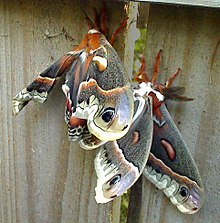
La fase immaginale di solito si alimenta del nettare dei fiori, benché gli adulti dei Saturniidae abbiano le parti boccali fortemente ridotte e gran parte dell'apparato digerente risulti assente. Al contrario, alcuni sphingidae riescono a raggiungere il nettare senza posarsi sul fiore e rimanendo in volo stazionario, in modo simile a quello di un colibrì.[7][17]

Durante le fasi dell'accoppiamento, un ruolo importante è giocato dagli feromoni sessuali che guidano l'adulto nella ricerca del partner; questi possono essere rilasciati dagli androconia, gruppi di scaglie piliformi riunite all'interno di particolari invaginazioni presenti sulle ali dei maschi degli Sphingidae.[7]
Periodo di volo
Le specie appartenenti a questo taxon possono avere un ciclo univoltino, ma anche bi- o trivoltino, come nel caso di alcuni Saturniidae. Per quanto riguarda le specie univoltine, il periodo di volo è di solito corrispondente coi mesi centrali dell'estate e lo stadio svernante può essere rappresentato dalla pupa nel terreno, come in alcuni Sphingidae, oppure dalla larva o ancora dall'uovo, come per alcuni Saturniidae.[13]
Alimentazione
Queste larve non sono minatrici fogliari, ma al contrario si alimentano posate sulle parti vegetali (principalmente le foglie).[3][7][17]
Considerando la vastità del gruppo e la presenza di specie polifaghe, è pressoché impossibile fornire un elenco esaustivo delle piante nutrici. In questa sede, ci si limiterà pertanto a una semplice lista delle principali famiglie di appartenenza delle essenze vegetali su cui si accrescono le larve, al fine dare un'idea di quanto sia ampia la gamma di possibili piante ospiti.[18]
- Acanthaceae Juss., 1789
- Aceraceae Juss., 1789
- Achariaceae Harms, 1897
- Actinidiaceae Gilg & Werderm., 1925
- Agavaceae Dumort., 1829
- Amaranthaceae Juss., 1789
- Anacardiaceae R. Br., 1818
- Annonaceae Juss., 1789
- Apiaceae Lindl., 1836
- Apocynaceae Juss., 1789
- Aquifoliaceae Bercht. & J. Presl, 1825
- Araceae Juss., 1789
- Araliaceae Juss., 1789
- Araucariaceae Henkel & W. Hochst., 1865
- Arecaceae Bercht. & J. Presl, 1820
- Asclepiadaceae Borkh., 1797
- Asparagaceae Juss., 1789
- Asphodelaceae Juss., 1789
- Aspleniaceae Newman, 1840
- Asteraceae Bercht. & J. Presl, 1820
- Balsaminaceae A. Rich., 1822
- Begoniaceae C. Agardh, 1824
- Berberidopsidaceae Takht., 1985
- Betulaceae Gray, 1822
- Bignoniaceae Juss., 1789
- Bixaceae Kunth, 1822
- Bombacaceae Kunth, 1822
- Boraginaceae Juss., 1789
- Brassicaceae Burnett, 1835
- Buddlejaceae K. Wilh., 1910
- Burseraceae Kunth, 1824
- Buxaceae Dumort., 1822
- Cactaceae Juss., 1789
- Canellaceae Mart., 1832
- Cannabaceae Martinov, 1820
- Cannaceae Juss., 1789
- Capparaceae Juss., 1789
- Caprifoliaceae Juss., 1789
- Caricaceae Dumort., 1829
- Caryophyllaceae Juss., 1789
- Casuarinaceae R. Br., 1814
- Celastraceae R. Br., 1814
- Chenopodiaceae Vent., 1799
- Chrysobalanaceae R. Br., 1818
- Clusiaceae Lindl., 1836
- Cochlospermaceae Planch., 1847
- Combretaceae R. Br., 1810
- Commelinaceae Mirb., 1804
- Connaraceae R. Br., 1818
- Convolvulaceae Juss., 1789
- Coriariaceae DC., 1824
- Cornaceae Bercht. ex J. Presl, 1825
- Crypteroniaceae A. DC. ex DC. & A. DC., 1868
- Cucurbitaceae Juss., 1789
- Cunoniaceae R. Br., 1814
- Cupressaceae Gray, 1822
- Cyperaceae Juss., 1789
- Daphniphyllaceae Müll. Arg., 1869
- Dilleniaceae Salisb., 1807
- Dioncophyllaceae Airy Shaw, 1952
- Dioscoreaceae R. Br., 1810
- Dipsacaceae Juss., 1789
- Dipterocarpaceae Blume, 1825
- Ebenaceae Gürke, 1891
- Elaeagnaceae Juss., 1789
- Ephedraceae Dumort., 1829
- Ericaceae Juss., 1789
- Eriocaulaceae Martinov, 1820
- Erythroxylaceae Kunth, 1822
- Escalloniaceae R. Br. ex Dumort., 1829
- Euphorbiaceae Juss., 1789
- Fabaceae Lindl., 1836
- Fagaceae Dumort., 1829
- Fouquieriaceae DC., 1828
- Geraniaceae Juss., 1789
- Gerrardinaceae M.H. Alford, 2006
- Gesneriaceae Rich. & Juss., 1816
- Ginkgoaceae Engl., 1897
- Goodeniaceae R. Br., 1810
- Grossulariaceae DC., 1805
- Hamamelidaceae R. Br., 1818
- Heliconiaceae Nakai, 1941
- Hernandiaceae Blume, 1826
- Hydrangeaceae Dumort., 1829
- Icacinaceae Miers, 1851
- Iridaceae Juss., 1789
- Irvingiaceae Exell & Mendonça, 1951
- Juglandaceae DC. ex Perleb, 1818
- Krameriaceae Dumort., 1829
- Lamiaceae Martinov, 1820
- Lauraceae Juss., 1789
- Lecythidaceae A. Rich., 1825
- Linaceae DC. ex Perleb, 1818
- Loganiaceae R. Br. ex Mart., 1827
- Loranthaceae Juss., 1808
- Lythraceae J. St.-Hil., 1805
- Magnoliaceae Juss., 1789
- Malpighiaceae Juss., 1789
- Malvaceae Juss., 1789
- Melastomataceae Juss., 1789
- Meliaceae Juss., 1789
- Melianthaceae Horan., 1834
- Menyanthaceae Dumort., 1829
- Monimiaceae Juss., 1809
- Moraceae Gaudich., 1835
- Moringaceae Martinov, 1820
- Musaceae Juss., 1789
- Myricaceae Rich. ex Kunth, 1817
- Myrtaceae Juss., 1789
- Nyctaginaceae Juss., 1789
- Ochnaceae DC., 1811
- Oleaceae Hoffmanns. & Link, 1809
- Onagraceae Juss., 1789
- Orchidaceae Juss., 1789
- Oxalidaceae R. Br., 1818
- Paeoniaceae Raf., 1815
- Papaveraceae Juss., 1789
- Passifloraceae Juss. ex Roussel, 1806
- Pedaliaceae R. Br., 1810
- Penaeaceae Sweet ex Guill., 1828
- Pinaceae Spreng. ex Rudolphi, 1830
- Piperaceae Giseke, 1792
- Plantaginaceae Juss., 1789
- Platanaceae T. Lestib., 1826
- Plumbaginaceae Juss., 1789
- Poaceae Barnhart, 1895
- Podocarpaceae Endl., 1847
- Polygonaceae Juss., 1789
- Pontederiaceae Kunth, 1816
- Portulacaceae Juss., 1789
- Primulaceae Batsch ex Borkh., 1797
- Proteaceae Juss., 1789
- Rhamnaceae Juss., 1789
- Rhizophoraceae Pers., 1806
- Rosaceae Juss., 1789
- Rubiaceae Juss., 1789
- Rutaceae Juss., 1789
- Sabiaceae Blume, 1851
- Salicaceae Mirb., 1815
- Santalaceae R. Br., 1810
- Sapindaceae Juss., 1789
- Sapotaceae Juss., 1789
- Saxifragaceae Juss., 1789
- Scrophulariaceae Juss., 1789
- Selaginellaceae Willk., 1854
- Simaroubaceae DC., 1811
- Simmondsiaceae Tiegh., 1899
- Solanaceae Juss., 1789
- Staphyleaceae Martinov, 1820
- Sterculiaceae Vent., 1807
- Styracaceae DC. & Spreng., 1821
- Symplocaceae Desf., 1820
- Tamaricaceae Link, 1821
- Taxaceae Gray, 1822
- Taxodiaceae Saporta, 1865
- Theaceae Mirb., 1816
- Thymelaeaceae Juss., 1789
- Turneraceae Kunth ex DC., 1828
- Ulmaceae Mirb., 1815
- Urticaceae Juss., 1789
- Valerianaceae Batsch, 1802
- Verbenaceae J. St.-Hil., 1805
- Vitaceae Juss., 1789
- Zingiberaceae Martinov, 1820
- Zygophyllaceae R. Br., 1814
Parassitoidismo
Considerata la rilevante quantità di dati disponibili, ci si limiterà, in questa sede, a citare esclusivamente le famiglie di imenottei e di ditteri che comprendono specie in grado di attuare forme di parassitoidismo ai danni delle larve o delle uova di Bombycoidea.[19][20]


- Diptera Linnaeus, 1758
- Oestroidea Leach, 1815
- Tachinidae Robineau-Desvoidy, 1830
- Oestroidea Leach, 1815
- Hymenoptera Linnaeus, 1758
- Chalcidoidea Latreille, 1817
- Chalcididae Latreille, 1817
- Encyrtidae Walker, 1837
- Eulophidae Westwood, 1829
- Eupelmidae Walker, 1833
- Eurytomidae Walker, 1832
- Mymaridae Haliday, 1833
- Perilampidae Latreille, 1809
- Pteromalidae Dalman, 1820
- Torymidae Walker, 1833
- Trichogrammatidae Haliday & Walker, 1851
- Ichneumonoidea Latreille, 1802
- Braconidae Nees, 1812
- Ichneumonidae Latreille, 1802
- Chalcidoidea Latreille, 1817
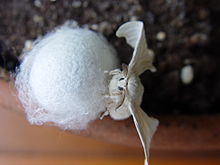
Rilevanza economica
Bachicoltura e industria della seta
La specie Bombyx mori (Linnaeus, 1758) (baco da seta, Bombycidae), di origine asiatica, è allevata almeno da cinque millenni per la produzione di seta, e riveste attualmente una grande importanza nell'industria tessile.[21]
Nella seconda metà del XIX secolo, si tentò di importare dall'Asia alcune specie di Saturniidae sericigene, al fine di studiare un'alternativa alla produzione di seta da parte di B. mori, che in quel momento era soggetto a gravi malattie di allevamento; tra queste, solo due specie si sono in seguito acclimatate in modo stabile (Samia cynthia e Antheraea yamamai), e sono presenti anche sul territorio italiano.[22][23][24]

Farmacologia e biochimica industriale
Bombyx mori è utilizzata come organismo modello per studi farmacologici concernenti la cinetica di assorbimento di determinati principi attivi.[25][26] Va peraltro ricordato che grazie a questa specie fu scoperto nel 1959 il primo feromone sessuale noto, il bombicolo (10-12-esadecadien-1-olo), in seguito impiegato nella lotta integrata al fine di ridurre l'utilizzo di fitofarmaci.[27][28]
Alimentazione umana
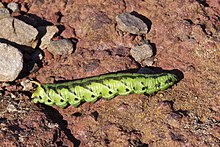
Le larve di svariate specie di Saturniidae e di alcuni Sphingidae sono utilizzate per l'alimentazione umana in alcune zone dell'Africa subsahariana, nonché in alcune parti dell'America centrale e dell'Indocina.[29] A tale proposito, va ricordato che il consumo di 100 g di bruchi essiccati fornisce mediamente circa il 76 % del fabbisogno individuale giornaliero di proteine e oltre il 100 % di quello di sali minerali e vitamine.[30]
Principali avversità delle piante coltivate
Diverse specie di Bombycoidea possono avere un impatto più o meno rilevante sulla resa qualitativa e quantitativa di diverse piante da frutto, sul patrimonio di piante ornamentali o anche su altri tipi di coltivazioni, quali il tabacco; la maggior parte di queste appartiene alle famiglie Sphingidae e Saturniidae.[23]

Sphingidae
Un notevole interesse è incentrato su Manduca sexta (Linnaeus, 1763) (sfinge del tabacco), le cui larve possono arrecare danno, oltre che a questa pianta, anche ad altre solanaceae quali il Capsicum annuum (peperone/peperoncino), il pomodoro e la patata.[31]
Altri sfingidi degni di nota per il loro impatto sui raccolti oppure sulle piante ornamentali, sono:[23]

- Acherontia atropos (Linnaeus, 1758) (sfinge testa di morto), per solanacee (patata, melanzana, pomodoro) ma anche ligustro, olivo, vite, oleandro e frassino[32]
- Agrius convolvuli (Linnaeus, 1758) (sfinge del convolvolo), per il convolvolo e la patata dolce[33]
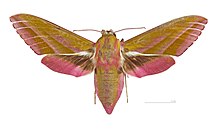
- Daphnis nerii (Linnaeus, 1758) (sfinge dell'oleandro), per oleandri, pervinche e, talvolta, la vite[23]
- Deilephila elpenor (Linnaeus, 1758) (sfinge della vite), appunto, per la vite[23]
- Deilephila porcellus (Linnaeus, 1758), per Galium ed Epilobium[23]
- Hippotion celerio (Linnaeus, 1758), talvolta per la vite[23]
- Hyles euphorbiae (Linnaeus, 1758) (sfinge dell'euforbia), per varie Euphorbiaceae e per la vite[23]

- Hyles gallii (Rottemburg, 1775) (sfinge del Galium), per betulle, epilobi, fuchsie e salici[23]
- Hyles livornica (Esper, 1780), per piante coltivate (olivo, vite, piante da frutto) ma anche ornamentali (acacie, eucalipti, corbezzoli)[23][34][35]

- Laothoe populi (Linnaeus, 1758) (sfinge del pioppo), per pioppi e salici[23]
- Macroglossum stellatarum (Linnaeus, 1758) (sfinge colibrì), per i Galium[23][36]
- Mimas tiliae (Linnaeus, 1758) (sfinge del tiglio), per tigli, ontani, olmi, querce e diversi alberi da frutto[23]

- Smerinthus ocellata (Linnaeus, 1758) (sfinge dagli occhi), per salici, pioppi e tigli, talvolta piante da frutto[23]
- Sphinx ligustri Linnaeus, 1758 (sfinge del ligustro), per ligustri e altre Oleaceae (olivo, frassino, fillirea)[23]

- Sphinx pinastri Linnaeus, 1758 (sfinge del pino), per pini e pecci[37]
Saturniidae
Tra i Saturniidae, per quanto riguarda i possibili danni arrecati a piante da frutto oppure ornamentali, possiamo citare:[23]
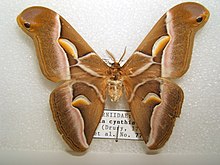
- Aglia tau (Linnaeus, 1758), per faggi e altre latifoglie[23]
- Antheraea yamamai (Guénerin-Méneville, 1861), per le querce[22]

- Samia cynthia (Drury, 1773) (bombice dell'ailanto o filosamia), per ailanti, ligustri, ricini, prugni, peri, sambuchi e noci[38]
- Saturnia pavonia (Linnaeus, 1758) (pavonia minore), per Rumex, Potentilla, Rubus, otre a varie pomacee[39]
- Saturnia pyri (Denis & Schiffermüller, 1775) (saturnia del pero o pavonia maggiore), per peri, meli e altri fruttiferi[40]

Altri Bombycoidea
In alcui casi, sono anche stati segnalati danni al patrimonio forestale, arrecati dalle seguenti specie:[23]

- Brahmaea europaea Hartig, 1963 (Brahmaeidae), per ligustri e frassini[41][42][43][44]
- Endromis versicolora (Linnaeus, 1758) (bombice variegato o falsa sfinge della betulla, Endromidae) soprattutto per betulle, e in misura minore per ontani, carpini e noccioli[42][45]
Metodi di lotta
Le tecniche di lotta contro le avversità appartenenti ai Bombycoidea sono le più varie, ma si possono ricondurre alle seguenti metodiche:[28]
- lotta biologica, effettuata prevalentemente tramite l'utilizzo di parassitoidi come particolari ditteri e imenotteri, che agiscono sugli stadi immaturi (uova e larve; vedi apposito paragrafo)
- lotta biotecnica, attuata con l'impiego di specifici virus, nematodi o batteri (ad esempio Bacillus thuringiensis)
- confusione sessuale, provocata grazie all'immissione in ambiente di piccole quantità di feromone sessuale che riducono la capacità riproduttiva della specie dannosa (può essere ricondotta anch'essa ad un concetto più ampio di lotta biotecnica)

Distribuzione e habitat
I Bombycoidea sono presenti in tutti i continenti (esclusa l'Antartide), anche se non con ogni famiglia. Più in dettaglio, i Saturniidae e gli Sphingidae sono cosmopoliti, i Bombycidae e gli Eupterotidae sono presenti ovunque tranne in Europa e Nordamerica, i Brahmaeidae si trovano in Eurasia e Africa, gli Endromidae solo in Eurasia, gli Apatelodidae solo nelle Americhe, i Phiditiidae solo in Sudamerica, mentre gli Anthelidae e i Carthaeidae sono presenti esclusivamente in Oceania. In generale, comunque, la maggiore ricchezza di specie si riscontra nelle regioni tropicali e subtropicali.[3][7][13][17]
Tassonomia
Chiave dicotomica per la determinazione delle famiglie
Viene di seguito riportata una chiave dicotomica per il riconoscimento della famiglia di appartenenza, ricavata da quella proposta da Claude Lemaire & Joël Minet (1999), in cui è preso in considerazione il solo stadio adulto; va specificato che oltre alle famiglie attualmente (2017) inserite nei Bombycoidea, vengono qui riportati anche i Lasiocampidae e i Mimallonidae, oggi spostati nelle rispettive superfamiglie monotipiche, ma in passato considerati appartenenti a questo taxon o comunque in forte affinità con esso; nella chiave non sono prese in considerazione le famiglie Phiditiidae e Apatelodidae, qui considerate all'interno dei Bombycidae.[3]
| 1 Microtterismo (solo nelle femmine di alcune specie) | 2 |
| 1' Ali completamente sviluppate | 4 |
| 2 Australiano | Anthelidae (in parte) |
| 2' Non australiano | 3 |
| 3 Antenne dorsalmente ricoperte da scaglie fino all'apice | Lasiocampidae (in parte) |
| 3' Antenne prive di scaglie sull'apice | Saturniidae (in parte) |
| 4 Nell'ala anteriore, la convergenza tra Rs1 ed Rs2 di solito libera dagli altri rami di Rs, e anche Rs3 libero, oppure l'apice del tratto comune Rs3+Rs4 alquanto distante da Rs1+Rs2; nel caso in cui i rami di Rs siano disposti in maniera differente, ad essi si trova associata un'areola oppure è presente un organo con funzione affine a quella dei chaetosemata sul primo articolo del palpo labiale | 5 |
| 4' Nell'ala anteriore, il tratto comune di Rs3+Rs4 parallelo e molto ravvicinato al tratto comune di Rs1+Rs2, oppure tutti i rami di Rs uniti assieme; areola assente; sul primo articolo del palpo labiale, assenza di un organo simile ai chaetosemata (Bombycoidea sensu stricto) | 7 |
| 5 Nell'ala anteriore: assenza di areola ed M2 che parte dalla cellula discale più o meno a metà strada tra M1 ed M3. Nell'ala posteriore: Sc che diverge nettamente dal margine anteriore della cellula discale (dopo un breve tratto in comune con la parte basale di questo margine) e termina distante dalla sezione postdiscale di Rs. Nessun organo simile ai chaetosemata alla base del palpo labiale | Mimallonidae |
| 5' Nell'ala anteriore: areola talvolta presente ed M2 che parte dalla cellula discale più vicino ad M3 che ad M1. Nell'ala posteriore: quando Sc è fusa solo con la base del margine anteriore della cellula discale, tende a divergere solo moderatamente da questo margine. Presenza di nervature trasversali tra Sc e la cellula discale, oppure tra Sc e la porzione postdiscale di Rs (che spesso appare ravvicinata o fusa la corrispondente sezione di Sc). Presenza frequente di un organo simile ai chaetosemata alla base del palpo labiale (Lasiocampidae) | 6 |
| 6 Ala anteriore di solito con una lunga areola compresa tra i rami di Rs; maschio provvisto di retinaculum su Sc e frenulum ben sviluppato; ala posteriore priva di nervatura omerale; nessun organo simile ai chaetosemata alla base del palpo labiale | Anthelidae (in parte) |
| 6' Ala anteriore priva di areola; frenulum e retinaculum assenti in entrambi i sessi; da una a numerose nervature omerali solitamente presenti sull'ala posteriore; primo segmento del palpo labiale provvisto ventralmente o latero-ventralmente di un organo simile ai chaetosemata | Lasiocampidae (in parte) |
| 7 Ala posteriore con Sc+R ravvicinata alla porzione postdiscale di Rs | 8 |
| 7' Ala posteriore con Sc+R lontana dalla porzione postdiscale di Rs | 10 |
| 8 Antenne sempre bi- o tripettinate in entrambi i sessi; ala anteriore con tutti i rami di Rs convergenti e con la base di M2 equidistante da M1 ed M3 oppure più vicina ad M1 | 9 |
| 8' Antenne raramente pettinate ma di frequente spesse e grosso modo filiformi oppure clavate (di solito con un margine ventrale lamellato e un apice affusolato e rivolto verso l'alto); ala anteriore con Rs1+Rs2 mai convergente con Rs3+Rs4, e con la base di M2 leggermente più vicina a M3 che a M1 | Sphingidae |
| 9 Zampa anteriore più o meno ridotta, con basitarso provvisto (esternamente e/o ventralmente) di due spine più sviluppate, che possono essere a forma di dente e distanti una dall'altra (spine più robuste possono talvolta essere situate anche oltre il basitarso); frenulum e retinaculum sempre assenti, ed entrambi i sessi muniti di accoppiamento alare di tipo amplessiforme | Lemonia (Brahmaeidae) |
| 9' Zampa anteriore mai fortemente ridotta, con basitarso provvisto di spine normalmente sviluppate; nel maschio, talvolta accoppiamento alare del tipo provvisto di frenulum e retinaculum | Brahmaeidae, tranne Lemonia |
| 10 Ala anteriore con i tratti comuni di Rs1+Rs2 ed Rs3+Rs4 ben distinti, benché ravvicinati e paralleli | Carthaeidae |
| 10' Ala anteriore con tutti rami di Rs convergenti in un tratto unico | 11 |
| 11 Ala posteriore munita di un frenulum o almeno della base tubulare di tale struttura | 12 |
| 11' Frenulum del tutto assente | 13 |
| 12 Ala anteriore con il tratto comune di Rs3 ed Rs4 lungo più o meno quanto la porzione libera di Rs4, oppure nettamente più lunga di quest'ultima; nel caso in cui Rs3 ed Rs4 siano uniti per un tratto più corto, allora presenza di occhio composto con setole interommatidiali oppure, nel maschio, antenne prive di rami ben sviluppati nel tratto distale del flagello; cellula discale mai molto piccola | Bombycidae |
| 12' Ala anteriore con il tratto comune di Rs3 ed Rs4 sempre più corto della porzione libera di Rs4; setole interommatidiali assenti; antenne con flagello bi- o tripettinato fino all'apice; cellula discale spesso molto piccola | Eupterotidae |
| 13 Sia nell'ala anteriore, sia nella posteriore, M2 ha origine più vicino a M3 che a M1 | Endromidae, tranne Mirina |
| 13' Sia nell'ala anteriore, sia nella posteriore, M2 ha origine a metà strada tra M1 ed M3, oppure più vicino a M1 | 14 |
| 14 Ala anteriore con quattro ramificazioni di Rs e un lunghissimo "anello anale"; in entrambi i sessi, antenne bipettinate fino all'apice, con rami rivolti ventralmente; zampa anteriore con il quarto tarsomero che presenta "normali" spine in entrambi i sessi | Mirina (Endromidae) |
| 14' Nell'ala anteriore, Rs con al massimo tre ramificazioni e "anello anale" da ridotto a praticamente assente; antenne di varia forma, spesso quadripettinate, e con rami rivolti lateralmente o dorso-lateralmente; nella femmina, zampa anteriore con il quarto tarsomero solitamente provvisto di una coppia distale di strutture dentiformi (assenti nel maschio) | Saturniidae (in parte) |
Famiglie e sottofamiglie
Il taxon è cosmopolita e comprende 10 famiglie, per un totale di 520 generi e 6.092 specie, così suddivisi:[4]
- Anthelidae Turner, 1904 - Trans. Ent. Soc. Lond. 1904: 470 (chiave); 478 (come Lymantriadae, Anthelinae)[46] - 2 sottofamiglie, 9 generi, 94 specie; Oceania
- Anthelinae Turner, 1904 - Trans. Ent. Soc. Lond. 1904: 470 (chiave); 478 (come Lymantriadae, Anthelinae)[46] - 7 generi, 91 specie; Oceania
- Munychryiinae Common & McFarland, 1970 - J. Aust. Ent. Soc. 9: 11[47] - 2 generi, 3 specie; Oceania
- Apatelodidae Neumoegen & Dyar, 1894 - J. N.Y. Ent. Soc. 2(3): 112 (chiave) (come Notodontidae, Apatelodinae)[48] - 12 generi, 182 specie; Americhe
- = Zanolidae McDunnough, 1938 - Mem. sth. Calif. Acad. Sci. 1: 138[49]
- Bombycidae Latreille, 1802 - Hist. nat. ins. 3: 404 (come Bombycinae)[1] - 2 sottofam., 27 generi, 202 specie; America centrale e meridionale, Asia, Africa e Oceania
- Bombycinae Latreille, 1802 - Hist. nat. ins. 3: 404 (come Bombycinae)[1] - 18 generi, 101 specie; America centrale e meridionale, Asia, Africa e Oceania
- Epiinae Draudt & Schauss, 1929 - In: Seitz, Gross-Schmett. Erde 6: 675[50] - 8 generi, 100 specie; America centrale e meridionale
- incertae sedis - 1 genere, 1 specie (fossile)
- Brahmaeidae Swinhoe, 1892 - Cat. east. and Aust. Lep. Het. Colln Oxf. Univ. Mus. 1: 253[51] - 6 generi, 68 specie; Eurasia e Africa
- = Lemoniidae Hampson, 1918 - Novit. zool. 25: 367 (come Lemoniadae)[52]
- = Sabaliidae Hampson, 1901 - Trans. Ent. Soc. Lond. 1901(2): 187 (come Sabaliadae)[53]
- Carthaeidae Common, 1966 - Aus. J. Ent. 5: 29[54] - 1 genere, 1 specie, Oceania
- Endromidae Boisduval, 1828 - Eur. Lepid. Index meth.: 50 (come Endromidi)[55] - 16 generi, 70 specie; Eurasia
- = Mirinidae Kozlov, 1985 - Vest. Leningr. gos. Univ. (Biol.) 1985(4): 3[56]
- = Oberthueriinae Kuznetzov & Stekolnikov, 1985 - Trudy zool. Inst. 134: 3[8]
- = Prismostictinae Forbes, 1955 - Tijdschr. Ent. 98: 120[57]
- Eupterotidae Swinhoe, 1892 - Cat. east. and Aust. Lep. Het. Colln Oxf. Univ. Mus. 1: 271[51] - 4 s.fam. + 1 gruppo, 60 gen., 396 spp.; Asia, Africa, Oceania, Centro- e Sudam.
- Eupterotinae Swinhoe, 1892 - Cat. east. and Aust. Lep. Het. Colln Oxf. Univ. Mus. 1: 271[51] - 11 generi, 105 specie; Asia, Africa, Oceania, Centro- e Sudamerica
- = Cotaninae Forbes, 1955 - Tijdschr. Ent. 98: 131 (come Cotanini)[57]
- Janinae Aurivillius, 1902 - Bih. Svenska Akad. 27(7): 4 (chiave)[58] - 22 generi, 148 specie; Africa
- = Hibrildinae Berger, 1958 - Lambillionea 57(9-10): 73[59]
- = Tissanginae Forbes, 1955 - Tijdschr. Ent. 98: 98 (come Tissangini)[57]
- Panacelinae Forbes, 1955 - Tijdschr. Ent. 98: 120[57] - 1 genere, 3 specie; Oceania
- Striphnopteryginae Wallengren, 1858 - Ofvers. K. Vetensk Akad. Förh. 15: 210 (come Striphnopteryges)[60] - 16 generi, 83 specie; Africa e Oceania
- = Phialinae Wallengren, 1865 - Het.-fjär. saml. Kaff. Wahlberg: 33 (come Phialidae)[61]
- Gruppo Ganisa - 10 generi, 57 specie
- Phiditiidae Minet, 1994 - Ins. Syst. Evol. 25(1): 63 (come Bombycidae, Phiditiinae)[62] - 4 generi, 23 specie; America meridionale
- Saturniidae Boisduval, 1834 - Icones hist. Lepid. Eur. 2: 170 (come Saturnides)[63] - 8 sottofamiglie, 180 generi, 2.349 specie; cosmopolita
- Agliinae Packard, 1893 - Ann. Mag. nat. Hist. (6) 11: 172[64] - 1 genere, 6 specie; Eurasia
- Arsenurinae Jordan, 1922 - Novit. zool. 29: 250[65] - 10 generi, 137 specie; Americhe
- = Rhescyntinae Bouvier, 1930 - Bull. Hill Mus. Witley 4: 3 (come Rhescyntidae)[66]
- Ceratocampinae Harris, 1841 - Rep. Insects Mass. injurious Vegn.: 287 (come Ceratocampadae)[67] - 31 generi, 195 specie; Americhe
- = Adelocephalinae Boisduval, 1872 - Annls Soc. ent. Belg. 15: 79 (come Adélocéphalides)[68]
- = Citheroniinae Neumoegen & Dyar, 1894 - J. N.Y. ent. Soc. 2: 174 (come Citheroniidae)[48]
- = Dryocampinae Grote & Robinson, 1866 - Ann. Lyc. nat. Hist. 8: 379 (come Dryocampini)[69]
- = Sphingicampinae Packard, 1901 - Psyche, Camb. 9: 280 (come Sphingicampidae)[70]
- = Syssphinginae Packard, 1914 - Mem. natn. Acad. Sci. 12: 1 (come Syssphingina)[71]
- Cercophaninae Jordan, 1924 - Novit. zool. 31: 181 (come Cercophanidae)[72] - 4 generi, 16 specie; America meridionale
- Hemileucinae Grote & Robinson, 1866 - Ann. Lyc. nat. Hist. 8: 376 (come Hemileucini)[69] - 51 generi, 797 specie; Americhe
- = Automerinae Grote, 1896 - Mitt. Roemermus. Hildes. 6: 3; 27[73]
- = Dirphiinae Burmeister, 1878 - Descr. phys. Rép. Arg. 5 (Lépid. I): 473 (come Dirphiadae)[74]
- Oxyteninae Jordan, 1924 - Novit. zool. 31: 135 (come Oxytenidae)[72] - 5 generi, 36 specie; Americhe
- Salassinae Michener, 1949 - Evolution, Lancaster, Pa. 3(2): 130[75] - 1 genere, 37 specie; Asia
- Saturniinae Boisduval, 1834 - Icones hist. Lepid. Eur. 2: 170 (come Saturnides)[63] - 77 generi; 1.125 specie; cosmopolita
- = Attacinae Duponchel, 1844 - Cat. méth. Lépid. Eur.: 78 (come Attaccidae)[76]
- = Bunaeinae Cooper, 2002 - In: Cooper & Cooper, The emperor moths of KwaZulu-Natal: x[77]
- = Holocerinae Packard, 1914 - Mem. natn. Acad. Sci. 12: 144[71]
- = Ludiinae Aurivillius, 1904 - Ark. Zool. 2(4): 21[78]
- Sphingidae Latreille, 1802 - Hist. nat. ins. 3: 400 (come Sphingides)[1] - 4 sottofamiglie, 206 generi, 1.824 specie; cosmopolita
- Langiinae Tutt, 1904 - Nat. hist. Brit. Lep. 4: 504 (come Langiidi)[79] - 1 genere, 1 specie; Asia
- Macroglossinae Harris, 1839 - Am. J. Sci. Arts 36: 287 (come Macroglossiadae)[80] - 84 generi, 1.011 specie; cosmopolita
- = Choerocampinae Grote & Robinson, 1865 - Proc. ent. Soc. Philad. 5: 153 (come Chaerocampini)[81]
- = Dilophonotinae Burmeister, 1878 - Descr. physique Rep. Arg. 5 (Lepid. 1): 314 (chiave) (come Dilophonotidae)[74]
- = Philampelinae Burmeister, 1878 - Descr. physique Rep. Arg. 5 (Lepid. 1): 314 (chiave) (come Philampeliadae)[74]
- = Semanophorinae Rothschild & Jordan, 1903 - Novit. zool. 9 (Suppl.): cxxxv (come Semanophorae)[82]
- Smerinthinae Grote & Robinson, 1865 - Proc. ent. Soc. Philad. 5: 160 (come Smerinthini)[81] - 69 generi, 478 specie; cosmopolita
- = Ambulicinae Butler, 1876 - Trans. zool. Soc. Lond. 9: 514[83]
- Sphinginae Latreille, 1802 - Hist. nat. ins. 3: 400 (come Sphingides)[1] - 52 generi, 334 specie; cosmopolita
- = Acherontiinae Butler, 1876 - Trans. zool. Soc. Lond. 9: 515[83]
- = Asemanophorinae Rothschild & Jordan, 1903 - Novit. zool. 9 (Suppl.): cxxxv (come Asemanophorae)[82]

Va peraltro aggiunto che fino agli anni novanta del XX secolo, la famiglia Sphingidae veniva inserita in una superfamiglia distinta (Sphingoidea), sulla base di alcune differenze anatomiche (soprattutto immaginali) rispetto al resto dei Bombycoidea.[17]
Sinonimi
È stato riportato un sinonimo:
- Sphingoidea Latreille, 1802 (incl.) - Hist. nat. ins. 3: 400 (come Sphingides)[1]
Endemismi italiani
L'unica specie endemica del territorio italiano è il brameide Brahmaea (Acanthobrahmaea) europaea Hartig, 1963, il cui areale è limitato alle sole province di Potenza, Matera e Avellino.[41][42][43][44]
Filogenesi
Kristensen nel 1998 propose un albero filogenetico che collocava, all'interno dei Macrolepidoptera, il gruppo Mimallonoidea/Lasiocampoidea/Bombycoidea in una posizione distinta rispetto al clade comprendente Calliduloidea, Papilionoideae Geometroidea, ma anche rispetto a quello dei Noctuoidea:[3]
| Macrolepidoptera |
| |||||||||||||||||||||||||||||||||
L'analisi genetica svolta da Heikkila et al. (2015)[84] ha invece portato alla luce nuove relazioni tra le superfamiglie, tanto da giungere a un cladogramma da cui è stato ricavato quello riportato qui sotto; è confermata la prossimità evolutiva dei Bombycoidea rispetto ai Lasiocampoidea, ma i Mimallonoidea sono spostati in posizione diversa:
| Obtectomera |
| ||||||||||||||||||||||||||||||||||||||||||||||||||||||||||||||||||||||||||||||||||||||||||||||||||||||||||||||||||||||||||||||||||||||||||||||||||||||||||||||||||
Come si può notare dallo schema riportato qui sopra, Bombycoidea si conferma certamente come raggruppamento monofiletico, così come le famiglie che lo compongono. L'unica evidente incongruenza rispetto all'impostazione tassonomica riportata più sopra, riguarda la posizione dei generi di Brahmaeidae: infatti, laddove Brahmaea appare un sister group degli Sphingidae nella loro interezza, al contrario, Dactyloceras, Lemonia e Sabalia risulterebbero essere più affini al clade Apatelodidae/Eupterotidae. Heikkila e coll. hanno spiegato questo risultato con la possibile carenza di materiale genetico analizzato e con il tipo di caratteri morfologici immaginali presi in considerazione.[84]
Alcune specie
Adulti
-

-
 Anthela nicothoe
Anthela nicothoe
(Anthelidae, Anthelinae) -
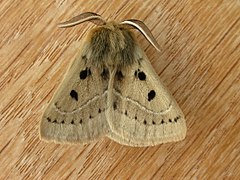 Anthela ocellata
Anthela ocellata
(Anthelidae, Anthelinae) -
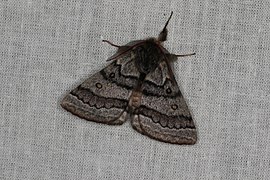 Anthela tetraphrica
Anthela tetraphrica
(Anthelidae, Anthelinae) -
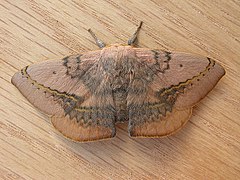 Anthela varia
Anthela varia
(Anthelidae, Anthelinae) -
 Chenuala heliaspis
Chenuala heliaspis
(Anthelidae, Anthelinae) -
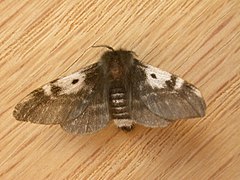 Nataxa flavescens
Nataxa flavescens
(Anthelidae, Anthelinae) -
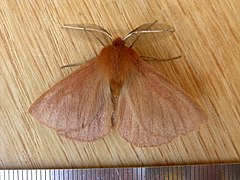 Pterolocera leucocera
Pterolocera leucocera
(Anthelidae, Anthelinae) -
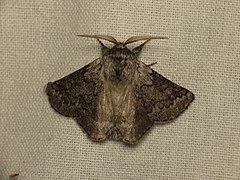
-
 Apatelodes palma
Apatelodes palma
(Apatelodidae, Apatelodinae) -
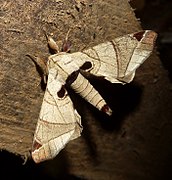 Apatelodes pandarioides
Apatelodes pandarioides
(Apatelodidae, Apatelodinae) -
 Apatelodes torrefacta
Apatelodes torrefacta
(Apatelodidae, Apatelodinae) -
 Apatelodes turrialba
Apatelodes turrialba
(Apatelodidae, Apatelodinae) -
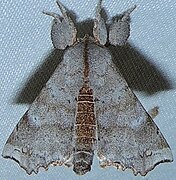 Olceclostera angelica
Olceclostera angelica
(Apatelodidae, Apatelodinae) -
 Tamphana marmorea
Tamphana marmorea
(Apatelodidae, Epiinae) -
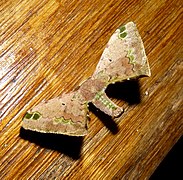 Anticla antica
Anticla antica
(Bombycidae) -
 Bombyx incomposita
Bombyx incomposita
(Bombycidae) -
 Colla opalifera
Colla opalifera
(Bombycidae) -
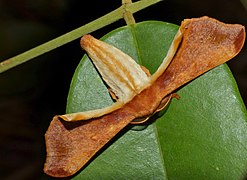 Gunda ochracea
Gunda ochracea
(Bombycidae) -
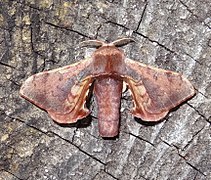 Triuncina brunnea
Triuncina brunnea
(Bombycidae) -
 Brahmaea certhia
Brahmaea certhia
(Brahmaeidae) -
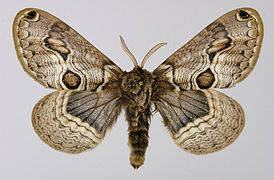 Brahmaea europaea
Brahmaea europaea
(Brahmaeidae) -
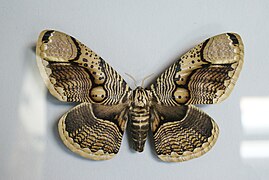 Brahmaea hearseyi
Brahmaea hearseyi
(Brahmaeidae) -
 Brahmaea japonica
Brahmaea japonica
(Brahmaeidae) -
 Brahmaea wallichii
Brahmaea wallichii
(Brahmaeidae) -
 Spiramiopsis comma
Spiramiopsis comma
(Brahmaeidae) -
 Endromis vesicolora
Endromis vesicolora
(Endromidae) -
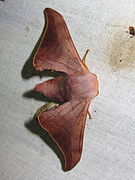 Mustilia gerontica
Mustilia gerontica
(Endromidae) -
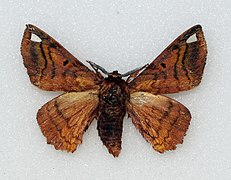 Prismosticta regalis
Prismosticta regalis
(Endromidae) -
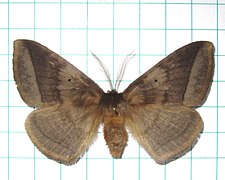 Apona fuliginosa
Apona fuliginosa
(Eupterotidae, Eupterotinae) -
 Eupterote asclepiades
Eupterote asclepiades
(Eupterotidae, Eupterotinae) -
 Pseudojana perspicuifascia
Pseudojana perspicuifascia
(Eupterotidae, Eupterotinae) -
 Jana tantalus
Jana tantalus
(Eupterotidae, Janinae) -
 Stenoglene roseus
Stenoglene roseus
(Eupterotidae, Janinae) -
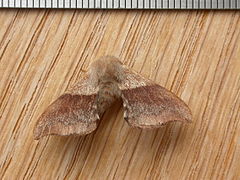 Panacela lewinae
Panacela lewinae
(Eupterotidae, Panacelinae) -
 In F: Phiditia diores
In F: Phiditia diores
(Phiditiidae) -

-
 Copiopteryx jehovah
Copiopteryx jehovah
(Saturniidae, Arsenurinae) -
 Rhescyntis pseudomartii
Rhescyntis pseudomartii
(Saturniidae, Arsenurinae) - Titaea timur
(Saturniidae, Arsenurinae) -
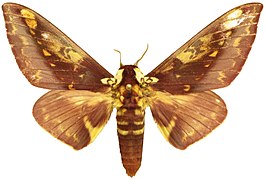 Citheronia phoronea
Citheronia phoronea
(Saturniidae, Ceratocampinae) -
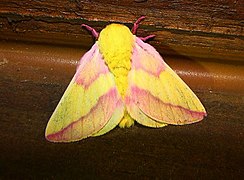 Dryocampa rubicunda
Dryocampa rubicunda
(Saturniidae, Ceratocampinae) -
 Microdulia mirabilis
Microdulia mirabilis
(Saturniidae, Cercophaninae) -
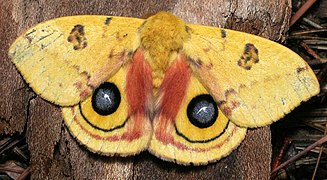 Automeris io
Automeris io
(Saturniidae, Hemileucinae) -
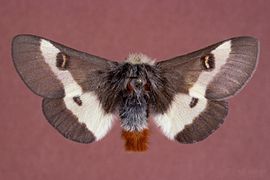 Hemileuca maia
Hemileuca maia
(Saturniidae, Hemileucinae) - Pseudautomeris luteata
(Saturniidae, Hemileucinae) -
 Oxytenis mirabilis
Oxytenis mirabilis
(Saturniidae, Oxyteninae) -
 Oxytenis modestia
Oxytenis modestia
(Saturniidae, Oxyteninae) -
 Therinia lactucina
Therinia lactucina
(Saturniidae, Oxyteninae) - Salassa lola
(Saturniidae, Salassinae) -
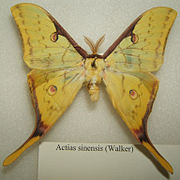 Actias sinensis
Actias sinensis
(Saturniidae, Saturniinae) -
 Antheraea celebensis
Antheraea celebensis
(Saturniidae, Saturniinae) -
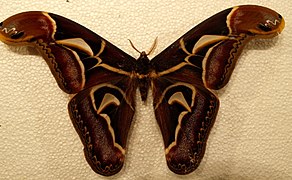 Archaeoattacus edwardsii
Archaeoattacus edwardsii
(Saturniidae, Saturniinae) -
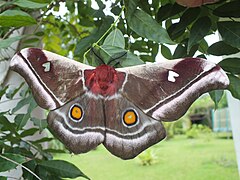 Bunaea aslauga
Bunaea aslauga
(Saturniidae, Saturniinae) -
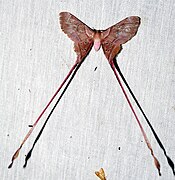 Eudaemonia troglophylla
Eudaemonia troglophylla
(Saturniidae, Saturniinae) -
 Eupackardia calleta
Eupackardia calleta
(Saturniidae, Saturniinae) -
 Rotschildia cincta
Rotschildia cincta
(Saturniidae, Saturniinae) -
 Langia zenzeroides
Langia zenzeroides
(Sphingidae, Langiinae) -
-
 Amphion floridensis
Amphion floridensis
(Sphingidae, Macroglossinae) -
 Angonyx testacea
Angonyx testacea
(Sphingidae, Macroglossinae) -
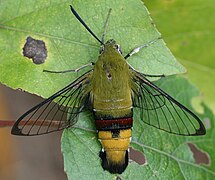 Cephonodes hylas
Cephonodes hylas
(Sphingidae, Macroglossinae) -
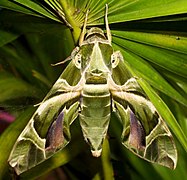 Daphnis nerii
Daphnis nerii
(Sphingidae, Macroglossinae) -
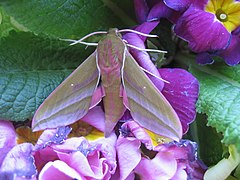 Deilephila elpenor
Deilephila elpenor
(Sphingidae, Macroglossinae) -
 Deilephila porcellus
Deilephila porcellus
(Sphingidae, Macroglossinae) -
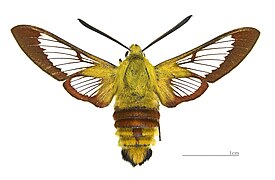 Hemaris fuciformis
Hemaris fuciformis
(Sphingidae, Macroglossinae) -
 Hippotion celerio
Hippotion celerio
(Sphingidae, Macroglossinae) -
 Adhemarius donysa
Adhemarius donysa
(Sphingidae, Smerinthinae) -
 Amorpha juglandis
Amorpha juglandis
(Sphingidae, Smerinthinae) -
 Callambulyx junonia
Callambulyx junonia
(Sphingidae, Smerinthinae) -
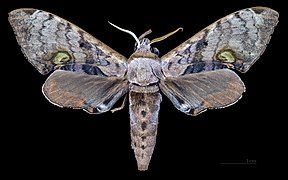 Daphnusa ocellaris
Daphnusa ocellaris
(Sphingidae, Smerinthinae) -
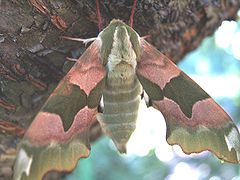 Mimas tiliae
Mimas tiliae
(Sphingidae, Smerinthinae) -
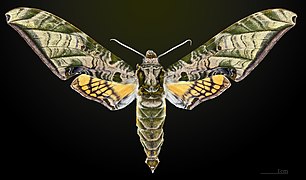 Protambulyx eurycles
Protambulyx eurycles
(Sphingidae, Smerinthinae) -
 Smerinthus ocellata
Smerinthus ocellata
(Sphingidae, Smerinthinae) -

-
 Anambulyx elwesi
Anambulyx elwesi
(Sphingidae, Sphinginae) - Cocytius antaeus
(Sphingidae, Sphinginae) -
 Coelonia fulvinotata
Coelonia fulvinotata
(Sphingidae, Sphinginae) -
 Euryglottis guttiventris
Euryglottis guttiventris
(Sphingidae, Sphinginae)
Uova
- Andraca theae
(Endromidae) -
 Sphingicampa bicolor
Sphingicampa bicolor
(Saturniidae, Ceratocampinae) -
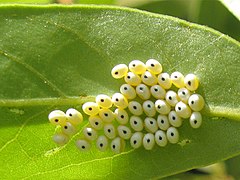 Automeris io
Automeris io
(Saturniidae, Hemileucinae) - Actias luna
(Saturniidae, Saturniinae) -
-
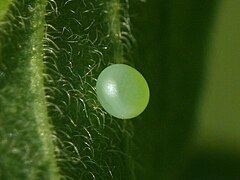 Hemaris fuciformis
Hemaris fuciformis
(Sphingidae, Macroglossinae) -
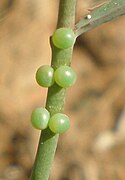 Hyles euphorbiae
Hyles euphorbiae
(Sphingidae, Macrogloss.) -
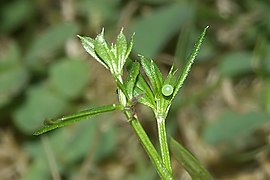 Macroglossum stellatarum
Macroglossum stellatarum
(Sphingidae, Macroglossinae) -
 Pseudosphinx tetrio
Pseudosphinx tetrio
(Sphingidae, Macroglossinae) -

-
 Marumba quercus
Marumba quercus
(Sphingidae, Smerinthinae) -
 Manduca blackburni
Manduca blackburni
(Sphingidae, Sphinginae)
Larve
-

-
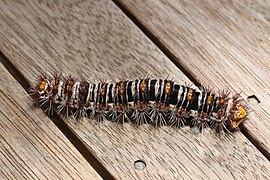 Chelepteryx collesi
Chelepteryx collesi
(Anthelidae, Anthelinae) -
 Chenuala heliaspis
Chenuala heliaspis
(Anthelidae, Anthelinae) -
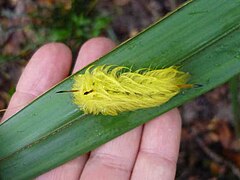 Apatelodes sp.
Apatelodes sp.
(Apatelodidae, Apatelodinae) -
 Apatelodes pudefacta
Apatelodes pudefacta
(Apatelodidae, Apatelodinae) -
 Apatelodes torrefacta
Apatelodes torrefacta
(Apatelodidae, Apatelodinae) -
 Prothysana terminalis
Prothysana terminalis
(Bombycidae) -

- Andraca theae
(Endromidae) -
 Endromis versicolora
Endromis versicolora
(Endromidae) -
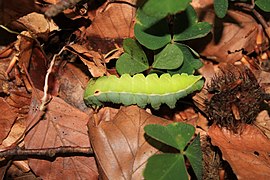
-
 Arsenura drucei
Arsenura drucei
(Saturniidae, Arsenuriinae) -
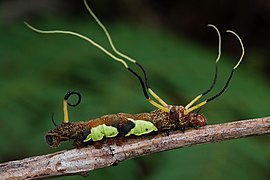 Arsenura batesii
Arsenura batesii
(Saturniidae, Arsenuriinae) -
 Anisota virginiensis
Anisota virginiensis
(Saturniidae, Ceratocampinae) -
 Citheronia splendens
Citheronia splendens
(Saturniidae, Ceratocampinae) -
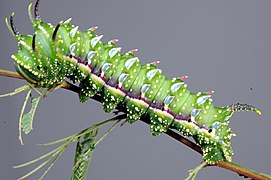 Syssphinx hubbardi
Syssphinx hubbardi
(Saturniidae, Ceratocampinae) - Automeris illustris
(Saturniidae, Hemileucinae) -
 Automeris egeus
Automeris egeus
(Saturniidae, Hemileucinae) - Leucanella leucane
(Saturniidae, Hemileucinae) -
 Actias dubernardi
Actias dubernardi
(Saturniidae, Saturniinae) -
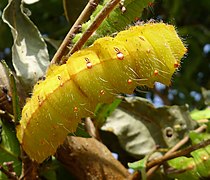 Antheraea mylitta
Antheraea mylitta
(Saturniidae, Saturniinae) -
 Graellsia isabellae
Graellsia isabellae
(Saturniidae, Saturniinae) -
-
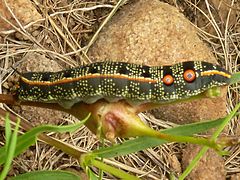 Basiothia schenki
Basiothia schenki
(Sphingidae, Macroglossinae) -
 Daphnis nerii
Daphnis nerii
(Sphingidae, Macroglossinae) - Deilephila elpenor
(Sphingidae, Macroglossinae) -
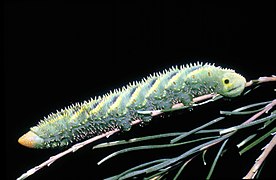 Coequosa triangularis
Coequosa triangularis
(Sphingidae, Smerinthinae) -
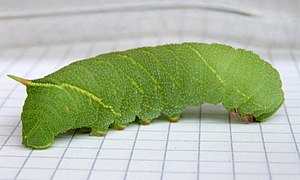 Laothoe populi
Laothoe populi
(Sphingidae, Smerinthinae) -
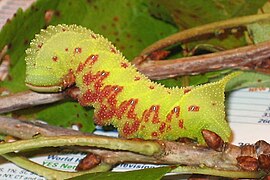 Paonias excaecatus
Paonias excaecatus
(Sphingidae, Smerinthinae) -

-
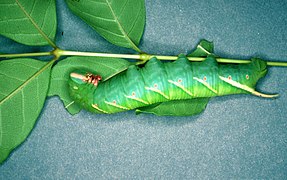 Ceratomia undulosa
Ceratomia undulosa
(Sphingidae, Sphinginae) -
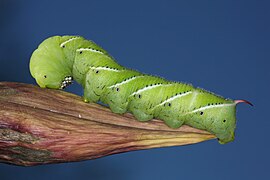 Manduca sexta
Manduca sexta
(Sphingidae, Sphinginae) -
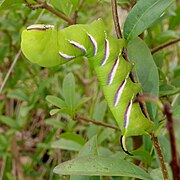 Sphinx ligustri
Sphinx ligustri
(Sphingidae, Sphinginae)
Pupe
-

- Andraca theae
(Endromidae) -
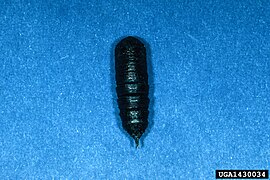 Anisota virginiensis
Anisota virginiensis
(Saturniidae, Ceratocampinae) -
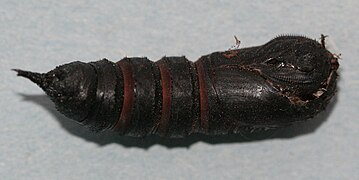 Sphingicampa bicolor
Sphingicampa bicolor
(Saturniidae, Ceratocampinae) -
 Coloradia pandora
Coloradia pandora
(Saturniidae, Hemileucinae) -
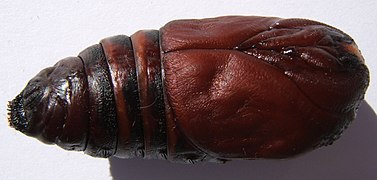 Actias selene
Actias selene
(Saturniidae, Saturniinae) -
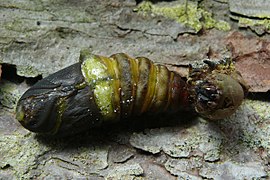 Antheraea yamamai
Antheraea yamamai
(Saturniidae, Saturniinae) -
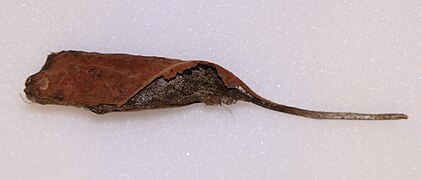 Callosamia promethea
Callosamia promethea
(Saturniidae, Saturniinae) -

-
-

-
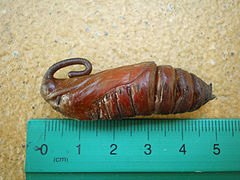 Agrius convolvuli
Agrius convolvuli
(Sphingidae, Sphinginae) -
 Manduca sexta
Manduca sexta
(Sphingidae, Sphinginae)
Conservazione
Di seguito le specie di Bombycoidea inserite nella Lista rossa IUCN, con il relativo stato di conservazione:
- Saturniidae
- Graellsia isabellae (Graëlls, 1849) - status "DD" (carente di dati)[85]
- Sphingidae
Note
- ^ a b c d e f (FR) Latreille, P. A., Histoire naturelle, générale et particulière des crustacés et des insectes: ouvrage faisant suite aux oeuvres de Leclerc de Buffon, et partie du cours complet d'histoire naturelle rédigé par C. S. Sonnini (PDF), Vol. 3, Parigi, F. Dufart, 1802 [1802-1805], pp. 400; 404, DOI:10.5962/bhl.title.15764, ISBN non esistente, OCLC 5050710. URL consultato il 15 ottobre 2017.
- ^ (EN) Nieukerken, E. J. van, Kaila, L., Kitching, I. J., Kristensen, N. P., Lees, D. C., Minet, J., Mitter, C., Mutanen, M., Regier, J. C., Simonsen, T. J., Wahlberg, N., Yen, S.-H., Zahiri, R., Adamski, D., Baixeras, J., Bartsch, D., Bengtsson, B. Å., Brown, J. W., Bucheli, S. R., Davis, D. R., De Prins, J., De Prins, W., Epstein, M. E., Gentili-Poole, P., Gielis, C., Hättenschwiler, P., Hausmann, A., Holloway, J. D., Kallies, A., Karsholt, O., Kawahara, A. Y., Koster, S. (J. C.), Kozlov, M. V., Lafontaine, J. D., Lamas, G., Landry, J.-F., Lee, S., Nuss, M., Park, K.-T., Penz, C., Rota, J., Schintlmeister, A., Schmidt, B. C., Sohn, J.-C., Solis, M. A., Tarmann, G. M., Warren, A. D., Weller, S., Yakovlev, R. V., Zolotuhin, V. V., Zwick, A., Order Lepidoptera Linnaeus, 1758. In: Zhang, Z.-Q. (Ed.) Animal biodiversity: An outline of higher-level classification and survey of taxonomic richness (PDF), in Zootaxa, vol. 3148, Auckland, Nuova Zelanda, Magnolia Press, 23 dicembre 2011, pp. 212-221, ISSN 1175-5334 (WC · ACNP), OCLC 971985940. URL consultato il 15 ottobre 2017.
- ^ a b c d e f g h i j k l m n o p q r s t u v w x (EN) Lemaire, C. & Minet, J., The Bombycoidea and their Relatives, in Kristensen, N. P. (Ed.) - Handbuch der Zoologie / Handbook of Zoology, Band 4: Arthropoda - 2. Hälfte: Insecta - Lepidoptera, moths and butterflies, Kükenthal, W. (Ed.), Fischer, M. (Scientific Ed.), Teilband/Part 35: Volume 1: Evolution, systematics, and biogeography, ristampa 2013, Berlino, New York, Walter de Gruyter, 1999 [1998], pp. 321-354, ISBN 978-3-11-015704-8, OCLC 174380917. URL consultato il 15 ottobre 2017.
- ^ a b (EN) Kitching, I. J.; Rougerie, R.; Zwick, A.; Hamilton, C. A.; St. Laurent, R. A.; Naumann, S.; Ballesteros Mejia, L.; Kawahara, A. Y., A global checklist of the Bombycoidea (Insecta: Lepidoptera) (PDF), in Biodiversity Data Journal, vol. 6, Sofia, Pensoft Publishers, 12 febbraio 2018, p. e22236, DOI:10.3897/BDJ.6.e22236, ISSN 1314-2828 (WC · ACNP), LCCN 2014243065, OCLC 967864539. URL consultato il 14 febbraio 2018.
- ^ (LA) Linnaeus, C., Systema naturae per regna tria naturae: secundum classes, ordines, genera, species, cum characteribus, differentiis, synonymis, locis (PDF), vol. 1, editio X, Holmiæ (Stoccolma), Impensis Direct. Laurentii Salvii, p. 495, DOI:10.5962/bhl.title.542, ISBN 978-0-565-00103-2, LCCN 06017147, OCLC 9402892. URL consultato il 15 ottobre 2017.
- ^ Castiglioni, L. & Mariotti, S., IL - Vocabolario della lingua latina, Brambilla, A. & Campagna, G., 30ª ristampa, Torino, Loescher, 1983 [1966], p. 146, ISBN 978-88-201-6657-1, LCCN 76485030, OCLC 848632390.
- ^ a b c d e f g h i j k l m n o p q r s t u v w x y z aa ab ac ad (EN) Scoble, M. J., Higher Ditrysia, in The Lepidoptera: Form, Function and Diversity, seconda edizione, London, Oxford University Press & Natural History Museum, 2011 [1992], pp. 328-341, ISBN 978-0-19-854952-9, LCCN 92004297, OCLC 25282932.
- ^ a b (RU) Kuznetzov, V. I. & Stekolnikov, A. A., Comparative and functional morphology of the male genitalia of the Bombycoid moths (Lepidoptera, Papilionomorpha: Lasiocampoidea, Sphingoidea, Bombycoidea) and their systematic position, in Trudy Zoologičeskogo instituta, vol. 134, Leningrado, Akademija nauk SSSR, 1985, pp. 3-48, ISSN 0206-0477 (WC · ACNP), OCLC 715330709.
- ^ (EN) Oberprieler, R. G. & Duke, N. J., The life history and immature stages of Spiramiopsis comma Hampson, 1901 (Lepidoptera: Bombycoidea), with comments on its taxonomic position and on preimaginal characters of the Bombycoidea (PDF), in Nachrichten des Entomologischen Vereins Apollo, vol. 15, n. 3, Frankfurt am Main, Entomologischer Verein Apollo, 1994, pp. 199-244, ISSN 0723-9912 (WC · ACNP), LCCN 87642423, OCLC 263606886. URL consultato il 15 ottobre 2017.
- ^ (FR) Minet, J., Nouvelles frontières, géographiques et taxonomiques, pour la famille des CaIlidulidae (Lepidoptera, Calliduloidea), in Nouvelle Revue d'Entomologie (N. S.), vol. 6, n. 4, Fontenay-sous-Bois, Association pour le soutien de la Nouvelle Revue d'Entomologie, 1990 [1989], pp. 351-368, ISSN 0374-9797 (WC · ACNP), OCLC 637361329.
- ^ (EN) Arocha-Piñango, C. L.; Layrisse, M., Fibrinolysis produced by contact with a caterpillar (abstract), in Lancet, vol. 293, n. 7599, Londra, J. Onwhyn, 19 aprile 1969, pp. 810-812, DOI:10.1016/S0140-6736(69)92070-4, ISSN 0140-6736 (WC · ACNP), LCCN sf82002015, OCLC 100769950. URL consultato il 15 ottobre 2017.
- ^ (EN) Comstock, J. A. and Dammers, C. M., Studies in the metamorphoses of six California moths, in Bulletin of the Southern California Academy of Sciences, vol. 37, Los Angeles, Ca., The Academy, 1938, pp. 105-128, ISSN 0038-3872 (WC · ACNP), LCCN 12038896, OCLC 819193693.
- ^ a b c d e f g (EN) Stehr, F. W. (Ed.), Immature Insects, Vol. 1, seconda edizione, Dubuque, Iowa, Kendall/Hunt Pub. Co., 1991 [1987], pp. 509-524, ISBN 978-0-8403-3702-3, LCCN 85081922, OCLC 13784377.
- ^ (EN) Holloway, J. D., The moths of Borneo 3. Lasiocampidae, Eupterotidae, Bombycidae, Brahmaeidae, Saturniidae, Sphingidae, Kuala Lumpur, Malayan Nature Soc., 1987, p. 199, ISBN non esistente, LCCN 94944120, OCLC 180436569. URL consultato il 15 ottobre 2017.
- ^ (EN) Brown, S. G.; Boettner, G. H. and Yack, J. E., Clicking caterpillars: acoustic aposematism in Antheraea polyphemus and other Bombycoidea (PDF), in Journal of Experimental Biology, vol. 210, n. 6, Londra, The Company of Biologists, marzo 2007, pp. 993-1005, DOI:10.1242/jeb.001990, ISSN 0022-0949 (WC · ACNP), LCCN sn94091976, OCLC 207314564, PMID 17337712. URL consultato il 15 ottobre 2017.
- ^ (EN) Franclemont, J. G., The moths of America north of Mexico, including Greenland. Fasc. 20.1, Mimallonoidea: Mimallonidae; and Bombycoidea: Apatelodidae, Bombycidae, Lasiocampidae, a cura di Richard B. Dominick, fotografie di Richard B. Dominick e Charles Edwards; disegni di Elaine R. Hodges, Londra, E.W. Classey and R.B.D. Publications, 1973, pp. 1-86 + i-viii, ISBN 978-0-900848-52-0, LCCN 86149225, OCLC 810583773.
- ^ a b c d e f (EN) Common, I. F. B., Moths of Australia, Slater, E. (fotografie), Carlton, Victoria, Melbourne University Press, 1990, pp. vi, 535, 32 con tavv. a colori, ISBN 978-0-522-84326-2, LCCN 89048654, OCLC 220444217.
- ^ (EN) Robinson, G. S.; Ackery, P. R.; Kitching, I. J.; Beccaloni, G. W. & Hernández, L. M., Bombycoidea, su HOSTS - A Database of the World's Lepidopteran Hostplants, Londra, NHM - Natural History Museum, 2010. URL consultato il 15 ottobre 2017.
- ^ (EN) Noyes, J. S.; Sadka, M., Saturniidae, su Universal Chalcidoidea Database, Londra, NHM Natural History Museum, OCLC 850942096. URL consultato il 15 ottobre 2017.
- ^ (EN) Yu, D. S., Bombycoidea, su Home of Ichneumonoidea, 28 aprile 2012. URL consultato il 15 ottobre 2017 (archiviato dall'url originale il 22 marzo 2016).
- ^ (EN) Barber, E. J. W., Prehistoric textiles: the development of cloth in the Neolithic and Bronze Ages with special reference to the Aegean, Princeton, N.J.; Chichester, Princeton University Press, 1992 [1991], pp. xxix, 471, ISBN 978-0-691-00224-8, LCCN 89010329, OCLC 972087143. URL consultato il 15 ottobre 2017.
- ^ a b Casale, A., Popolazione di Antheraea yamamai (Guér. Mén.) spontaneamente ambientata in peculiare autonomo biotopo italiano (Lép. Saturniidae), in Annali della Facoltà di scienze agrarie della Università degli studi di Torino, vol. 11, Torino, Tip. V. Bona, 1973, pp. 83-106, ISSN 0082-6871 (WC · ACNP), LCCN sn83015016, OCLC 924592380.
- ^ a b c d e f g h i j k l m n o p q r Tremblay, E., Entomologia applicata, Vol. II - Parte II, 3ª ed., Napoli, Liguori, maggio 1993 [1986], pp. 357-367, ISBN 88-207-1405-1, OCLC 886670584.
- ^ Masutti, L.; Zangheri, S., Entomologia generale e applicata, terza ristampa, Padova, CEDAM, 2015 [2001], pp. 693-694; tavv. XXI-XXII, ISBN 978-88-13-23135-4, OCLC 50064012.
- ^ (EN) Hamamoto, H.; Kamura, K.; Razanajatovo, I. M.; Murakami, K.; Santa, T.; Sekimizu, K., Effects of molecular mass and hydrophobicity on transport rates through non-specific pathways of the silkworm larva midgut (abstract), in International Journal of Antimicrobial Agents, vol. 26, n. 1, Amsterdam, Elsevier Science, luglio 2005, pp. 38-42, DOI:10.1016/j.ijantimicag.2005.03.008, ISSN 0924-8579 (WC · ACNP), LCCN sn91033487, OCLC 110578599, PMID 15963696. URL consultato il 15 ottobre 2017.
- ^ (EN) Sumida, M. & Ueda, H., Dietary sucrose suppresses midgut sucrase activity in germfree, fifth instar larvae of the silkworm, Bombyx mori (PDF), in Journal of Insect Biotechnology and Sericology, vol. 76, n. 1, Ibaraki, Japanese Society of Sericultural Science, 2007, pp. 31-37, DOI:10.11416/jibs.76.1_31, ISSN 1346-8073 (WC · ACNP), LCCN 2001220364, OCLC 5172228994. URL consultato il 15 ottobre 2017.
- ^ (DE) Butenandt, A.; Beckmann, R.; Hecker, E., On the sexattractant of silk-moths. I. The biological test and the isolation of the pure sex-attractant bombykol (abstract), in Hoppe-Seyler's Zeitschrift fur physiologische Chemie, vol. 324, Strasburgo, K.J. Trübner, 30 maggio 1961, pp. 71-83, ISSN 0018-4888 (WC · ACNP), LCCN 92643029, OCLC 104246584, PMID 13689417. URL consultato il 15 ottobre 2017.
- ^ a b Tremblay, E., Entomologia applicata, Vol. I - Generalità e mezzi di controllo, 7ª ed., Napoli, Liguori, aprile 2003 [1976], pp. 46-47, ISBN 978-88-207-0681-4, OCLC 885919158.
- ^ (EN) van Huis, A., Insects as Food in Sub-Saharan Africa (PDF), in Insect Science and Its Application, vol. 23, n. 3, Oxford; New York, Pergamon, 2003, pp. 163-185, ISSN 0191-9040 (WC · ACNP), LCCN 81642716, OCLC 211418477. URL consultato il 15 ottobre 2017.
- ^ (EN) Santos Oliveira, J. F. S.; Passos de Carvalho J.; Bruno de Sousa, R. F. X. and Madalena Simão, M., The nutritional value of four species of insects consumed in Angola (PDF), in Ecology of food and nutrition, vol. 5, n. 5, New York, Gordon and Breach, gennaio 1976, pp. 91-97, DOI:10.1080/03670244.1976.9990450, ISSN 0367-0244 (WC · ACNP), LCCN 72620981, OCLC 4659924219. URL consultato il 15 ottobre 2017.
- ^ (EN) Robinson, G. S.; Ackery, P. R.; Kitching, I. J.; Beccaloni, G. W. & Hernández, L. M., Manduca sexta, su HOSTS - A Database of the World's Lepidopteran Hostplants, Londra, NHM - Natural History Museum, 2010. URL consultato il 15 ottobre 2017.
- ^ (DE) Harbich, H., Zur Biologie von Acherontia atropos, in Entomologische Zeitschrift, vol. 91, Stoccarda, Eugen Ulmer, 1981, pp. 57-62, ISSN 0013-8843 (WC · ACNP), OCLC 476153593.
- ^ Marini, M., Agrius convolvuli L., in Natura e Montagna, vol. 31, n. 1, Bologna, Accademia Nazionale di agricoltura, 1984, ISSN 0028-0658 (WC · ACNP), OCLC 859657906.
- ^ Vessia, R., Contributo alla conoscenza della Celerio lineata Fabr. var. livornica Esp., in Annali della sperimentazione agraria, vol. 12, Roma, Libreria internazionale Trèves-Treccani-Tumminelli, 1958, pp. 65-96, ISSN 0365-642X (WC · ACNP), OCLC 1481345.
- ^ Jannone, G., Un lepidottero migratore sviluppatosi a danno del corbezzolo (arbutus unedo L.) nell'Appennino Ligure: Celerio lineata livornica Esp. (Sphingidae) e discussione sull'origine del fenomeno (abstract), in Annali della sperimentazione agraria, vol. 18, Roma, Libreria internazionale Trèves-Treccani-Tumminelli, 1964, pp. 279-330, ISSN 0365-642X (WC · ACNP), LCCN 91648678, OCLC 1481345. URL consultato il 15 ottobre 2017.
- ^ (DE) Heinig, S., Ein Beitrag zur Biologie von Macroglossum stellatarum (Lep.:Sphingidae), in Entomologische Zeitschrift, vol. 91, Frankfurt a.M., Internationaler Entomologischer Verein, 1981, pp. 177-188, ISSN 0013-8843 (WC · ACNP), LCCN 58041251, OCLC 476153593.
- ^ (DE) Skatulla, U., Sphingidae, in Schwenke, W. (a cura di), Die Forstschädlinge Europas: ein Handbuch in fünf Bänden, Vol. 3 - Schmetterlinge, Amburgo, P. Parey, 1978, pp. 445-449, ISBN 978-3-490-11316-0, OCLC 925703232.
- ^ Vassura, G., Comparsa in Emilia del "Baco da seta" dell'ailanto (abstract), in Informatore fitopatologico, vol. 4, Bologna, Gruppo Calderini Edagricola, 1954, pp. 5-7, ISSN 0020-0735 (WC · ACNP), OCLC 782313306. URL consultato il 15 ottobre 2017.
- ^ Martelli, G., Brevi notizie sulla Saturnia pavonia (PDF), in Bollettino del Laboratorio di zoologia generale e agraria della R. Scuola superiore d'agricoltura in Portici, vol. 5, Portici, E. Della Torre, 1911, pp. 209-213, LCCN sn86022807, OCLC 8367051. URL consultato il 15 ottobre 2017.
- ^ (DE) De Freina, J., Über die Berechtigung von Unterarten Des Wiener Nachtspfaunenauges, Saturnia pyri in Kleinasien, in Entomologische Zeitschrift, vol. 91, n. 3, Stoccarda, Eugen Ulmer, 1981, pp. 17-24, ISSN 0013-8843 (WC · ACNP), LCCN 58041251, OCLC 476153593.
- ^ a b Hartig, F., Per la prima volta una Bramaea [sic] in Europa, in Bollettino dell'Associazione Romana di Entomologia, vol. 18, n. 1, Roma, L'Associazione, 1963, pp. 5-7, ISSN 0004-6000 (WC · ACNP), LCCN 11734986, OCLC 476589029.
- ^ a b c (FR) Rougeot, P. C., Les Bombycoïdes (Lepidoptera-Bombycoïdea) de L’Europe et du Bassin Méditerranéen, collana Faune de L’Europe et du Bassin Méditerranéen 5, Tome 1. Lemoniidae, Bombcidae, Brahmaeidae, Attacidae, Endromididae, Parigi, Masson et Cie, Editeurs, 1971, p. 159, ISBN non esistente, OCLC 604081162.
- ^ a b Parenzan, P., Contributi alla conoscenza della Lepidotterofauna dell'Italia meridionale IV. Heterocera (Bombyces et Sphinges) di Puglia e Lucania (PDF), in Entomologica, vol. 13, Bari, Istituto di entomologia agraria, 1977, pp. 183-245, ISSN 0425-1016 (WC · ACNP), LCCN 88652450, OCLC 476912425. URL consultato il 15 ottobre 2017.
- ^ a b (EN) Mosconi, F.; Zilli, A.; Spicciarelli, R.; Maurizi, E.; Vigna Taglianti, A.; Audisio, P., An overview on the most outstanding Italian endemic moth, Brahmaea (Acanthobrahmaea) europaea (Lepidoptera: Brahmaeidae) (PDF), in Fragmenta entomologica, vol. 46, n. 1-2, Roma, Istituto nazionale di entomologia, 31 ottobre 2014, pp. 1-9, DOI:10.4081/fe.2014.70, ISSN 0429-288X (WC · ACNP), LCCN sn86013030, OCLC 5845914182. URL consultato il 15 ottobre 2017.
- ^ Della Beffa, G., Gli Insetti dannosi all'agricoltura ed i moderni metodi e mezzi di lotta - corredato dagli indici dei nomi latini ed italiani dei gruppi e delle specie e da un indice delle piante e dei loro prodotti con l'elenco dei relativi parassiti, 3ª ed., Milano, Ulrico Hoepli, 1961, pp. xx, 1106, 8 tavv., ISBN non esistente, OCLC 878459264. URL consultato il 15 ottobre 2017.
- ^ a b (EN) Turner, A. J., A Classification of the Australian Lymantriadae (PDF), in Transactions of the Entomological Society of London, vol. 1904, Londra, The Society, 1904, pp. 470 (chiave); 478, DOI:10.1111/j.1365-2311.1904.tb02751.x, ISSN 2053-2520 (WC · ACNP), LCCN sn88024445, OCLC 220279251. URL consultato il 15 ottobre 2017.
- ^ (EN) Common, I. F. B. & McFarland, N., A new subfamily for Munychryia Walker and Gephyroneura Turner (Lepidoptera: Anthelidae) and the description of a new species from western Australia (PDF), in Journal of the Australian Entomological Society, vol. 9, n. 1, Brisbane, The Society, aprile 1970, p. 11, ISSN 0004-9050 (WC · ACNP), LCCN 76646181, OCLC 4660271339. URL consultato il 15 ottobre 2017.
- ^ a b (EN) Neumoegen, B. & Dyar, H. G., Preliminary Revision of the Bombyces of America North of Mexico (Continued) (PDF), in Journal of the New York Entomological Society, vol. 2, n. 3, Lawrence, Kan., Allen Press, 1º settembre 1894, pp. 112 (chiave); 174, ISSN 0028-7199 (WC · ACNP), LCCN unk82052895, OCLC 5553435221. URL consultato il 15 ottobre 2017.
- ^ (EN) McDunnough, J., Check List of the Lepidoptera of Canada and the United States of America - Part 1. Macrolepidoptera (PDF), in Memoirs of the Southern California Academy of Sciences, vol. 1, Los Angeles, Ca, The Academy, 15 giugno 1938, p. 138, ISSN 0097-2622 (WC · ACNP), LCCN sf89010465, OCLC 68470835. URL consultato il 15 ottobre 2017.
- ^ (DE) Draudt, M. & Schauss, W., in Seitz, A. - Die gross-schmetterlinge der erde: Eine systematische bearbeitung der bis jetzt bekannten gross-schmetterlinge. In verbindung mit namhaftesten ten fachmännern, Vol. 6, Stoccarda, 1940 [1929], p. 675, ISBN non esistente, LCCN sv89027820, OCLC 833078625.
- ^ a b c (EN) Swinhoe, C., Catalogue of eastern and Australian Lepidoptera Heterocera in the collection of the Oxford University Museum (PDF), Part I. Sphinges and Bombyces, Oxford, Clarendon Press, 1892, pp. 253; 271, ISBN non esistente, OCLC 18581192. URL consultato il 15 ottobre 2017.
- ^ (EN) Hampson, G. F., Some small families of the Lepidoptera which are not included in the key to the families in the Catalogue of Lepidoptera Phalaenae, a list of the families and subfamilies of the Lepidoptera with their types and a key to the families (PDF), in Novitates Zoologicae, vol. 25, Londra, Order of the Trustees, British museum (Natural history), 1918, p. 367, DOI:10.5962/bhl.part.29772, ISSN 0950-7655 (WC · ACNP), LCCN 44016969, OCLC 5974844732. URL consultato il 15 ottobre 2017.
- ^ (EN) Hampson, G. F., IX. A Classification of a new Family of the Lepidoptera (PDF), in Transactions of the Entomological Society of London, vol. 1901, n. 2, Londra, The Society, luglio 1901, p. 187, DOI:10.1111/j.1365-2311.1901.tb02384.x, ISSN 0035-8894 (WC · ACNP), LCCN sn88024445, OCLC 5156751431. URL consultato il 15 ottobre 2017.
- ^ (EN) Common, I. F. B., A new family of Bombycoidea (Lepidoptera) based on Carthaea Saturnioides Walker from western Australia (PDF), in Australian Journal of Entomology, vol. 5, n. 1, Brisbane, Watson Ferguson and Co., aprile 1966, p. 29, DOI:10.1111/j.1440-6055.1966.tb00673.x, ISSN 0004-9050 (WC · ACNP), LCCN 76646181, OCLC 5153668301. URL consultato il 15 ottobre 2017.
- ^ (LA) Boisduval, J.-B. A. D., Europæorum Lepidopterorum index methodicus (PDF), Pars prima, Sistens genera Papilio, Sphinx, Bombyx et Noctua Lin., Parigi, Méquignon-Marvis, 1828, p. 50, ISBN non esistente, LCCN 34036664, OCLC 166313927. URL consultato il 15 ottobre 2017.
- ^ (RU) Kozlov, M. V., The morphology, biology and systematic position of Mirina christophi Stgr. (Lepidoptera: Bombycoidea, Endromididae), in Vestnik Leningradskij Gosudarstvennyj Universitet Serija 3, Biologija, vol. 1985, n. 4, Leningrado, Izd. Leningradskogo Univ., 1985, p. 3, ISSN 0321-186X (WC · ACNP), LCCN 88656539, OCLC 263608331.
- ^ a b c d (EN) Forbes, W. T. M., The subdivision of the Eupterotidae (Lepidoptera) (PDF), in Tijdschrift voor entomologie, vol. 98, Amsterdam, Nederlandse Entomologische Vereniging, 1955, pp. 98; 120, ISSN 0040-7496 (WC · ACNP), LCCN 03016134, OCLC 636770272. URL consultato il 15 ottobre 2017.
- ^ (EN) Aurivillius, P. O. C., On the ethiopian genera of the family Striphnopterygidae (PDF), collana Bihang till Kongl. Svenska vetenskaps-akademiens handlingar, 27(2), Stoccolma, P. A. Norstedt & Söner, 1902, p. 4 (chiave), ISBN non esistente, OCLC 250149911. URL consultato il 15 ottobre 2017.
- ^ (FR) Berger, L. A., Clé pour la détermination des familles de Macrolépidoptères et des groupes supérieurs de Microlépidoptères, in Lambillionea, vol. 57, n. 9-10, Bruxelles, Union des entomologistes belges, 1958, p. 73, ISSN 0774-2819 (WC · ACNP), OCLC 693631565. URL consultato il 15 ottobre 2017.
- ^ (LA, SV) Wallengren, H. D. J., Nya Fjäril-slägten (PDF), in Öfversigt af Kongl. Vetenskaps-akademiens forhandlingar, vol. 15, Stoccolma, P. A. Norstedt & Söner, 14 aprile 1858, p. 210, ISSN 1100-4622 (WC · ACNP), LCCN 05015471, OCLC 6303212. URL consultato il 15 ottobre 2017.
- ^ (LA, SV) Wallengren, H. D. J., Heterocer-fjärilar, samlade i Kafferlandet af J.A. Wahlberg / beskrifna af H.D.J. Wallengren (PDF), Wahlberg, J. A., Stoccolma, P.A. Norstedt & Söner, 1865, p. 33, DOI:10.5962/bhl.title.13861, ISBN non esistente, OCLC 757715374. URL consultato il 15 ottobre 2017.
- ^ (EN) Minet, J., The Bombycoidea: Phylogeny and higher classification (Lepidoptera: Glossata) (abstract), in Insect Systematics & Evolution, vol. 25, n. 1, Stenstrup, Danimarca, Apollo Books, gennaio 1994, p. 63, DOI:10.1163/187631294X00045, ISSN 1399-560X (WC · ACNP), LCCN 00252879, OCLC 4637513943. URL consultato il 15 ottobre 2017.
- ^ a b (FR) Boisduval, J.-B., Icones historiques des Lépidoptères nouveaux ou peu connus. Collection, avec figures coloriées, des Papillons d'Europe nouvellement découverts; ouvrage formant le complénent de tous les Auteurs iconographes. (PDF), Tome II: Hétérocères, Parigi, Roret, 1834, p. 170, ISBN non esistente, OCLC 715038200. URL consultato il 15 ottobre 2017.
- ^ (EN) Packard, A. S., XXIII. - Aglia tau, a connecting-link between the Ceratocampidæ and Saturniidæ, and the Type of a new Subfamily, Agliinæ (PDF), in The Annals and magazine of natural history; zoology, botany, and geology being a continuation of the Annals combined with Loudon and Charlesworth's Magazine of Natural History, (6) 11, Londra, Taylor & Francis, Ltd., 1893, p. 172, ISSN 0374-5481 (WC · ACNP), LCCN 68007383, OCLC 77582346. URL consultato il 15 ottobre 2017.
- ^ (EN) Jordan, H. E. K., A monograph of the saturnian subfamily Ludiinae (PDF), in Novitates zoologicae, vol. 29, Londra, British Museum (Natural History), 1922, p. 250, ISSN 0007-1498 (WC · ACNP), LCCN 58020574, OCLC 220753644. URL consultato il 15 ottobre 2017.
- ^ (FR) Bouvier, E. L., Des Saturnioides du Hill Museum, in The Bulletin of the Hill Museum; a Magazine of Lepidopterology, vol. 4, Londra, Witley, Surrey, 1930, p. 3, LCCN unk81021149, OCLC 183218609. URL consultato il 15 ottobre 2017.
- ^ (EN) Harris, T. W., A report on the insects of Massachusetts, injurious to vegetation. Published agreeably to an order of the Legislature, by the Commissioners on the Zoological and Botanical Survey of the State (PDF), Ann Arbor, Mich., University Microfilms Int'l., 1841, p. 287, DOI:10.5962/bhl.title.6091, ISBN non esistente, OCLC 499479147. URL consultato il 15 ottobre 2017.
- ^ (FR) Boisduval, J.-B. A. D., Note sur la tribu des Adélocépiialides (PDF), in Annales de la Société entomologique de Belgique, vol. 15, Bruxelles, Société entomologique de Belgique, 1872, p. 79, LCCN ca07006786, OCLC 18759618. URL consultato il 15 ottobre 2017.
- ^ a b (EN) Grote, A. R. & Robinson, C. T., Lepidopterological Contributions (PDF), in Annals of the Lyceum of Natural History of New York, vol. 8, New York, The Lyceum, 1866, pp. 376; 379, ISSN 0890-6564 (WC · ACNP), LCCN 12020407, OCLC 806276092. URL consultato il 15 ottobre 2017.
- ^ (EN) Packard, A. S., On the Larval Forms of Several Exotic Ceratocampid Moths (PDF), in Psyche, vol. 9, Cambridge, Mass., Cambridge Entomological Club, 1901, p. 280, DOI:10.1155/1901/249259, ISSN 0033-2615 (WC · ACNP), LCCN sf80000609, OCLC 80777056. URL consultato il 15 ottobre 2017.
- ^ a b (EN) Packard, A. S., The Bombycine Moths of North America, Part III (PDF), in Memoirs of the National Academy of Sciences, vol. 12, Washington, D.C., U.S. G.P.O., 1914, pp. 1; 144, ISSN 0885-4637 (WC · ACNP), LCCN sn85005194, OCLC 1759015. URL consultato il 15 ottobre 2017.
- ^ a b (EN) Jordan, H. E. K., On the Saturnoidean families Oxytenidae and Cercophanidae (PDF), in Novitates zoologicae, vol. 31, Londra, British Museum (Natural History), 1924, pp. 135; 181, ISSN 0007-1498 (WC · ACNP), LCCN 58020574, OCLC 716818676. URL consultato il 15 ottobre 2017.
- ^ (DE) Grote, A. R., Die Saturniiden : (Nachtpfauenaugen), collana Mittheilungen aus dem Roemer-Museum, Hildesheim, Vol. 8, Hildesheim, Lax, 1896, pp. 3; 27, ISBN non esistente, OCLC 246985314. URL consultato il 15 ottobre 2017.
- ^ a b c (FR) Burmeister, C. H. C., Description physique de la République Argentine: d'après des observations personnelles et étrangères par H. Burmeister (PDF), Maupas, E. (traduzione), T. 5 Lépidoptères Pt. 1 Les diurnes, crépusculaires et bombycoïdes, Parigi, F. Savey, 1878, pp. 314 (chiave); 473, DOI:10.5962/bhl.title.2494, ISBN non esistente, OCLC 257437204. URL consultato il 15 ottobre 2017.
- ^ (EN) Michener, C. D., Parallelisms in the evolution of saturniid moths (PDF), in Evolution (Lancaster), vol. 3, n. 2, Lancaster, PA., Society for the Study of Evolution, giugno 1949, p. 130, DOI:10.1111/j.1558-5646.1949.tb00012.x, ISSN 0014-3820 (WC · ACNP), LCCN 51004882, OCLC 5550300998. URL consultato il 15 ottobre 2017.
- ^ (FR) Duponchel, P. A. J., Catalogue méthodique des lépidoptères d'Europe distribués en familles, tribus et genres, avecl'exposé des caractères sur lesquels ces divisions sont fondées, et l'indication des lieux et de s époques où l'on trouve chaque espèce, pour servir de complément et de rectification à l'histoire naturelle des lépidoptères de France, devenue celle des lépidoptères d'Europe par les supplémens qu'on y a ajoutés (PDF), Parigi, Méquignon-Marvis fils, 1844, p. 78, DOI:10.5962/bhl.title.9476, ISBN non esistente, LCCN agr03000154, OCLC 469667096. URL consultato il 15 ottobre 2017.
- ^ (EN) Cooper, M. R., Note on classification, in Cooper, M. R. & Cooper, M. D., The emperor moths of KwaZulu-Natal, collana Ihlathi series, Pietermaritzburg, Sudafrica, Peroniceras Press, 2002, pp. x-xvi, ISBN 978-0-620-29623-6, OCLC 54554869. URL consultato il 15 ottobre 2017.
- ^ (DE) Aurivillius, P. O. C., Beiträge zur Kenntnis der Insektenfauna von Kamerun. N:o 11. Lepidoptera Heterocera (PDF), in Arkiv för zoologi, vol. 2, n. 4, Uppsala e Stoccolma, Almqvist-Wuksell, 1904, p. 21, ISSN 0004-2110 (WC · ACNP), LCCN 05015471, OCLC 1514177. URL consultato il 15 ottobre 2017.
- ^ (EN) Tutt, J. W., A natural history of the British Lepidoptera: a text-book for students and collectors (PDF), vol. 4, Londra / Berlino, Swan Sonnenschein & Company / Friedländer & Sohn, aprile 1904, p. 504, DOI:10.5962/bhl.title.59327, ISBN non esistente, LCCN tmp96006451, OCLC 928871725. URL consultato il 15 ottobre 2017.
- ^ (EN) Harris, T. W., Descriptive Catalogue of the North American Insects belonging to the Linnæan Genus Sphinx in the Cabinet of Thaddeus William Harris, M. D., Librarian of Harvard University (PDF), in The American journal of science and arts, vol. 36, New Haven, Conn, S. Converse, 1839, p. 287, ISSN 0002-9599 (WC · ACNP), LCCN 86655213, OCLC 861074457. URL consultato il 15 ottobre 2017.
- ^ a b (EN) Grote, A. R. & Robinson, C. T., A synonymical catalogue of North American Sphingidae, with notes and descriptions (PDF), in Memoir of the Entomological Society of Philadelphia, vol. 5, Philadelphia, Entomological Society, 1865, pp. 153; 160, LCCN 2011250668, OCLC 60884963. URL consultato il 15 ottobre 2017.
- ^ a b (EN) Rothschild, W. & Jordan, H. E. K., A revision of the Lepidopterous family Sphingidae (PDF), in Novitate zoologicae, 9 (Supplemento), Londra, Hazell, Watson and Viney, 1903, p. cxxxv, ISSN 0950-7655 (WC · ACNP), LCCN 44016969, OCLC 833893262. URL consultato il 15 ottobre 2017.
- ^ a b (EN) Butler, A. G., Revision of the Heterocerous Lepidoptera of the family Sphingidae (PDF), in Transactions of the Zoological Society of London, vol. 9, n. 19, Londra, Academic Press, 1876, pp. 514; 515, ISSN 0084-5620 (WC · ACNP), LCCN 85640142, OCLC 181154809. URL consultato il 15 ottobre 2017.
- ^ a b (EN) Heikkilä, M., Mutanen, M., Wahlberg, N., Sihvonen, P., Kaila, L., Elusive ditrysian phylogeny: an account of combining systematized morphology with molecular data (Lepidoptera) (PDF), in BMC Evolutionary Biology, vol. 15, n. 1, Londra, BioMed Central, 21 novembre 2015, p. 260, DOI:10.1186/s12862-015-0520-0, ISSN 1471-2148 (WC · ACNP), LCCN 2002243069, OCLC 944275977, PMID 26589618. URL consultato il 15 ottobre 2017.
- ^ (EN) World Conservation Monitoring Centre, Graellsia isabellae, su IUCN red list of threatened species, Cambridge, International Union for Conservation of Nature and Natural Resources - IUCN Global Species Programme Red List Unit, 1º agosto 1996, DOI:10.2305/IUCN.UK.1996.RLTS.T9427A12986143.en, ISSN 2307-8235 (WC · ACNP), OCLC 943528404. URL consultato il 15 ottobre 2017.
- ^ (EN) World Conservation Monitoring Centre, Euproserpinus wiesti, su IUCN red list of threatened species, Cambridge, International Union for Conservation of Nature and Natural Resources - IUCN Global Species Programme Red List Unit, 1º agosto 1996, DOI:10.2305/IUCN.UK.1996.RLTS.T8373A12908327.en, ISSN 2307-8235 (WC · ACNP), OCLC 943528404. URL consultato il 15 ottobre 2017.
- ^ (EN) World Conservation Monitoring Centre, Hyles hippophaes, su IUCN red list of threatened species, Cambridge, International Union for Conservation of Nature and Natural Resources - IUCN Global Species Programme Red List Unit, 1º agosto 1996, DOI:10.2305/IUCN.UK.1996.RLTS.T10542A3198676.en, ISSN 2307-8235 (WC · ACNP), OCLC 943528404. URL consultato il 15 ottobre 2017.
- ^ (EN) World Conservation Monitoring Centre, Proserpinus proserpina, su IUCN red list of threatened species, Cambridge, International Union for Conservation of Nature and Natural Resources - IUCN Global Species Programme Red List Unit, 1º agosto 1996, DOI:10.2305/IUCN.UK.1996.RLTS.T18366A8153516.en, ISSN 2307-8235 (WC · ACNP), OCLC 943528404. URL consultato il 15 ottobre 2017.
- ^ (EN) Heddle, M.L., Tinostoma smaragditis, su IUCN red list of threatened species, Cambridge, International Union for Conservation of Nature and Natural Resources - IUCN Global Species Programme Red List Unit, 30 aprile 2004, DOI:10.2305/IUCN.UK.2004.RLTS.T21913A9339981.en, ISSN 2307-8235 (WC · ACNP), OCLC 943528404. URL consultato il 15 ottobre 2017.
Bibliografia
Pubblicazioni
- (EN) Aiello, A. & Balcazar Lara, M. A., The Immature Stages of Oxytenis Modestia, with Comments on the Larvae of Asthenidia and Homoeopteryx (Saturniidae: Oxyteninae) (PDF), in Journal of the Lepidopterists' Society, vol. 51, n. 2, New Haven, Conn., The Society, 1997, pp. 105-118, ISSN 0024-0966 (WC · ACNP), LCCN 56023725, OCLC 197109092.
- (EN) Arocha-Piñango, C. L.; Layrisse, M., Fibrinolysis produced by contact with a caterpillar (abstract), in Lancet, vol. 293, n. 7599, Londra, J. Onwhyn, 19 aprile 1969, pp. 810-812, DOI:10.1016/S0140-6736(69)92070-4, ISSN 0140-6736 (WC · ACNP), LCCN sf82002015, OCLC 100769950.
- (DE) Aurivillius, P. O. C., Beiträge zur Kenntnis der Insektenfauna von Kamerun. N:o 11. Lepidoptera Heterocera (PDF), in Arkiv för zoologi, vol. 2, n. 4, Uppsala e Stoccolma, Almqvist-Wuksell, 1904, pp. 1-68, ISSN 0004-2110 (WC · ACNP), LCCN 05015471, OCLC 1514177.
- (FR) Berger, L. A., Clé pour la détermination des familles de Macrolépidoptères et des groupes supérieurs de Microlépidoptères, in Lambillionea, vol. 57, n. 9-10, Bruxelles, Union des entomologistes belges, 1958, pp. 72-84, ISSN 0774-2819 (WC · ACNP), OCLC 693631565.
- (DE) Bilek A., Die Raupe von Brahmaea europaea Hartig 1963, und deren Aufzucht aus dem Ei, in Bollettino dell’Associazione Romana di Entomologia, vol. 20, n. 1, Roma, L'Associazione, 1965, pp. 5-8, ISSN 0004-6000 (WC · ACNP), LCCN 11734986, OCLC 715981693.
- (DE) Bilek A., Das Ergebnis meiner Zucht von Acanthobrahmaea europaea Hartig 1963. Ein Beitrag zur Variationsbreite dieser Art. (Lep. Brahmaeidae), in Zeitschrift der Wiener entomologischen Gesellschaft, vol. 52, Vienna, Wiener Entomologische Gesellschaft, 1967, pp. 88-90, OCLC 17915918.
- (FR) Boisduval, J.-B. A. D., Note sur la tribu des Adélocépiialides (PDF), in Annales de la Société entomologique de Belgique, vol. 15, Bruxelles, Société entomologique de Belgique, 1872, pp. 79-96, LCCN ca07006786, OCLC 18759618.
- (FR) Bouvier, E. L., Des Saturnioides du Hill Museum, in The Bulletin of the Hill Museum; a Magazine of Lepidopterology, vol. 4, Londra, Witley, Surrey, 1930, LCCN unk81021149, OCLC 183218609.
- (EN) Brock, J. P., A contribution towards an understanding of the morphology and phylogeny of the Ditrysian Lepidoptera (abstract), in Journal of natural history, vol. 5, n. 1, Londra, Taylor & Francis, 1º febbraio 1971, pp. 29-102, DOI:10.1080/00222937100770031, ISSN 0022-2933 (WC · ACNP), LCCN 68007383, OCLC 6894673384.
- (EN) Brock, J. P., Pupal protrusion in some bombycoid moths, in Entomologist's Gazette, vol. 41, Faringdon, E.W. Classey, 1990, pp. 91-98, ISSN 0013-8894 (WC · ACNP), LCCN sf93093861, OCLC 704023603.
- (EN) Brown, S. G.; Boettner, G. H. and Yack, J. E., Clicking caterpillars: acoustic aposematism in Antheraea polyphemus and other Bombycoidea (PDF), in Journal of Experimental Biology, vol. 210, n. 6, Londra, The Company of Biologists, marzo 2007, pp. 993-1005, DOI:10.1242/jeb.001990, ISSN 0022-0949 (WC · ACNP), LCCN sn94091976, OCLC 207314564, PMID 17337712.
- (DE) Butenandt, A.; Beckmann, R.; Hecker, E., On the sexattractant of silk-moths. I. The biological test and the isolation of the pure sex-attractant bombykol (abstract), in Hoppe-Seyler's Zeitschrift fur physiologische Chemie, vol. 324, Strasburgo, K.J. Trübner, 30 maggio 1961, pp. 71-83, ISSN 0018-4888 (WC · ACNP), LCCN 92643029, OCLC 104246584, PMID 13689417.
- (EN) Butler, A. G., Revision of the heterocerous Lepidoptera of the family Sphingidae (PDF), in Transactions of the Zoological Society of London, vol. 9, n. 19, Londra, Longmans, Green, Reader and Dyer, 1876, pp. 511-644, tavv. 90-94, DOI:10.1111/j.1096-3642.1876.tb00236.x, ISSN 0084-5620 (WC · ACNP), LCCN 85640142, OCLC 181154809.
- (EN) Cardoso, L. W.; Mielke, C. G. C.; Duarte, M., Morphology of the egg and larva of a poorly known hawkmoth: Subsidies for a better understanding of the systematics of Ambulycini (Lepidoptera: Sphingidae, Smerinthinae) (PDF), in Zoologischer Anzeiger - A Journal of Comparative Zoology, vol. 266, New York, Elsevier, gennaio 2017, pp. 14-22, DOI:10.1016/j.jcz.2016.10.003, ISSN 0044-5231 (WC · ACNP), LCCN sn94094829, OCLC 6963872495.
- (EN) Carolin, V. M., Jr., Extended diapause in Coloradia pandora Blake (Lepidoptera: Saturniidae) (PDF), in The Pan-Pacific entomologist, vol. 47, n. 1, San Francisco, Ca., Pacific Coast Entomological Society, gennaio 1971, pp. 19-23, ISSN 0031-0603 (WC · ACNP), LCCN 34041370, OCLC 819189661.
- Casale, A., Popolazione di Antheraea yamamai (Guér. Mén.) spontaneamente ambientata in peculiare autonomo biotopo italiano (Lép. Saturniidae), in Annali della Facoltà di scienze agrarie della Università degli studi di Torino, vol. 11, Torino, Tip. V. Bona, 1973, pp. 83-106, ISSN 0082-6871 (WC · ACNP), LCCN sn83015016, OCLC 924592380.
- (EN) Chu, H. F.; Wang, L. Y., The Brahmaeidae of China (Lepidoptera) (abstract), in Acta entomologica Sinica / Kun chong xue bao, vol. 20, n. 1, Pechino, Ke xue chu ban she, 1977, pp. 83-84, ISSN 0454-6296 (WC · ACNP), LCCN 83642875, OCLC 976956908.
- (EN) Common, I. F. B., A new family of Bombycoidea (Lepidoptera) based on Carthaea Saturnioides Walker from western Australia (PDF), in Australian Journal of Entomology, vol. 5, n. 1, Brisbane, Watson Ferguson and Co., aprile 1966, pp. 29-36, DOI:10.1111/j.1440-6055.1966.tb00673.x, ISSN 0004-9050 (WC · ACNP), LCCN 76646181, OCLC 5153668301.
- (EN) Common, I. F. B. & McFarland, N., A new subfamily for Munychryia Walker and Gephyroneura Turner (Lepidoptera: Anthelidae) and the description of a new species from western Australia (PDF), in Journal of the Australian Entomological Society, vol. 9, n. 1, Brisbane, The Society, aprile 1970, pp. 11-22, ISSN 0004-9050 (WC · ACNP), LCCN 76646181, OCLC 4660271339.
- (EN) Common, I. F. B. & Edwards, E. D., The early stages of Gastridiota adoxima (Turner) (Lepidoptera: Bombycoidea) and its family placement (PDF), in Australian Journal of Entomology, vol. 30, n. 2, Brisbane, Australian Entomological Society, maggio 1991, pp. 187-192, DOI:10.1111/j.1440-6055.1991.tb00410.x, ISSN 1326-6756 (WC · ACNP), LCCN 76646181, OCLC 5153645056.
- (EN) Comstock, J. A. and Dammers, C. M., Studies in the metamorphoses of six California moths, in Bulletin of the Southern California Academy of Sciences, vol. 37, Los Angeles, Ca., The Academy, 1938, pp. 105-128, ISSN 0038-3872 (WC · ACNP), LCCN 12038896, OCLC 819193693.
- (FR) Dall'Asta, U. & Ponein, G., Nouvelles espèces des genres Stenoglene Felder et Epijana Holland de l'Afrique Centrale (Eupterotidae, Lepidoptera), in Revue de zoologie africaine, vol. 94, n. 2, Tervuren, Belgio, P. Basilewsky, 1980, pp. 457-488, ISSN 0251-074X (WC · ACNP), LCCN 83642706, OCLC 567801470.
- (DE) De Freina, J. J., Über die Berechtigung von Unterarten Des Wiener Nachtspfaunenauges, Saturnia pyri in Kleinasien, in Entomologische Zeitschrift, vol. 91, n. 3, Stoccarda, Eugen Ulmer, 1981, pp. 17-24, ISSN 0013-8843 (WC · ACNP), LCCN 58041251, OCLC 476153593.
- (DE) De Freina, J. J., Eine neue Population von Brahmaea ledereri Rogenhofer, 1873, (Brahmaea ledereri zaba ssp. n.) in Turkisch-Kurdistan, sowie Nachweis der Konspezifitat von Brahmaea ledereri Rogenhofer, 1873, und Brahmaea christophi Staudinger, 1879 (Lepidoptera, Brahmaeidae) (PDF), in Entomofauna, vol. 3, n. 9, Linz, Maximilian Schwarz, 1982, pp. 129-139, ISSN 0250-4413 (WC · ACNP), OCLC 27362713.
- (DE) De Freina, J. J., Neue Kenntnisse über die Biologie und Systematik von Brahmaea ledereri Rogenhofer, 1873 und deren Verbreitung in Kleinasien (Lep. Brahmaeidae) (PDF), in Mitteilungen der Münchner entomologischen Gesellschaft, vol. 74, Monaco, Münchner Entomologische Gesellschaft, 1985, pp. 77-90, ISSN 0340-4943 (WC · ACNP), LCCN 45049341, OCLC 457010191.
- (RU) Derzhavets, Yu. A., An account of the classification of the sphinx moths (Lepidoptera, Sphingidae) with a list of species of the fauna of the USSR, in entomologicheskoe obozrenie, vol. 63, n. 3, Mosca, Izdatelstvo Akademii Nauk SSSR, 1984, pp. 604-620, ISSN 0367-1445 (WC · ACNP), LCCN 54045655, OCLC 611231348.
- (EN) Dickens, J. C. & Eaton, J. L., External ocelli in Lepidoptera previously considered to be anocellate (abstract), in Nature, vol. 242, n. 5394, Londra, Macmillan Journals Ltd., 16 marzo 1973, pp. 205-206, DOI:10.1038/242205a0, ISSN 0028-0836 (WC · ACNP), LCCN 12037118, OCLC 4652530425.
- (DE) Dierl, W., Revision der orientalischen Bombycidae (Lepidoptera). Teil I: Die Ocinara-Gruppe (PDF), in Spixiana, vol. 1, n. 3, Monaco, Zoologische Staatssammlung München, 1978, pp. 225-268, ISSN 0341-8391 (WC · ACNP), LCCN 84650021, OCLC 276360291.
- (DE) Dierl, W., Revision der orientalischen Bombycidae (Lepidoptera). Teil II: Ergànzungen zur Ocinara-Gruppe (PDF), in Spixiana, vol. 2, n. 3, Monaco, Zoologische Staatssammlung München, 1979, pp. 253-258, ISSN 0341-8391 (WC · ACNP), LCCN 84650021, OCLC 276360291.
- (FR) Dognin, P., Hetérocères nouveaux de l'Amérique du Sud (PDF), in Mémoires de la société royale d'entomologie de Belgique, vol. 22, Bruxelles, La Société, 1913, pp. 1-54, DOI:10.5962/bhl.title.10597, ISSN 0376-2025 (WC · ACNP), OCLC 220203368.
- (PT) Duarte, A. C.; Caovilla, J.; Lorini, I.; Lorini, D.; Mantovani, G.; Sumida, J.; Manfre, P. C.; Silveira, R. de C.; Moura, S. P. de., Insuficiència renal aguda por acidentes com lagartas (abstract), in Jornal Brasileiro de Nefrologia, vol. 12, n. 4, São Paolo, Sociedade Brasileira de Nefrologia, 1990, pp. 184-187, ISSN 2175-8239 (WC · ACNP), OCLC 709987938.
- (FR) Dufay, C., L'éthologie d'Acanthobrahmaea europaea (Hartig), in Alexanor, vol. 6, n. 6, Parigi, P. Andre, 1970, pp. 249-260, ISSN 0002-5208 (WC · ACNP), OCLC 3739431.
- (EN) Forbes, W. T. M., A structural study of some caterpillars. II - The Sphingidae (PDF), in Annals of the Entomological Society of America, vol. 4, College Park, Md., The Society, 1911, pp. 261-279, DOI:10.1093/aesa/4.3.261, ISSN 0013-8746 (WC · ACNP), LCCN 08018807, OCLC 5722255782.
- (EN) Forbes, W. T. M., The Lepidoptera of New York and neighboring states, I: Primitive forms, Microlepidoptera, Pyraloids, Bombyces (PDF), in Memoir by Cornell University Agricultural Experiment Station, vol. 68, Ithaca, N.Y., Cornell University, 1923, pp. 1-729, ISSN 0096-7254 (WC · ACNP), LCCN 55017828, OCLC 1385161.
- (EN) Forbes, W. T. M., The Lepidoptera of Barro Colorado Island, Panama (N° 2), in Bulletin of the Museum of Comparative Zoology, vol. 90, n. 2, Cambridge, Mass., The Museum, 1942, pp. 265-406 + 8 pls., OCLC 746261461.
- (EN) Forbes, W. T. M., The Lepidoptera of New York and neighboring states, II: Geometridae, Notodontidae, Sphingidae, Lymantriidae, in Memoir by Cornell University Agricultural Experiment Station, vol. 274, Ithaca, N.Y., Cornell University, 1948, p. 263, ISSN 0096-7254 (WC · ACNP), LCCN 55017828, OCLC 679942627.
- (EN) Forbes, W. T. M., The subdivision of the Eupterotidae (Lepidoptera) (PDF), in Tijdschrift voor entomologie, vol. 98, Amsterdam, Nederlandse Entomologische Vereniging, 1955, pp. 85-132, ISSN 0040-7496 (WC · ACNP), LCCN 03016134, OCLC 636770272.
- (DE) Graeser, L., Beiträge zur Kenntniss der Lepidopteren‐Fauna des Amurlandes (PDF), in Berliner entomologische Zeitschrift, vol. 32, n. 1, Berlino, Nicolai'sche Verlags-Buchhandlung, 1888, pp. 33-153, DOI:10.1002/mmnd.18920370208, ISSN 0323-6145 (WC · ACNP), LCCN 14006507, OCLC 5155105297.
- (EN) Grote, A. R. & Robinson, C. T., A synonymical catalogue of North American Sphingidae, with notes and descriptions (PDF), in Memoir of the Entomological Society of Philadelphia, vol. 5, Philadelphia, Entomological Society, 1865, pp. 149-193, LCCN 2011250668, OCLC 60884963.
- (EN) Grote, A. R. & Robinson, C. T., Lepidopterological Contributions (PDF), in Annals of the Lyceum of Natural History of New York, vol. 8, New York, The Lyceum, 1866, pp. 351-387, ISSN 0890-6564 (WC · ACNP), LCCN 12020407, OCLC 806276092.
- (EN) Hamamoto, H.; Kamura, K.; Razanajatovo, I. M.; Murakami, K.; Santa, T.; Sekimizu, K., Effects of molecular mass and hydrophobicity on transport rates through non-specific pathways of the silkworm larva midgut (abstract), in International Journal of Antimicrobial Agents, vol. 26, n. 1, Amsterdam, Elsevier Science, luglio 2005, pp. 38-42, DOI:10.1016/j.ijantimicag.2005.03.008, ISSN 0924-8579 (WC · ACNP), LCCN sn91033487, OCLC 110578599, PMID 15963696.
- (EN) Hampson, G. F., IX. A Classification of a new Family of the Lepidoptera (PDF), in Transactions of the Entomological Society of London, vol. 1901, n. 2, Londra, The Society, luglio 1901, pp. 187-192, DOI:10.1111/j.1365-2311.1901.tb02384.x, ISSN 0035-8894 (WC · ACNP), LCCN sn88024445, OCLC 5156751431.
- (EN) Hampson, G. F., Some small families of the Lepidoptera which are not included in the key to the families in the Catalogue of Lepidoptera Phalaenae, a list of the families and subfamilies of the Lepidoptera with their types and a key to the families (PDF), in Novitates Zoologicae, vol. 25, Londra, Order of the Trustees, British museum (Natural history), 1918, pp. 366-394, DOI:10.5962/bhl.part.29772, ISSN 0950-7655 (WC · ACNP), LCCN 44016969, OCLC 5974844732.
- (ZH) Hao, H. L.; Zhang, X. R.; Yang, J. K., Two new species of Brahmaeidae from China (Lepidoptera: Brahmaeidae) (abstract), in Kun chong xue bao = Acta entomologica Sinica, 45 (Suppl.), Pechino, Ke xue chu ban she, 2002, pp. 53-55, ISSN 0454-6296 (WC · ACNP), LCCN 83642875, OCLC 108607118. URL consultato il 15 ottobre 2017 (archiviato dall'url originale il 15 ottobre 2017).
- (DE) Harbich, H., Zur Biologie von Acherontia atropos, in Entomologische Zeitschrift, vol. 91, Stoccarda, Eugen Ulmer, 1981, pp. 57-62, ISSN 0013-8843 (WC · ACNP), OCLC 476153593.
- (EN) Harris, T. W., Descriptive Catalogue of the North American Insects belonging to the Linnæan Genus Sphinx in the Cabinet of Thaddeus William Harris, M. D., Librarian of Harvard University (PDF), in The American journal of science and arts, vol. 36, New Haven, Conn, S. Converse, 1839, pp. 282-319, ISSN 0002-9599 (WC · ACNP), LCCN 86655213, OCLC 861074457.
- Hartig, F., Per la prima volta una Bramaea [sic] in Europa, in Bollettino dell'Associazione Romana di Entomologia, vol. 18, n. 1, Roma, L'Associazione, 1963, pp. 5-7, ISSN 0004-6000 (WC · ACNP), LCCN 11734986, OCLC 476589029.
- (DE) Hartig, F., Auf Brahmaea-Fang in der Basilicata (Lep. Bombycidae) (abstract), in Nachrichtenblatt der Bayerischen Entomologen, vol. 15, n. 11/12, Monaco, Münchner Entomologische Ges., 1966, pp. 102-105, ISSN 0027-7452 (WC · ACNP), LCCN sv86015913, OCLC 767791634.
- (FR) Haxaire, J. & Rasplus, J.-Y., Contribution à la connaissance des Sphingidae de Guyane Française. 1re partie [Lep.] (PDF), in Bulletin de la Société entomologique de France, vol. 91, n. 9-10, Parigi, La Société, 1987a [1986], pp. 275-285, ISSN 0151-0517 (WC · ACNP), LCCN sn94086710, OCLC 30986595.
- (FR) Haxaire, J. & Rasplus, J.-Y., Contribution à la connaissance des Sphingidae de Guyane Française. 2e partie [Lep.] (PDF), in Bulletin de la Société entomologique de France, vol. 92, n. 1-2, Parigi, La Société, 1987b, pp. 45-55, ISSN 0151-0517 (WC · ACNP), LCCN sn94086710, OCLC 30986595.
- (EN) Heikkilä, M., Mutanen, M., Wahlberg, N., Sihvonen, P., Kaila, L., Elusive ditrysian phylogeny: an account of combining systematized morphology with molecular data (Lepidoptera) (PDF), in BMC Evolutionary Biology, vol. 15, n. 1, Londra, BioMed Central, 21 novembre 2015, p. 260, DOI:10.1186/s12862-015-0520-0, ISSN 1471-2148 (WC · ACNP), LCCN 2002243069, OCLC 944275977, PMID 26589618.
- (DE) Heinig, S., Ein Beitrag zur Biologie von Macroglossum stellatarum (Lep.:Sphingidae), in Entomologische Zeitschrift, vol. 91, Frankfurt a.M., Internationaler Entomologischer Verein, 1981, pp. 177-188, ISSN 0013-8843 (WC · ACNP), LCCN 58041251, OCLC 476153593.
- (EN) Heitzman, R., The life history of Adelocephala quadrilineata (Saturniidae) (PDF), in Journal of the Lepidopterists' Society, vol. 15, n. 4, Los Angeles, Ca., The Society, 1961, pp. 233-234, ISSN 0024-0966 (WC · ACNP), LCCN 56023725, OCLC 921224986.
- (EN) Heppner, J. B., Brachyptery and aptery in Lepidoptera (PDF), in Tropical Lepidoptera, vol. 2, n. 1, Gainesville, FL, Association for Tropical Lepidoptera, 1991, pp. 11-40, ISSN 1048-8138 (WC · ACNP), LCCN 95648009, OCLC 21067139.
- (EN) Hogue, C. L.; Sala, F. P.; McFarland, N. and Henne, C., Systematics and life history of Saturnia (Calosaturnia) albofasciata in California (Saturniidae) (PDF), in Journal of Research on the Lepidoptera, vol. 4, n. 3, Arcadia, Ca., Lepidoptera Research Foundation, 1965, pp. 173-184, ISSN 0022-4324 (WC · ACNP), LCCN 2010202002, OCLC 709958147.
- (EN) Horn, D. J., A larva of Citheronia sepulchralis (sic) from New Jersey, in Journal of the Lepidopterists' Society, vol. 23, New Haven, Conn., The Society, 1969, p. 25, ISSN 0024-0966 (WC · ACNP), LCCN 56023725, OCLC 162327014.
- Jannone, G., Un lepidottero migratore sviluppatosi a danno del corbezzolo (arbutus unedo L.) nell'Appennino Ligure: Celerio lineata livornica Esp. (Sphingidae) e discussione sull'origine del fenomeno (abstract), in Annali della sperimentazione agraria, vol. 18, Roma, Libreria internazionale Trèves-Treccani-Tumminelli, 1964, pp. 279-330, ISSN 0365-642X (WC · ACNP), LCCN 91648678, OCLC 1481345.
- (ES) Janzen, D. H., Guia para la identificacion de mariposas nocturnas de la familia Saturniidae del Parque Nacional Santa Rosa, Guanacaste, Costa Rica, in Brenesia, vol. 19/20, San José, Museo Nacional de Costa Rica - Departamento de historia natural, 1982, pp. 255-299, ISSN 0304-3711 (WC · ACNP), LCCN 74642604, OCLC 860434881.
- (EN) Janzen, D. H., Natural history of Hylesia lineata (Saturniidae, Hemileucinae) in Santa Rosa National Park, Costa Rica (abstract), in Journal of the Kansas Entomological Society, vol. 57, n. 3, Manhattan, Kan., The Society, luglio 1984, pp. 290-514, ISSN 0022-8567 (WC · ACNP), LCCN 68001331, OCLC 5550857947.
- (EN) Jordan, H. E. K., On an organ peculiar to the females of some genera of Ludiinae, a subfamily of Saturniidae (PDF), in Novitates Zoologicae, vol. 29, Londra, British Museum (Natural History), 1922a, pp. 247-248, ISSN 0007-1498 (WC · ACNP), LCCN 58020574, OCLC 220753644.
- (EN) Jordan, H. E. K., A monograph of the saturnian subfamily Ludiinae (PDF), in Novitates zoologicae, vol. 29, Londra, British Museum (Natural History), 1922b, pp. 249-326, ISSN 0007-1498 (WC · ACNP), LCCN 58020574, OCLC 220753644.
- (EN) Jordan, H. E. K., A note on the families of moths in which R2 (= vein 5) of the forewing arises from near the centre or from above the centre of the cell (PDF), in Novitates zoologicae, vol. 30, Londra, British Museum (Natural History), 1923, pp. 163-166 + l pl., ISSN 0007-1498 (WC · ACNP), LCCN 58020574, OCLC 220753644.
- (EN) Jordan, H. E. K., On the Saturnoidean families Oxytenidae and Cercophanidae (PDF), in Novitates zoologicae, vol. 31, Londra, British Museum (Natural History), 1924, pp. 135-193, ISSN 0007-1498 (WC · ACNP), LCCN 58020574, OCLC 716818676.
- (DE) Jörgensen, P., Lepidopterologisches aus Südamerika, in Deutsche entomologische Zeitschrift Iris, vol. 46, Dresda, R. Friedländer, 1932, pp. 37-66, LCCN 11012199, OCLC 1695863.
- (EN) Kendall, R. O., Larval Food Plants and Life History Notes for Eight Months from Texas and Mexico, in Journal of the Lepidopterists' Society, vol. 30, n. 4, New Haven, Conn., The Society, 1976, pp. 264-271, ISSN 0024-0966 (WC · ACNP), LCCN 56023725, OCLC 191710163.
- (EN) Kimball, C. P., Arthropods of Florida and neighboring land areas - 1. Lepidoptera of Florida, an annotated checklist (PDF), in Contributions (Bureau of Entomology), Gainesville, FL, Florida Department of Agriculture and Consumer Services. Division of Plant Industry, 1965, pp. v+363, ISSN 0066-8036 (WC · ACNP), LCCN 65029777, OCLC 807281676.
- (JA) Kishida, Y., Bombycidae. In Haruta, T. (ed.). Moths of Nepal 1: 80-81 + 1 pl., in Tinea, 13 (Suppl. 2), Tokyo, 1992, pp. i-xvii + 1-122 + 32 pls., ISSN 0493-3168 (WC · ACNP), OCLC 5172525682.
- (JA) Kishida, Y., Bombycidae. In Haruta, T. (ed.). Moths of Nepa1 2: 143-145 + 1 pl., in Tinea, 13 (Suppl. 3), Tokyo, 1993, pp. i-xv + 1-160 + 32 pls., ISSN 0493-3168 (WC · ACNP), OCLC 5172525685.
- (JA) Kishida, Y., Eupterotidae. In Haruta, T. (ed.). Moths of Nepal 3: 64-65 + 2 pls., in Tinea, 14 (Suppl. 1), Tokyo, 1994, pp. i-xvii + l-m + 32 pls., ISSN 0493-3168 (WC · ACNP), OCLC 5172526017.
- (EN) Kitching, I. J.; Rougerie, R.; Zwick, A.; Hamilton, C. A.; St. Laurent, R. A.; Naumann, S.; Ballesteros Mejia, L.; Kawahara, A. Y., A global checklist of the Bombycoidea (Insecta: Lepidoptera) (PDF), in Biodiversity Data Journal, vol. 6, Sofia, Pensoft Publishers, 12 febbraio 2018, p. e22236, DOI:10.3897/BDJ.6.e22236, ISSN 1314-2828 (WC · ACNP), LCCN 2014243065, OCLC 967864539.
- (DE) Korb, M., Brahmaea christophi Stgr. (PDF), in Deutsche entomologische Zeitschrift Iris, vol. 12, Berlino, R. Friedländer, 1899, pp. 168-170, LCCN 11012199, OCLC 1695863.
- (RU) Kozlov, M. V., The morphology, biology and systematic position of Mirina christophi Stgr. (Lepidoptera: Bombycoidea, Endromididae), in Vestnik Leningradskij Gosudarstvennyj Universitet Serija 3, Biologija, vol. 1985, n. 4, Leningrado, Izd. Leningradskogo Univ., 1985, pp. 3-9, ISSN 0321-186X (WC · ACNP), LCCN 88656539, OCLC 263608331.
- (RU) Kuznetzov, V. I. & Stekolnikov, A. A., Comparative and functional morphology of the male genitalia of the Bombycoid moths (Lepidoptera, Papilionomorpha: Lasiocampoidea, Sphingoidea, Bombycoidea) and their systematic position, in Trudy Zoologičeskogo instituta, vol. 134, Leningrado, Akademija nauk SSSR, 1985, pp. 3-48, ISSN 0206-0477 (WC · ACNP), OCLC 715330709.
- (DE) Lampe, R. E. J. & Nässig, W. A., Neue Erkenntnisse über die Gattung Lemaireia: 1. Beschreibung der Präimaginalstadien von L. luteopeplus aureopeplus Nässig & Holloway (Lepidoptera, Saturniidae) (PDF), in Nachrichten des Entomologischen Vereins Apollo, vol. 10, n. 3, Francoforte sul Meno, Entomologischer Verein Apollo, 1989, pp. 225-238, ISSN 0723-9912 (WC · ACNP), LCCN 87642423, OCLC 722062108.
- (FR) Lamy, M. & Lemaire, C., Contribution à la systématique des Hylesia (Lep. Saturniidae) : étude au microscope électronique à balayage des « fléchettes » urticantes, in Bulletin de la Société entomologique de France, vol. 88, n. 3-4, Parigi, La Société, 1983, pp. 176-192, ISSN 0037-928X (WC · ACNP), LCCN 94086710 sn 94086710, OCLC 487862927.
- (FR) Lemaire, C., Un cas de parthénogenèse chez les Lépidoptères Attacidae: Goodia kuntzei (Dewitz), in Alexanor, vol. 6, n. 1, Parigi, P. Andre, 1969, pp. 47-48, ISSN 0002-5208 (WC · ACNP), OCLC 263597277.
- (FR) Lemaire, C., Révision du genre Automeris Hübner et des genres voisins : Biogéographie, éthologie, morphologie, taxonomie. (Lep. Attacidae), in Mémoires du Muséum national d'histoire naturelle. N.S. Sér. A, 68; 79; 92, Parigi, Editions du Muséum, 1971-1974, pp. 68 (1971): 1-232; 79 (1973): 233-422; 92 (1974): 423-576, ISSN 0078-9747 (WC · ACNP), LCCN 61032053, OCLC 610741070.
- (FR) Lemaire, C., Révision du genre Lonomia Walker (Lep. Attacidae), in Annales de la Société entomologique de France: international journal of entomology. Nouvelle série: revue internationale d'entomologie, vol. 8, Parigi, Masson, 1972, pp. 767-861, ISSN 2168-6351 (WC · ACNP), LCCN 2012200144, OCLC 888453275.
- (ZH) Li, K. H. K., Observations on the life histories of Sataspes infernails and Sataspes tagalica (Lepidoptera : Sphingidae) in Hong Kong (PDF), in Lepidoptera Science, vol. 45, n. 3, Ōsaka, Nihon Rinshi Gakkai, ottobre 1994, pp. 125-144, DOI:10.18984/lepid.45.3_125, ISSN 0024-0974 (WC · ACNP), LCCN 79640633, OCLC 741725064.
- (EN) Lin, C. S., Sphingid Moths and their Larval Food Plants in Taiwan, in Journal of Taiwan Museum, vol. 40, n. 2, Taipei, Taiwan, The Museum, 1987, pp. 101-120, ISSN 0256-257X (WC · ACNP), LCCN 2001220052, OCLC 10256497.
- (EN) Madden, A. H., The external morphology of the adult tobacco hornworm, (Lepidoptera: Sphingidae) (abstract), in Annals of the Entomological Society of America, vol. 37, n. 2, Lanham, Md., ESA, giugno 1944, pp. 145-160, DOI:10.1093/aesa/37.2.145, ISSN 1938-2901 (WC · ACNP), LCCN 08018807, OCLC 163365380.
- Marini, M., Agrius convolvuli L., in Natura e Montagna, vol. 31, n. 1, Bologna, Accademia Nazionale di agricoltura, 1984, ISSN 0028-0658 (WC · ACNP), OCLC 859657906.
- Martelli, G., Brevi notizie sulla Saturnia pavonia (PDF), in Bollettino del Laboratorio di zoologia generale e agraria della R. Scuola superiore d'agricoltura in Portici, vol. 5, Portici, E. Della Torre, 1911, pp. 209-213, LCCN sn86022807, OCLC 8367051.
- (EN) McDunnough, J., Check List of the Lepidoptera of Canada and the United States of America - Part 1. Macrolepidoptera (PDF), in Memoirs of the Southern California Academy of Sciences, vol. 1, Los Angeles, Ca, The Academy, 15 giugno 1938, pp. 1-272, ISSN 0097-2622 (WC · ACNP), LCCN sf89010465, OCLC 68470835.
- (EN) Michener, C. D., Parallelisms in the evolution of saturniid moths (PDF), in Evolution (Lancaster), vol. 3, n. 2, Lancaster, PA., Society for the Study of Evolution, giugno 1949, pp. 129-141, DOI:10.1111/j.1558-5646.1949.tb00012.x, ISSN 0014-3820 (WC · ACNP), LCCN 51004882, OCLC 5550300998.
- (EN) Michener, C. D., The Saturniidae (Lepidoptera) of the Western Hemisphere. Morphology, phylogeny, and classification (PDF), in Bulletin of the American Museum of Natural History, vol. 98, n. 5, New York, The Museum, 1952, pp. 335-501 + l pl., OCLC 316251730.
- (FR) Minet, J., Ébauche d'une classification moderne de l'ordre des Lépidoptères, in Alexanor, vol. 14, n. 7, Parigi, P. André, 1986, pp. 291-313, ISSN 0002-5208 (WC · ACNP), OCLC 3739431.
- (FR) Minet, J., Nouvelles frontières, géographiques et taxonomiques, pour la famille des Callidulidae (Lepidoptera, Calliduloidea), in Nouvelle Revue d'Entomologie (N. S.), vol. 6, n. 4, Fontenay-sous-Bois, Association pour le soutien de la Nouvelle Revue d'Entomologie, 1990 [1989], pp. 351-368, ISSN 0374-9797 (WC · ACNP), OCLC 637361329.
- (EN) Minet, J., Tentative reconstruction of the ditrysian phylogeny (Lepidoptera: Glossata) (abstract), in Entomologica scandinavica, vol. 22, n. 1, Stenstrup, Danimarca, Apollo Books, 1991, pp. 69-95, DOI:10.1163/187631291X00327, ISSN 1399-560X (WC · ACNP), LCCN 70020995, OCLC 5672447005.
- (EN) Minet, J., The Bombycoidea: phylogeny and higher classification (Lepidoptera: Glossata) (abstract), in Insect Systematics & Evolution, vol. 25, n. 1, Stenstrup, Apollo Books, gennaio 1994, pp. 63-88, DOI:10.1163/187631294x00045, ISSN 1399-560X (WC · ACNP), LCCN 00252879, OCLC 4637513943.
- (JA) Miyata, T., A generic revision of the Japanese Bombycidae, with description of a new genus (Lepidoptera), in Tinea, vol. 8, n. 1, Tokyo, Nihon Garui Gakkai, 1970, pp. 190-199 + 5 pls., ISSN 0493-3168 (WC · ACNP), OCLC 10730819.
- (EN) Mosconi, F.; Zilli, A.; Spicciarelli, R.; Maurizi, E.; Vigna Taglianti, A.; Audisio, P., An overview on the most outstanding Italian endemic moth, Brahmaea (Acanthobrahmaea) europaea (Lepidoptera: Brahmaeidae) (PDF), in Fragmenta entomologica, vol. 46, n. 1-2, Roma, Istituto nazionale di entomologia, 31 ottobre 2014, pp. 1-9, DOI:10.4081/fe.2014.70, ISSN 0429-288X (WC · ACNP), LCCN sn86013030, OCLC 5845914182.
- (EN) Mosher E., A Classification of the Lepidoptera Based on Characters of the Pupa (PDF), in Bulletin of the Illinois State Laboratory of Natural History, vol. 1912, n. 2, Urbana, Illinois, Illinois State Laboratory of Natural History, marzo 1916, pp. 17-159 + 27 pls., DOI:10.5962/bhl.title.70830, ISSN 0073-5272 (WC · ACNP), LCCN 16027309, OCLC 2295354.
- (EN) Mosher, E., Pupæ of Common Sphingidæ of Eastern North America (PDF), in Annals of the Entomological Society of America, vol. 11, n. 4, College Park, Md., The Society, 1918, pp. 403-442, ISSN 0013-8746 (WC · ACNP), LCCN 08018807, OCLC 5722322502.
- (EN) Moss, A. M., Sphingidae of Para, Brazil: early stages, food-plants, habits etc. (PDF), in Novitate Zoologicae, vol. 27, n. 2, Londra, Order of the Trustees, British Museum (Natural history), novembre 1920, pp. 333-424 + 11 pls., LCCN 44016969, OCLC 228173728.
- (EN) Nakamura, M., Some problems on the classification of moth based on the pupal characters, in Garui tsushin = The Japan heterocerists journal, vol. 60, Tokyo, Japan Heterocerists' Society, 1970, pp. 710-714, ISSN 0286-3537 (WC · ACNP), OCLC 72897796.
- (EN) Nakamura, M., Supplement to the pupae of Japanese Sphingidae (Lepidoptera), in New Entomologist, vol. 26, n. 1-2, Ueda, Matsumoto, 1977, pp. 1-14, ISSN 0028-4955 (WC · ACNP), LCCN sv88074101, OCLC 263459937.
- (EN) Narang, R. C., Gupta, M. L., The chromosomes of a wild silkmoth, Archaeoattacus edwardsii, with a record high chromosome number for Saturniidae (PDF), in Journal of the Lepidopterists’ Society, vol. 36, n. 2, New Haven, Conn., The Society, 1982, pp. 112-118, ISSN 0024-0966 (WC · ACNP), LCCN 56023725, OCLC 191710163.
- (DE) Nässig, W. A., Ein Beitrag zur Kenntnis der Saturniidae und Brahmaeidae des Iran und der Türkei, Teil 1: Brahmaeidae (PDF), in Nachrichten des Entomologischen Vereins Apollo (N.F.), vol. 1, n. 3/4, Francoforte sul Meno, Entomologischer Verein Apollo, dicembre 1980, pp. 77-91, ISSN 0723-9912 (WC · ACNP), LCCN 87642423, OCLC 722062108.
- (DE) Nässig, W. A., Ein Beitrag zur Kenntnis der Saturniidae und der Brahmaeidae des Iran und der Türkei (Lepidoptera), Teil 2: Saturniidae (PDF), in Nachrichten des Entomologischen Vereins Apollo (N.F.), vol. 2, n. 1, Francoforte sul Meno, Entomologischer Verein Apollo, marzo 1981, pp. 1-39, ISSN 0723-9912 (WC · ACNP), LCCN 87642423, OCLC 722062108.
- (DE) Nässig, W. A., Zur Praimaginalmorphologie von Saturnia (Rinaca) zuleika und S. (R.) thibeta sowie Anmerkungen zu den Salassinae (Lepidoptera: Saturniidae), in Nachrichten des Entomologischen Vereins Apollo (N.F.), vol. 15, n. 3, Francoforte sul Meno, Entomologischer Verein Apollo, 1994, pp. 409-438, ISSN 0723-9912 (WC · ACNP), LCCN 87642423, OCLC 722062108.
- (DE) Nässig, W. A. & Czipka, H., Beobachtungen an Endromis versicolora (Linnaeus 1758): E. versicolora eichleri Alberti 1975 neu für die Türkei (Lepidoptera: Endromididae), in Nachrichten des Entomologischen Vereins Apollo (N.F.), vol. 15, n. 3, Francoforte sul Meno, Entomologischer Verein Apollo, 1994, pp. 183-197, ISSN 0723-9912 (WC · ACNP), LCCN 87642423, OCLC 722062108.
- (DE) Nässig, W. A., Czipka, H. & Paukstadt, U., The Brahmaeidae of Sumatra, in Heterocera Sumatrana, vol. 6, Londra, E.W. Classey, 1990, pp. 117-136, ISSN 0724-1348 (WC · ACNP), OCLC 214555561.
- (EN) Nässig, W. A., Naumann S., Saturniidae and Brahmaeidae of the Palaearctic Region: how many species are there? (PDF), in Entomologica Romanica, vol. 15, Cluj-Napoca, Romania, Cluj University Press, 2010, pp. 17-20, ISSN 1224-2594 (WC · ACNP), OCLC 652165115. URL consultato il 15 ottobre 2017 (archiviato dall'url originale il 4 marzo 2016).
- (EN) Nässig, W. A., Nye I. W. B., Brahmaea Walker, 1855 (Insecta, Lepidoptera): proposed confirmation of Bombyx certhia Fabricius, 1793 as the type species. [Case 2737] (PDF), in Bulletin of zoological Nomenclature, vol. 48, n. 2, Londra, International Commission of Zoological Nomenclature, 1991, pp. 137-139, ISSN 0007-5167 (WC · ACNP), LCCN 52031665, OCLC 5974859188.
- (EN) Nässig, W. A., Treadaway C. G., The Brahmaeidae (Lepidoptera) of the Philippines (PDF), in Nachrichten des entomologischen Vereins Apollo, Suppl. 17, Francoforte sul Meno, Entomologischer Verein Apollo, 1998, pp. 425-440, ISSN 0723-9912 (WC · ACNP), LCCN 87642423, OCLC 722062108.
- (DE) Naumann, S., Brosch, U., Zur Verbreitung der hearseyi-Gruppe (Lepidoptera: Brahmaeidae: Brahmaea Walker, 1855) in Indonesien und auf den Philippinen (PDF), in Galathea, Berichte des Kreises Nürnberger Entomologen, vol. 21, n. 2, Nürnberg, Kreis Nürnberger Entomologen, 2005, pp. 97-104, ISSN 1430-1164 (WC · ACNP), OCLC 73475997.
- (EN) Nentwig, W., A tropical caterpillar that mimics faeces, leaves and a snake (Lepidoptera: Oxytenidae: Oxytenis naemia) (PDF), in Journal of research on the lepidoptera, vol. 24, n. 2, Arcadia, Calif., Lepidoptera Research Foundation, 1985, pp. 136-141, ISSN 0022-4324 (WC · ACNP), LCCN 2010202002, OCLC 709958147.
- (EN) Neumoegen, B. & Dyar, H. G., Preliminary Revision of the Bombyces of America North of Mexico (Continued) (PDF), in Journal of the New York Entomological Society, vol. 2, n. 3, Lawrence, Kan., Allen Press, 1º settembre 1894, pp. 109-132, ISSN 0028-7199 (WC · ACNP), LCCN unk82052895, OCLC 5553435221.
- (EN) Newman, E., I. Notice of a Sackbearing Bombyx, found by Mr. Bates near Santarem, in the Amazons (PDF), in Transactions of the Royal Entomological Society of London, (2nd S.) 3, n. 1, Londra, The Society, 3 aprile 1854, pp. 1-8, ISSN 0035-8894 (WC · ACNP), LCCN sn88024447, OCLC 5156772733.
- (FR) Niculescu, E. V., Sur les caractères morphologiques utilisés dans la taxonomie et la classification des lépidoptères, in SHILAP Revista de Lepidopterología, vol. 17, n. 65, 1989, pp. 95-108, ISSN 0300-5267 (WC · ACNP), OCLC 162248980.
- (EN) Nieukerken, E. J. van, Kaila, L., Kitching, I. J., Kristensen, N. P., Lees, D. C., Minet, J., Mitter, C., Mutanen, M., Regier, J. C., Simonsen, T. J., Wahlberg, N., Yen, S.-H., Zahiri, R., Adamski, D., Baixeras, J., Bartsch, D., Bengtsson, B. Å., Brown, J. W., Bucheli, S. R., Davis, D. R., De Prins, J., De Prins, W., Epstein, M. E., Gentili-Poole, P., Gielis, C., Hättenschwiler, P., Hausmann, A., Holloway, J. D., Kallies, A., Karsholt, O., Kawahara, A. Y., Koster, S. (J. C.), Kozlov, M. V., Lafontaine, J. D., Lamas, G., Landry, J.-F., Lee, S., Nuss, M., Park, K.-T., Penz, C., Rota, J., Schintlmeister, A., Schmidt, B. C., Sohn, J.-C., Solis, M. A., Tarmann, G. M., Warren, A. D., Weller, S., Yakovlev, R. V., Zolotuhin, V. V., Zwick, A., Order Lepidoptera Linnaeus, 1758. In: Zhang, Z.-Q. (Ed.) Animal biodiversity: An outline of higher-level classification and survey of taxonomic richness (PDF), in Zootaxa, vol. 3148, Auckland, Nuova Zelanda, Magnolia Press, 23 dicembre 2011, pp. 212-221, ISSN 1175-5334 (WC · ACNP), OCLC 971985940.
- (EN) Nirazawa, T.; Fujii, T.; Seki, Y.; Namiki, S.; Kazawa, T.; Kanzaki, R.; Ishikawa, Y., Morphology and physiology of antennal lobe projection neurons in the hawkmoth Agrius convolvuli (abstract), in Journal of insect physiology, vol. 98, Londra; New York, Pergamon Press, aprile 2017, pp. 214-222, DOI:10.1016/j.jinsphys.2017.01.010, ISSN 0022-1910 (WC · ACNP), LCCN 57003860, OCLC 6932066478, PMID 28118991.
- (EN) Ntelezos, A.; Guarato, F. and Windmill, J. F. C., The Anti-bat Strategy of Ultrasound Absorption: The Wings of Nocturnal Moths (Bombycoidea: Saturniidae) Absorb More Ultrasound than the Wings of Diurnal Moths (Chalcosiinae: Zygaenoidea: Zygaenidae) (PDF), in Biology Open, vol. 6, n. 1, Cambridge, The Company of Biologists, 15 gennaio 2017, pp. 109-117, DOI:10.1242/bio.021782, ISSN 2046-6390 (WC · ACNP), OCLC 6889730402, PMC 5278430, PMID 27913454.
- (DE) Oberprieler, R. G. & Nässig, W. A., Tarn- oder Warntrachten - ein Vergleich larvaler und imaginaler Strategien bei Saturniinen (Lepidoptera: Saturniidae) (PDF), in Nachrichten des entomologischen Vereins Apollo (N. F.), vol. 15, n. 3, Francoforte sul Meno, Entomologischer Verein Apollo, 1994, pp. 267-303, ISSN 0723-9912 (WC · ACNP), LCCN 87642423, OCLC 722062108.
- (JA) Okada, M., Morphological studies of moth eggs. III. Langia zenzeroides nawai Rothschild & Jordan (Sphingidae) and Brahmaea wallichii japonica Butler (Brahmaeidae), in Garui tsushin = The Japan Heterocerists Journal, vol. 51, Tokyo, Japan Heterocerists' Society, 1968, pp. 552-554, ISSN 0286-3537 (WC · ACNP), OCLC 72897796.
- (EN) Packard, A. S., XXIII. - Aglia tau, a connecting-link between the Ceratocampidæ and Saturniidæ, and the Type of a new Subfamily, Agliinæ (PDF), in The Annals and magazine of natural history; zoology, botany, and geology being a continuation of the Annals combined with Loudon and Charlesworth's Magazine of Natural History, (6) 11, Londra, Taylor & Francis, Ltd., 1893, pp. 172-175, ISSN 0374-5481 (WC · ACNP), LCCN 68007383, OCLC 77582346.
- (EN) Packard, A. S., On the Larval Forms of Several Exotic Ceratocampid Moths (PDF), in Psyche, vol. 9, Cambridge, Mass., Cambridge Entomological Club, 1901, pp. 279-282, DOI:10.1155/1901/249259, ISSN 0033-2615 (WC · ACNP), LCCN sf80000609, OCLC 80777056.
- (EN) Packard, A. S., The Bombycine Moths of North America, Part III (PDF), in Memoirs of the National Academy of Sciences, vol. 12, Washington, D.C., U.S. G.P.O., 1914, pp. 1-516, ISSN 0885-4637 (WC · ACNP), LCCN sn85005194, OCLC 1759015.
- Parenzan, P., Contributi alla conoscenza della Lepidotterofauna dell'Italia meridionale IV. Heterocera (Bombyces et Sphinges) di Puglia e Lucania (PDF), in Entomologica, vol. 13, Bari, Istituto di entomologia agraria, 1977, pp. 183-245, ISSN 0425-1016 (WC · ACNP), LCCN 88652450, OCLC 476912425.
- (DE) Paukstadt, U.; Paukstadt, L. H.; Brosch, U., Anmerkungen zum taxonomischen Status von Brahmaea (Brahmophthalma) ardjoeno (Kalis, 1934) (stat. nov.) sowie zur geographischen Verbreitung der Taxa der hearseyi-Gruppe in Asien (Lepidoptera: Brahmaeidae), in Entomologische Zeitschrift, vol. 110, n. 1, Stoccarda, Eugen Ulmer, 2000, pp. 5-9, ISSN 0013-8843 (WC · ACNP), LCCN 87645323, OCLC 476153593.
- (DE) Paukstadt, U. & Ragus, G., Ein Beitrag zur Kenntnis von Brahmaea (Brahmaea) tancrei Austaut 1896 aus südkoreanischen Populationen (Lepidoptera: Brahmaeidae), in Entomologische Zeitschrift, vol. 100, n. 1-2, Stoccarda, Eugen Ulmer, 1990, pp. 11-30, ISSN 0013-8843 (WC · ACNP), LCCN 87645323, OCLC 476153593.
- (EN) Pease, R. W. Jr., A study of first instar larvae of the Saturniidae, with special reference to nearctic genera (PDF), in Journal of the Lepidopterist's Society, vol. 14, n. 2, New Haven, Conn., The Society, 1960, pp. 89-111, ISSN 0024-0966 (WC · ACNP), LCCN 56023725, OCLC 191710163.
- (EN) Peigler, R. S., Wild silks of the world (PDF) (abstract), in American Entomologist, vol. 39, n. 3, Lanham, Md., Entomological Society of America, 1º luglio 1993, pp. 151-161, ISSN 1046-2821 (WC · ACNP), LCCN 90656333, OCLC 5709966703.
- (EN) Peigler, R. S., Life history of Olceclostera seraphica (Lepidoptera: Bombycidae, Apatelodinae) (PDF), in Nachrichten des Entomologischen Vereins Apollo (N. F.), vol. 15, n. 3, Francoforte sul Meno, Entomologischer Verein Apollo, novembre 1994, pp. 245-252, ISSN 0723-9912 (WC · ACNP), LCCN 87642423, OCLC 722062108.
- (DE) Pelzer, A., Illustrierter Bestimmungsschlüssel für die Präimaginalstadien der Schwärmer Europas und Nordafrikas (Lepidoptera: Sphingidae). Teil I: Erwachsene Raupen (PDF), in Nota Lepidopterologica, vol. 14, n. 3, Karlsruhe, Societas Europaea Lepidopterologica, 1991, pp. 220-233, ISSN 0342-7536 (WC · ACNP), LCCN 19553015, OCLC 856863995.
- (DE) Pelzer, A., Illustrierter Bestimmungsschlüssel für die Präimaginalstadien der Schwärmer Europas und Nordafrikas (Lepidoptera: Sphingidae). Teil III: Puppen (PDF), in Nota Lepidopterologica, vol. 19, n. 3/4, Karlsruhe, Societas Europaea Lepidopterologica, 1996, pp. 230-242, ISSN 0342-7536 (WC · ACNP), LCCN 19553015, OCLC 856863995.
- (EN) Racheli, L. & Racheli, T., Phylogenetic hypothesis and classification: theoretical and methodological issues with reference to some studies on Saturniidae (Lepidoptera: Saturniidae) (PDF), in SHILAP - Revista de lepidopterología, vol. 34, n. 133, Madrid, Sociedad Hispano-Luso-Americana de Lepidopterología, 14 marzo 2006, pp. 5-12, ISSN 0300-5267 (WC · ACNP), OCLC 488040713.
- (EN) Regier, J. C.; Cook, C. P.; Mitter, C. and Hussey, A., A phylogenetic study of the ‘bombycoid complex’ (Lepidoptera) using five protein-coding nuclear genes, with comments on the problem of macrolepidoteran phylogeny (abstract), in Systematic Entomology, vol. 33, n. 1, Oxford, Blackwell Scientific Publications, gennaio 2008, pp. 175-189, DOI:10.1111/j.1365-3113.2007.00409.x, ISSN 0307-6970 (WC · ACNP), LCCN 76646885, OCLC 225295632.
- (EN) Riotte, J. C. E., Transfer of the sphingid genus Sataspes from the subfamily Macroglossinae to the subfamily Sphinginae (Lepidoptera: Sphingidae) (PDF), in Pacific Insects, vol. 23, n. 1-2, Honolulu, Entomology Dept., Bernice P. Bishop Museum, 23 giugno 1981, pp. 207-210, ISSN 0030-8714 (WC · ACNP), LCCN 64050152, OCLC 1761674.
- (EN) Riotte, J. C. E.; Peigler, R. S., A revision of the American genus Anisota (Saturniidae), in Journal of research on the Lepidoptera, vol. 19, n. 3, Santa Barbara, Calif., Lepidoptera research Foundation, 1981 [1980], pp. 101-180, ISSN 2156-5457 (WC · ACNP), LCCN 2010202002, OCLC 30693356.
- (EN) Roeder, K. D.; Treat, A. E. & Vandeberg, J. S., DistaI lobe of the pilifer: an ultrasonic receptor in choerocampine hawkmoths (abstract), in Science, vol. 170, n. 3962, New York, American Association for the Advancement of Science, 4 dicembre 1970, pp. 1098-1099, DOI:10.1126/science.170.3962.1098, ISSN 0036-8075 (WC · ACNP), LCCN sn94093589, OCLC 5206521, PMID 17777831.
- (DE) Roepke, W., Zur Kenntnis einiger Malaiischer Bombyciden-Arten (PDF), in Tijdschrift voor entomologie, vol. 67, s' Gravenhage, Martinus Nijhoff, 15 dicembre 1924, pp. 160-179, ISSN 0040-7496 (WC · ACNP), LCCN 05037703, OCLC 238716272.
- (EN) Rothschild, W. & Jordan, H. E. K., A revision of the Lepidopterous family Sphingidae (PDF), in Novitate zoologicae, 9 (Supplemento), Londra, Hazell, Watson and Viney, 1903, pp. v-813, ISSN 0950-7655 (WC · ACNP), LCCN 44016969, OCLC 833893262.
- (FR) Rougeot, P.-C., Les Lépidoptères de l'Afrique noire occidentale. Fasc. 4, Attacidés (= Saturniidés), in Initiations africaines, vol. 14, n. 4, Dakar, Institut français d'Afrique noire, 1962, pp. 1-214, OCLC 30786885.
- (FR) Rougeot, P.-C., Acanthobrahmaea europaea (Lep. Brahmaeidae), le papillon du volcan Vulture (Italie du sud) (PDF), in L’Entomologiste, vol. 31, n. 4-5, Parigi, 1975, pp. 145-149, ISSN 0013-8886 (WC · ACNP), OCLC 498788784.
- (FR) Rougeot, P.-C.; Bourgogne, J. & Laporte, B., Les Lépidoptères hétérocères d'Afrique orientale, in Annales de la Société entomologique de France, vol. 27, n. 4, Parigi, La Société, 1991, pp. 407-463, ISSN 0037-9271 (WC · ACNP), LCCN 2012200144, OCLC 499303033.
- (EN) Santos Oliveira, J. F. S.; Passos de Carvalho J.; Bruno de Sousa, R. F. X. and Madalena Simão, M., The nutritional value of four species of insects consumed in Angola (PDF), in Ecology of food and nutrition, vol. 5, n. 5, New York, Gordon and Breach, gennaio 1976, pp. 91-97, DOI:10.1080/03670244.1976.9990450, ISSN 0367-0244 (WC · ACNP), LCCN 72620981, OCLC 4659924219.
- (EN) Sattler, K., A review of wing reduction in Lepidoptera (PDF), in Bulletin of the British Museum (Natural History). Entomology, vol. 60, n. 2, Londra, The Museum, 1991, pp. 243-288, OCLC 645450044.
- (DE) Sauter, W., Zur systematischen Stellung von Brahmaea europaea Hartig (Lep. Brahmaeidae) (PDF), in Mitteilungen der Schweizerischen entomologischen Gesellschaft, vol. 40, n. 1/2, Liebefeld, Eidg. Forschungsanst., 20 luglio 1967, pp. 124-129, ISSN 0036-7575 (WC · ACNP), LCCN sn86000880, OCLC 917262616. URL consultato il 15 ottobre 2017 (archiviato dall'url originale il 15 ottobre 2017).
- (DE) Sauter, W., Zur Morphologie von Acanthobrahmaea europaea (Hartig, 1963) und zur systematischen Gliederung der Brahmaeidae (Lepidoptera): Dactyloceratinae, subfam. n. (PDF), in Nota lepidopterologica, vol. 9, n. 3/4, Sofia, Pensoft, 1986, pp. 262-271, ISSN 2367-5365 (WC · ACNP), LCCN 19553015, OCLC 693631504. URL consultato il 15 ottobre 2017 (archiviato dall'url originale il 15 ottobre 2017).
- (DE) Schade, F., Eine neue Colla, in Entomologische Rundschau, vol. 56, n. 8, Stoccarda, Verl. d. Seitzschen Werkes, 1939, pp. 65-67, OCLC 643985466.
- (FR) Schepdael J., van, Un événement capital en Entomologie: découverte d’une Brahmaea en Italie, Brahmaea europaea Hartig. Endémisme ou relique miocènique?, in Linneana Belgica, vol. 3, n. 5, Beersel, R. Leestmans, 1967, pp. 91-103, ISSN 0024-4090 (WC · ACNP), OCLC 884493079.
- (ES) Schreiter, R., Notas entomo-biològicas y otras, in Acta zoologica Lilloana, vol. 1, Tucumán, Universidad Nacional de Tucumán. Instituto "Miguel Lillo.", 1943, pp. 7-44 + 26 pls., ISSN 0065-1729 (WC · ACNP), LCCN 46040549, OCLC 656295583.
- (DE) Schultze, A., Zur Kenntnis der ersten Stànde von einigen west- und zentralafrikanischen Heteroceren (Fortsetzung) (PDF), in Archiv für Naturgeschichte, 80. Abteilung A, n. 2, Berlino, Nicolai, 1914, pp. 119-135 + 3 tavv., LCCN 09021005, OCLC 831737480.
- (DE) Schultze, A., Die ersten Stände von zwei Heteroceren aus Aequatorial Afrika, in Deutsche entomologische Zeitschrift Iris, vol. 45, Berlino, R. Friedländer, 1931, pp. 140-143, LCCN sn87019097, OCLC 312851597.
- (EN) Scott, J. A., On the monophyly of the Macrolepidoptera, including a reassessment of their relationship to Cossoidea and Castnioidea, and a reassignment of Mimallonidae to Pyraloidea (PDF), in Journal of research on the lepidoptera, vol. 25, n. 1, Beverly Hills, CA, Lepidoptera Research Foundation, 1986, pp. 30-38, ISSN 2156-5457 (WC · ACNP), LCCN 2010202002, OCLC 848203568. URL consultato il 15 ottobre 2017 (archiviato dall'url originale il 15 ottobre 2017).
- (EN) Sharplin, J., Wing Base Structure in Lepidoptera I. Fore Wing Base (abstract), in Canadian Entomologist, vol. 95, n. 10, Ottawa, Entomological Society of Canada, 31 ottobre 1963, pp. 1024-1050, DOI:10.4039/Ent951024-10, ISSN 0008-347X (WC · ACNP), LCCN agr38000066, OCLC 4662145757.
- (EN) Shepard, H. H., The pleural and sternal sclerites of the lepidopterous thorax (abstract), in Annals of the Entomological Society of America, vol. 23, n. 2, College Park, Md., The Society, 1º giugno 1930, pp. 237-260, DOI:10.1093/aesa/23.2.237, ISSN 0013-8746 (WC · ACNP), LCCN 08018807, OCLC 5722253617.
- (EN) Shimada, T.; Kurimoto, Y. and Kobayashi, M., Phylogenetic relationship of silkmoths inferred from sequence data of the arylphorin gene (abstract), in Molecular Phylogenetics and Evolution, vol. 4, n. 3, Orlando, Fla., Academic Press, settembre 1995, pp. 223-234, DOI:10.1006/mpev.1995.1021, ISSN 1055-7903 (WC · ACNP), LCCN 93648932, OCLC 364621699, PMID 8845960.
- Spicciarelli, R., Primi reperti di larve di Acanthobrahmaea europaea (Hrtg.) (Lepidoptera: Brahmaeidae) su Phyllirea latifolia L. (PDF), in Entomologica: annali di entomologia generale ed applicata pubblicati dall'Istituto di entomologia agraria dell'Università di Bari, vol. 31, Bari, L'Istituto, 1997, pp. 191-195, DOI:10.15162/0425-1016/697, ISSN 0425-1016 (WC · ACNP), LCCN 88652450, OCLC 476912425. URL consultato il 15 ottobre 2017 (archiviato dall'url originale il 15 ottobre 2017).
- (EN) Sternburg, J. G.; Waldbauer, G. P. and Scarborough, A. G., Distribution of Cecropia moth (Saturniidae) in centraI Illinois: a study in urban ecology (PDF), in Journal of the Lepidopterists' Society, vol. 35, n. 4, New Haven, Conn., The Society, 1981, pp. 304-320, ISSN 0024-0966 (WC · ACNP), LCCN 56023725, OCLC 162327014.
- (EN) Sumida, M. & Ueda, H., Dietary sucrose suppresses midgut sucrase activity in germfree, fifth instar larvae of the silkworm, Bombyx mori (PDF), in Journal of Insect Biotechnology and Sericology, vol. 76, n. 1, Ibaraki, Japanese Society of Sericultural Science, 2007, pp. 31-37, DOI:10.11416/jibs.76.1_31, ISSN 1346-8073 (WC · ACNP), LCCN 2001220364, OCLC 5172228994.
- (EN) Turner, A. J., A Classification of the Australian Lymantriadae (PDF), in Transactions of the Entomological Society of London, vol. 1904, Londra, The Society, 1904, pp. 469-481, DOI:10.1111/j.1365-2311.1904.tb02751.x, ISSN 2053-2520 (WC · ACNP), LCCN sn88024445, OCLC 220279251.
- (EN) Turner, A. J., A new family of Lepidoptera, the Anthelidae (PDF), in Transactions of the Royal Entomological Society of London, vol. 67, n. 3-4, Londra, The Society, gennaio 1920, pp. 415-419, DOI:10.1111/j.1365-2311.1920.tb00014.x, ISSN 0035-8894 (WC · ACNP), LCCN sn88024447, OCLC 5156765240.
- (EN) Turner, A. J., Revision of Australian Lepidoptera. Hypsidae, Anthelidae (PDF), in Proceedings of the Linnean Society of New South Wales, vol. 46, Sydney, The Society, 1921, pp. 159-191, DOI:10.5962/bhl.part.14007, ISSN 0370-047X (WC · ACNP), LCCN 21002639, OCLC 5974844269.
- (EN) Turner, A. J., A review of the phylogeny and classification of the Lepidoptera (PDF), in Proceedings of the Linnean Society of New South Wales, vol. 71, Sydney, The Society, 1947, pp. 303-338, ISSN 0370-047X (WC · ACNP), LCCN 21002639, OCLC 476489959.
- (EN) Tuskes, P. M., A key to the last instar larvae of West Coast Saturniidae (PDF), in Journal of the Lepidopterists' Society, vol. 30, New Haven, Conn., The Society, 1976, pp. 272-276, ISSN 0024-0966 (WC · ACNP), LCCN 56023725, OCLC 191710163.
- (EN) Tuskes, P. M., The biology and distribution of California Hemileucinae (Saturniidae) (PDF), in Journal of the Lepidopterists' Society, vol. 38, New Haven, Conn., The Society, 1985, [1984], pp. 281-309, ISSN 0024-0966 (WC · ACNP), LCCN 56023725, OCLC 191710163.
- (EN) van Huis, A., Insects as Food in Sub-Saharan Africa (PDF), in Insect Science and Its Application, vol. 23, n. 3, Oxford; New York, Pergamon, 2003, pp. 163-185, ISSN 0191-9040 (WC · ACNP), LCCN 81642716, OCLC 211418477.
- Vassura, G., Comparsa in Emilia del "Baco da seta" dell'ailanto (abstract), in Informatore fitopatologico, vol. 4, Bologna, Gruppo Calderini Edagricola, 1954, pp. 5-7, ISSN 0020-0735 (WC · ACNP), OCLC 782313306.
- Vessia, R., Contributo alla conoscenza della Celerio lineata Fabr. var. livornica Esp., in Annali della sperimentazione agraria, vol. 12, Roma, Libreria internazionale Trèves-Treccani-Tumminelli, 1958, pp. 65-96, ISSN 0365-642X (WC · ACNP), OCLC 1481345.
- (LA, SV) Wallengren, H. D. J., Nya Fjäril-slägten (PDF), in Öfversigt af Kongl. Vetenskaps-akademiens forhandlingar, vol. 15, Stoccolma, P. A. Norstedt & Söner, 14 aprile 1858, pp. 209-215, ISSN 1100-4622 (WC · ACNP), LCCN 05015471, OCLC 6303212.
- (DE) Wasserthal, L. T., Von langrüsseligen Schwärmerarten. Lebensgemeinschaften in den Tropen, in Forschung, Mitteilungen der Deutsche Forschungsgemeinschaft, vol. 3, Berlino, Wiley-VCH, 1994, pp. 8-11, ISSN 1522-2357 (WC · ACNP), LCCN 84647409, OCLC 645359979.
- (EN) Wolfe, K. L. & Balcàzar L., M. A., Chile's Cercophana venusta and its immature stages (Lepidoptera: Cercophanidae) (PDF), in Tropical Lepidoptera, vol. 5, n. 1, Gainesville, FL, Association for Tropical Lepidoptera, 1994, pp. 35-42, ISSN 1048-8138 (WC · ACNP), LCCN 2008215782, OCLC 21067139.
- (EN) Wolfe, K. L. & Pescador, A., Caio richardsoni: its immature stages and natural history (Lepidoptera: Saturniidae: Arsenurinae) (PDF), in Tropical Lepidoptera, vol. 5, n. 1, Gainesville, FL, Association for Tropical Lepidoptera, 1994, pp. 29-32, ISSN 1048-8138 (WC · ACNP), LCCN 2008215782, OCLC 21067139.
- (EN) Wygant, N. D., An infestation of the pandora moth, Coloradia pandora Blake, in lodgepole pine in Colorado (abstract), in Journal of Economic Entomology, vol. 34, n. 5, Lanham, Md., Entomological Society of America, 1º ottobre 1941, pp. 697-702, DOI:10.1093/jee/34.5.697, ISSN 0022-0493 (WC · ACNP), LCCN 11008063, OCLC 5722330098.
- (EN) Xin, Z.-Z.; Liu, Y.; Zhu, X.-Y.; Wang, Y.; Zhang, H.-B.; Zhang, D.-Z.; Zhou, C.-L.; Tang, B. P. & Liu, Q.-N., Mitochondrial Genomes of Two Bombycoidea Insects and Implications for Their Phylogeny (PDF), in Scientific reports, vol. 7, n. 1, Londra, Nature Publishing Group, 26 luglio 2017, p. 6544, DOI:10.1038/s41598-017-06930-5, ISSN 2045-2322 (WC · ACNP), LCCN 2011250880, OCLC 7093270540.
- (EN, ZH) Zhang, X.; Yang J., A new genus and species of Brahmaeidae (Lepidoptera) (abstract), in Kun chong fen lei xue bao = Entomotaxonomia, vol. 15, n. 1, Wugong, Shaanxi, Cina, Xi bei nong xue yuan, 1993, pp. 48-52, ISSN 1000-7482 (WC · ACNP), LCCN 82645384, OCLC 904485693.
- (EN, ZH) Zhang, X.; Yang, J., Two new species of Brahmaea (Lepidoptera: Brahmaeidae) from China (abstract), in Kun chong fen lei xue bao = Entomotaxonomia, vol. 16, n. 2, Wugong, Shaanxi, Cina, Xi bei nong xue yuan, 1994, pp. 111-114, ISSN 1000-7482 (WC · ACNP), LCCN 82645384, OCLC 904485693.
- Zilli, A., Progetto per lo studio e la salvaguardia di Acanthobrahmaea europaea (Hartig), in Dispar - Bollettino AICF, vol. 2, Milano, 1991, pp. 10-12.
- Zilli, A., Endemismi italiani, 38: Acanthobrahmaea europaea (Hartig, 1963) (Lepidoptera, Brahmaeidae), in Bollettino dell’Associazione Romana di Entomologia, vol. 51, Roma, L'Associazione, 1998, pp. i-ii, ISSN 0004-6000 (WC · ACNP), LCCN 11734986, OCLC 715981693.
- (EN) Zolotuhin, V. V., Lemoniidae (Lepidoptera) of the Caucasus, in Entomological revue, vol. 73, n. 5, Washington, American Institute of Biological Sciences, 1994a, pp. 148-155, ISSN 1555-6689 (WC · ACNP), LCCN 61022632, OCLC 60627494.
- (DE) Zolotuhin, V. V., To the biology and morphology of Sphingonaepiopsis kuldjaensis Graeser, 1892 (Lepidoptera, Sphingidae) (PDF), in Atalanta, vol. 25, n. 1/2, Monaco, Gesellschaft zur Förderung der Erforschung von Insektenwanderungen, 1994b, pp. 245-259, ISSN 0171-0079 (WC · ACNP), LCCN sf93093169, OCLC 6688813.
- (EN) Zwick, A., Molecular phylogeny of Anthelidae and other bombycoid taxa (Lepidoptera: Bombycoidea) (abstract), in Systematic Entomology, vol. 33, n. 1, Oxford, Blackwell Science, 14 gennaio 2008, pp. 190-209, DOI:10.1111/j.1365-3113.2007.00410.x, ISSN 0307-6970 (WC · ACNP), LCCN 76646885, OCLC 4646424351.
- (EN) Zwick, A., The principal structure of male genital sclerites and muscles of bombycoid moths, with special reference to Anthelidae (Lepidoptera: Bombycoidea) (abstract), in Arthropod Structure and Development, vol. 38, n. 2, Oxford, Inghilterra, Elsevier Science Ltd., marzo 2009, pp. 147-161, DOI:10.1016/j.asd.2008.07.006, ISSN 1467-8039 (WC · ACNP), LCCN 00260055, OCLC 4933452593, PMID 18765298.
- (EN) Zwick, A.; Regier, J.C.; Mitter, C. and Cummings, M., Increased gene sampling yields robust support for higher-level clades within Bombycoidea (Lepidoptera) (abstract), in Systematic Entomology, vol. 36, n. 1, Oxford, Blackwell Scientific Publications, 1º gennaio 2011, pp. 31-43, DOI:10.1111/j.1365-3113.2010.00543.x, ISSN 0307-6970 (WC · ACNP), LCCN 76646885, OCLC 698219475.
Testi
- (EN) Aurivillius, P. O. C., On the ethiopian genera of the family Striphnopterygidae (PDF), collana Bihang till Kongl. Svenska vetenskaps-akademiens handlingar, 27(2), Stoccolma, P. A. Norstedt & Söner, 1902, pp. 1-33; 5 tavv., ISBN non esistente, OCLC 250149911.
- (EN) Barber, E. J. W., Prehistoric textiles: the development of cloth in the Neolithic and Bronze Ages with special reference to the Aegean, Princeton, N.J.; Chichester, Princeton University Press, 1992 [1991], pp. xxix, 471, ISBN 978-0-691-00224-8, LCCN 89010329, OCLC 972087143.
- (EN) Barlow, H. S., An introduction to the moths of South East Asia (with plates by B. D'Abrera), Kuala Lumpur, The Malayan Nature Society, 1982, pp. ix + 305 + SO pls., ISBN non esistente, LCCN 83940883, OCLC 943209685.
- (EN) Bell, T. R. D. & Scott, F. B., Moths, vol. 5: Sphingidae (PDF), collana Sewell, R. B. S. & Talbot, G. - Fauna of British India, including Ceylon and Burma, Londra, Taylor and Francis, 1937, pp. i-xviii; 1-537, DOI:10.5962/bhl.title.48423, ISBN non esistente, LCCN 01026626, OCLC 29972582.
- (DE) Bergmann, A., Die Grossschmetterlinge Mitteldeutschlands, Voll. 1-5, Lipsia, Urania, 1951-1955, ISBN non esistente, LCCN 55041395, OCLC 73252953.
- Bertaccini E.; Fiumi G.; Provera P., Bombici e Sfingi d’Italia (Lepidoptera Heterocera), Vol. I, Monterenzio (BO), Natura-Giuliano Russo Editore, 1995, pp. 248; 16 tavv., ISBN non esistente, OCLC 797532977.
- Bertaccini E.; Fiumi G.; Provera P., Bombici e Sfingi d’Italia (Lepidoptera Heterocera), Vol. II, Monterenzio (BO), Natura-Giuliano Russo Editore, 1997, pp. 256; 16 tavv., ISBN non esistente, OCLC 797532977.
- (LA) Boisduval, J.-B. A. D., Europæorum Lepidopterorum index methodicus (PDF), Pars prima, Sistens genera Papilio, Sphinx, Bombyx et Noctua Lin., Parigi, Méquignon-Marvis, 1828, pp. 1-103, ISBN non esistente, LCCN 34036664, OCLC 166313927.
- (FR) Boisduval, J.-B., Icones historiques des Lépidoptères nouveaux ou peu connus. Collection, avec figures coloriées, des Papillons d'Europe nouvellement découverts; ouvrage formant le complénent de tous les Auteurs iconographes. (PDF), Tome II: Hétérocères, Parigi, Roret, 1834, pp. 1-192; 84 tavv., ISBN non esistente, OCLC 715038200.
- (FR) Bourgogne, J., Ordre des Lépidoptères, in Grassé, P.-P. Traité de Zoologie, fascicolo 10, Parigi, Masson, 1951, pp. 174-448 + pls. 1-3, ISBN non esistente, LCCN 49002833, OCLC 11807259.
- (FR) Bouvier, E.-L., Étude des Saturnioïdes normaux: famille des Hémileucidés. Première partie, Généralités et section des Hémileucites. Deuxième partie, Les deux premières sous-familles, Dirphiinés et Molippinés de la deuxième section qui est celle des Automérites. Troisième et dernière partie, Section des Automérinés, Parigi, Masson & Cie éditeurs, 1935, p. 528, ISBN non esistente, OCLC 979566844.
- (EN) Brooks, M., A complete guide to British moths (Macrolepidoptera) : their entire life history described and illustrated in colour from photographs taken in their natural surroundings, (identification plates by D. Wilson), Londra, Jonathan Cape, 1991, pp. vii; 248, ISBN 978-0-224-02195-1, LCCN 92144109, OCLC 28722266.
- (FR) Burmeister, C. H. C., Description physique de la République Argentine: d'après des observations personnelles et étrangères par H. Burmeister (PDF), Maupas, E. (traduzione), T. 5 Lépidoptères Pt. 1 Les diurnes, crépusculaires et bombycoïdes, Parigi, F. Savey, 1878, pp. 1-526, DOI:10.5962/bhl.title.2494, ISBN non esistente, OCLC 257437204.
- (EN) Capinera, J. L. (Ed.), Encyclopedia of Entomology, 4 voll., 2nd Ed., Dordrecht, Springer Science+Business Media B.V., 2008, pp. lxiii + 4346, ISBN 978-1-4020-6242-1, LCCN 2008930112, OCLC 837039413.
- (EN) Carcasson, R. H., Revised catalogue of the African Sphingidae, Lepidoptera with descriptions of the East African species (PDF), collana Journal of the East Africa Natural History Society and National Museum, Vol. 26 (3), Nairobi, Kenya, East Africa Natural History Society, giugno 1968, pp. 1-148 + 17 pls, ISBN non esistente, LCCN 77359146, OCLC 9805958.
- (EN) Carter, D. J., Pest Lepidoptera of Europe: with special reference to the British Isles, collana Series entomologica, Vol. 31, Dordrecht; Boston, W. Junk, 1984, p. 431, ISBN 978-90-6193-504-9, LCCN 84010040, OCLC 10753522.
- Castiglioni, L. & Mariotti, S., IL - Vocabolario della lingua latina, Brambilla, A. & Campagna, G., 30ª ristampa, Torino, Loescher, 1983 [1966], p. 2403, ISBN 978-88-201-6657-1, LCCN 76485030, OCLC 848632390.
- (EN) Chang, B. S., Illustrations of moths in Taiwan, Vol. 1. Sphingidae, Ratardidae. Epipyropidae, Drepanidae, Cyclidiidae, Thyatiridae, Epicopeiidae, Callidulidae. Lasiocampidae, Eupterotidae, Bombycidae, Brahmaeidae, Agaristidae [Noctuidae, part], Taipei, Taiwan Museum, 1989, pp. 242+271 col. fig., ISBN non esistente, OCLC 488138105.
- Chinery, M., Ordine Lepidoptera - Farfalle diurne e notturne, in Guida degli insetti d'Europa - Atlante illustrato a colori, collana Scienze Naturali, Manicastri, C. e Marangoni, C. (traduttori), 1ª edizione, Padova, Franco Muzzio Editore, aprile 1987 [1985], p. 375, ISBN 88-7021-378-1, OCLC 847305825.
- (EN) Collins, M. M.; Weast, R. D., Wild silk moths of the United States: Saturniinae; experimental studies and observations of natural living habits and relationships, Cedar Rapids, Iowa, Collins Radio Co., 1961, p. 138, ISBN non esistente, LCCN 63001681, OCLC 691157167.
- (EN) Common, I. F. B., Lepidoptera (Moths and butterflies), in CSIRO (ed.). The insects of Australia: a textbook for students and research workers, sponsored by the Division of Entomology, Commonwealth Scientific and Industrial Research Organization, Canberra, I edition, Melbourne, Melbourne University Press, 1970, pp. xiii, 1029, ISBN 978-0-522-83837-4, LCCN 70461097, OCLC 907783264.
- (EN) Common, I. F. B., Moths of Australia, Slater, E. (fotografie), Carlton, Victoria, Melbourne University Press, 1990, pp. vi, 535, 32 con tavv. a colori, ISBN 978-0-522-84326-2, LCCN 89048654, OCLC 220444217.
- (EN) Cooper, M. R., Note on classification, in Cooper, M. R. & Cooper, M. D., The emperor moths of KwaZulu-Natal, collana Ihlathi series, Pietermaritzburg, Sudafrica, Peroniceras Press, 2002, pp. xvi; 103, ISBN 978-0-620-29623-6, OCLC 54554869.
- (EN) D'Abrera, B., Sphingidae mundi: hawk moths of the world : based on a checklist by Alan Hayes and the collection he curated in the British Museum (Natural History), 1ª ed., Faringdon, Oxon., E.W. Classey Ltd., 1987 [1986], p. 226, ISBN 0-86096-022-6, OCLC 911518811.
- (DE) De Freina, J. & Witt, T. J., Die Bombyces und Sphinges der Westpalaearktis (Insecta, Lepidoptera), Band 1, Monaco, Edition Forschung & Wissenschaft Verlag GmbH, 1987, pp. 708; 46 tavv., ISBN 3-926285-00-1, OCLC 60026319.
- Della Beffa, G., Gli Insetti dannosi all'agricoltura ed i moderni metodi e mezzi di lotta - corredato dagli indici dei nomi latini ed italiani dei gruppi e delle specie e da un indice delle piante e dei loro prodotti con l'elenco dei relativi parassiti, 3ª ed., Milano, Ulrico Hoepli, 1961, pp. xx, 1106, 8 tavv., ISBN non esistente, OCLC 878459264.
- (NL) Dinther, J. B. M. van, Insect pests of cultivated plants in Surinam, collana Agricultural experiment station, Surinam, bull. no. 76, Wageningen, Paesi Bassi, H. Veenman & Zonen N.V., 1960, p. 159, ISBN non esistente, OCLC 24515899.
- (DE) Döring, E., Zur Morphologie der Schmetterlingseier, Berlino, Akademie-Verlag, 1955, pp. 154+61 pls, ISBN non esistente, OCLC 878434434.
- (FR) Duponchel, P. A. J., Catalogue méthodique des lépidoptères d'Europe distribués en familles, tribus et genres, avecl'exposé des caractères sur lesquels ces divisions sont fondées, et l'indication des lieux et de s époques où l'on trouve chaque espèce, pour servir de complément et de rectification à l'histoire naturelle des lépidoptères de France, devenue celle des lépidoptères d'Europe par les supplémens qu'on y a ajoutés (PDF), Parigi, Méquignon-Marvis fils, 1844, pp. 1-523, DOI:10.5962/bhl.title.9476, ISBN non esistente, LCCN agr03000154, OCLC 469667096.
- (EN) Dupont, F. & Roepke, W., Heterocera Javanica, Fam. Sphingidae, hawk moths, Amsterdam, Noord-Hollandsche Uitgevers Maatschappij, 1941, pp. 104+23 pls., ISBN non esistente, OCLC 781199876.
- (EN) Eaton, J. L., Lepidopteran Anatomy, New York; Chichester; Brisbane, J. Wiley & Sons, cop., marzo 1988, pp. xiii; 257, ISBN 978-0-471-05862-5, LCCN 87025226, OCLC 468136425.
- (EN) Ferguson, D. C., Bombycoidea (Saturniidae), in Dominick, R. B., et al. (eds). The moths of America north of Mexico, including Greenland, Londra, E. W. Classey and R. B. D. Publications, 1971-72, pp. 155-277+xv-xxi+Il pls., ISBN 978-0-900848-51-3, LCCN 73151746, OCLC 810583769.
- (EN) Fletcher, D. S. and Nye, I. W. B., The Generic names of moths of the world (PDF), Vol. 4, Bombycoidea, Castnioidea, Cossoidea, Mimallonoidea, Sesioidea, Sphingoidea, Zygaenoidea, Londra, Trustees of the British Museum (Natural History), 1982, p. 192, DOI:10.5962/bhl.title.119597, ISBN 978-0-565-00848-2, OCLC 55566822.
- (DE) Forster, W.; Wohlfahrt, T. A., Die schmetterlinge mitteleuropas, Voll. I-IV, Stoccarda, Franckh'sche Verlagshandlung, 1954-1971, ISBN 978-3-440-03752-2, LCCN 54031271, OCLC 879876696.
- (EN) Franclemont, J. G., The moths of America north of Mexico, including Greenland. Fasc. 20.1, Mimallonoidea: Mimallonidae; and Bombycoidea: Apatelodidae, Bombycidae, Lasiocampidae, a cura di Richard B. Dominick, fotografie di Richard B. Dominick e Charles Edwards; disegni di Elaine R. Hodges, Londra, E.W. Classey and R.B.D. Publications, 1973, pp. 1-86 + i-viii, ISBN 978-0-900848-52-0, LCCN 86149225, OCLC 810583773.
- (EN) Froggatt, W. W., Forest Insects of Australia (PDF), Sydney, Alfred James Kent, 1923, pp. viii + 171 + 2 pls, ISBN non esistente, LCCN agr24000058, OCLC 7362284.
- (EN) Gaede, M., Eupterotidae, in Seitz, A. (ed.). The Macrolepidoptera of the World, Vol. 14, Stoccarda, Kernen, 1927, pp. 293-311, ISBN non esistente, OCLC 221142523.
- (EN) Grimaldi, D. A.; Engel, M. S., Evolution of the insects, Cambridge [U.K.]; New York, Cambridge University Press, maggio 2005, pp. xv + 755, ISBN 978-0-521-82149-0, LCCN 2004054605, OCLC 56057971.
- (DE) Grote, A. R., Die Saturniiden: (Nachtpfauenaugen), collana Mittheilungen aus dem Roemer-Museum, Hildesheim, Vol. 8, Hildesheim, Lax, 1896, p. 28, ISBN non esistente, OCLC 246985314.
- (DE) Handlirsch, A., Lepidoptera (Schmetterlinge), in Schröder, C. (ed.). Handbuch der Entomologie, Vol. 3, Jena, Verlag von Gustav Fischer, 1925, pp. 852-941, ISBN non esistente, OCLC 872344571.
- (EN) Harris, T. W., A report on the insects of Massachusetts, injurious to vegetation. Published agreeably to an order of the Legislature, by the Commissioners on the Zoological and Botanical Survey of the State (PDF), Ann Arbor, Mich., University Microfilms Int'l., 1841, pp. 1-459, DOI:10.5962/bhl.title.6091, ISBN non esistente, OCLC 499479147.
- (EN) Heath, J.; Emmet, A. M. et al., The moths and butterflies of Great Britain and Ireland, Londra / Oxford / Colchester, Blackwell / Curween Press / Harley Books, 1976-1996, ISBN 978-90-04-25212-7, LCCN 76362607, OCLC 757235852.
- (DE) Hering, M., Biologie der Schmetterlinge, Berlino, Springer, 1926, p. 450, ISBN 978-3-642-89130-4, OCLC 917070842.
- (EN) Hering, M., Family: Brahmaeidae, in Seitz, A. (ed.). The Macrolepidoptera of the World, Vol. 14, 1927, pp. 349-351, ISBN non esistente, OCLC 221142523.
- Higgins, L. G.; Riley, N. D.; Hargreaves, B., Farfalle d'Italia e d'Europa, collana L'ornitorinco, Chiavetta, M. (traduttore), Milano, Rizzoli, 1983, pp. 392, 63 f. di tavv., ISBN 978-88-17-83411-7, OCLC 951087296.
- (EN) Hitchcock, S. W., The orange-striped oakworm (PDF), collana Connecticut Agri. Exp. Station Circular, Circolare 204, New Haven, dicembre 1958, p. 8, ISBN non esistente, LCCN x87000155, OCLC 631966321.
- Hodges, R. W., Sphingoidea (Hawkmoths), in Dominick, R. B. et al. (eds). The Moths of America north of Mexico: including Greenland, Vol. 21, Londra, R. B. D. Publications and E. W. Classey, 1971, pp. 158 + xii + 14 pls., ISBN 0-900848-35-9, OCLC 257402756.
- (EN) Holloway, J. D., The moths of Borneo 3. Lasiocampidae, Eupterotidae, Bombycidae, Brahmaeidae, Saturniidae, Sphingidae, Kuala Lumpur, Malayan Nature Soc., 1987, p. 199, ISBN non esistente, LCCN 94944120, OCLC 180436569.
- (EN) Holloway, J. D., Bradley, J. D. & Carter, D. J., Lepidoptera, in Betts, C. R. (ed.). CIE Guides to Insects of importance to Man, Londra, CAB International Institute of Entomology & British Museum (Natural History), 1987, p. 262, ISBN 978-0-85198-634-0, LCCN 11736595, OCLC 60060363.
- (EN) Horsfield, T. & Moore, F., A catalogue of the lepidopterous Insects in the Museum of Natural History at the East-India House, Vol. 2 - Bombyces, Londra, W. H. Allen and Co., 1860, pp. 279-440 + 6 (index) + 18 pls., ISBN non esistente, OCLC 315820724.
- (FR) Hulstaert, G., Lepidoptera Heterocera. Fam. Anthelidae, in Wytsman, P. (ed.). - Genera Insectorum, Vol. 191, Bruxelles, Verteneuil & Desmet, 1928, pp. 1-13 +1 tav., ISBN non esistente, LCCN sn87028360, OCLC 313241437.
- (EN, JA) Inoue, H. (井上寬), Brahmaeidae, in Inoue, H. et al. Moths of Japan, Vol. 2, Tokyo, Kodansha (講談社), 1982, pp. 315-316, ISBN 978-4-06-124036-0, OCLC 10677024.
- (EN) Inoue, H., Kennett, R. D. & Kitching, I. J., Moths of Thailand, a cura di Pinratana, A., Vol. 2: Sphingidae, Bangkok, Chok Chai Press for Brothers of St Gabriel in Thailand, 1997, pp. vi; 149; 44 pls., ISBN non esistente, LCCN 90917020, OCLC 896982769.
- (EN) Janse, A. J. T., The moths of South Africa, Voll. 3 e 4, Durban,, E. P. & commercial printing co., ltd., 1948 [1932-49], pp. 94 tavv., ISBN non esistente, LCCN 33031872, OCLC 987747432.
- (NL) Kalshoven, L. G. E., De plagen van de cultuurgewassen in Indonesië, Sody, H. J. V. & Bemmel, A. C. V. van, Vol. 2, 's-Gravenhage, N. V. Uitgeverij W. van Hoeve, 1951, pp. 513-1065 + 8 pls., ISBN non esistente, LCCN 53027530, OCLC 8864802.
- (EN) Karsholt, O., Razowski, J., The Lepidoptera of Europe. A distributional checklist, Stenstrup, Apollo Books, gennaio 1996, p. 380, ISBN 978-87-88757-01-9, OCLC 438683852.
- (EN) Kristensen, N. P. (Ed.), Handbuch der Zoologie / Handbook of Zoology, Band 4: Arthropoda - 2. Hälfte: Insecta - Lepidoptera, moths and butterflies, Kükenthal, W. (Ed.), Fischer, M. (Scientific Ed.), Teilband/Part 35: Volume 1: Evolution, systematics, and biogeography, ristampa 2013, Berlino, New York, Walter de Gruyter, 1999 [1998], pp. x, 491, ISBN 978-3-11-015704-8, OCLC 174380917.
- (EN) Lampe, R., Moths of Thailand, a cura di Pinratana, A., Vol. 1: Saturniidae, Faringdon, E.W. Classey, 1990, pp. v; 47; 44 pls., ISBN non esistente, LCCN 90917020, OCLC 182974253.
- (EN) Laithwaite, E., Watson, A. & Whalley, P. E. S., The dictionary of butterflies and moths in colour, Londra, Michael Joseph, 1975, pp. xlvi, 296, ISBN 978-0-907408-62-8, LCCN 76353897, OCLC 978229319.
- (FR) Latreille, P. A., Histoire naturelle, générale et particulière des crustacés et des insectes: ouvrage faisant suite aux oeuvres de Leclerc de Buffon, et partie du cours complet d'histoire naturelle rédigé par C. S. Sonnini (PDF), Vol. 3, Parigi, F. Dufart, 1802 [1802-1805], pp. 467 [+ 1 Errata], DOI:10.5962/bhl.title.15764, ISBN non esistente, OCLC 5050710.
- (FR) Lemaire, C., Les Attacidae américains - the Attacidae of America ( = Saturniidae), Vol. 1 - Attacinae, Neuilly-sur-Seine, C. Lemaire, 1978, pp. 238 + 49 pls., ISBN non esistente, LCCN 89167751, OCLC 896983542.
- (FR) Lemaire, C., Les Attacidae américains. The Attacidae of America (= Saturniidae), Vol. 2 - Arsenurinae, Neuilly-sur-Seine, C. Lemaire, 1980, pp. 199 + 76 pls., ISBN non esistente, LCCN 89167751, OCLC 770590005.
- (FR) Lemaire, C., Les Attacidae américains. The Attacidae of America (= Saturniidae), Vol. 3 - Ceratocampinae, San José, Museo Nacional de Costa Rica, 1988, pp. 480 + 64 pls., ISBN 978-9977-972-00-8, LCCN 89167751, OCLC 929500180.
- (EN) Lemaire, C., Saturniidae, in Heppner, J. B. (ed.). Atlas of neotropical Lepidoptera, Checklist: Part 4 B (Drepanoidea - Bombycoidea - Sphingoidea), Den Haag, Paesi Bassi, Junk, 1996, pp. 28-49, ISBN 978-0-945417-32-3, LCCN 84007139, OCLC 174352155.
- (PT) Lima, A. da Costa, Insetos do Brasil / T. 6, capítulo 28, Lepidópteros 2.a parte (PDF), collana Série didáctica, Rio de Janeiro, Escola Nacional de Agronomia, 1950, p. 420, ISBN non esistente, LCCN agr39000649, OCLC 718611593.
- (LA) Linnaeus, C., Systema naturae per regna tria naturae: secundum classes, ordines, genera, species, cum characteribus, differentiis, synonymis, locis (PDF), vol. 1, editio X, Holmiæ (Stoccolma), Impensis Direct. Laurentii Salvii, p. 824, DOI:10.5962/bhl.title.542, ISBN 978-0-565-00103-2, LCCN 06017147, OCLC 9402892.
- Marini M., Trentini M., Osservazioni cromosomiche su Acanthobrahmaea europaea Hartig (Lepidoptera Brahmaeidae), in XIV Congresso nazionale italiano di entomologia: Palermo, Erice, Bagheria: 28 maggio 1 giugno 1985: atti, Palermo, 1985, pp. 299-303, ISBN non esistente, OCLC 800001516.
- Masutti, L.; Zangheri, S., Entomologia generale e applicata, terza ristampa, Padova, CEDAM, 2015 [2001], pp. xvi, 978, XXXII tavv., ISBN 978-88-13-23135-4, OCLC 50064012.
- (RU) Medvedev, G. S. (Ed.), Keys to the insects of the European part of the USSR. Volume IV, Lepidoptera, collana Opredeliteli po faune SSSR, 144, Leida, Brill, 1990, p. 690, ISBN 978-1-886106-25-3, LCCN he67000104, OCLC 41479362.
- (DE) Meli, R., Beiträge zur Fauna sinica (PDF), collana Deutsche entomologische Zeitschrift, V. Die Brahmaeiden und Eupterotiden Chinas, Berlino, R. Friedlander & Sohn, 1929, pp. 337-496 + 10 pls., ISBN non esistente, LCCN 14006507, OCLC 355680144.
- (DE) Meli, R., Beiträge zur Fauna sinica, collana Deutsche entomologische Zeitschrift, XIV. Erganzungen zur Sphingiden-, Brahmaeiden- und Eupterotidenfauna Chinas (Lep.), Berlino, R. Friedlander & Sohn, 1937, pp. 1-19 + 1 pl., ISBN non esistente, LCCN 14006507, OCLC 4647875004.
- (DE) Meli, R., Noch unbeschriebene chinesische Lepidopteren (V), in Beiträge zur Fauna sinica, collana Deutsche entomologische Zeitschrift, XVIII. Noch unbeschriebene chinesische Lepidopteren (V), Berlino, R. Friedlander & Sohn, 1939 [1938], pp. 135-152, ISBN non esistente, LCCN 14006507, OCLC 39056782.
- (EN) Moore, F., The Lepidoptera of Ceylon (PDF), Vol. 2, Londra, L. Reeve & Co., 1883, pp. i-viii + 1-162 + 72 pls., DOI:10.5962/bhl.title.8801, ISBN non esistente, LCCN 04021490, OCLC 4278289.
- (JA) Mutuura, A., Issiki, S., Early stages of Japanese moths in colour - 1, collana Hoikusha-no-genshoku-zukan, 46, Mutuura, A.; Yamamoto, Y. and Hattori, I. (testi), Osaka, Hoikusha Publishing Co., 1965, pp. 1-238 + 60 pls., ISBN non esistente, OCLC 179953277.
- (EN) Packard, A. S. & Cockerell, T. D. A., Monograph of the bombycine moths of America north of Mexico incJuding their transformations and origin of the larval markings and armature (PDF), collana Memoirs of the National Academy of Sciences, Voll. 7; 9; 12, Washington, Govt. print. off., 1895-1914, ISBN non esistente, LCCN 13024572, OCLC 213856537.
- Parenzan, P.; Porcelli, F., I Macrolepidotteri Italiani: Fauna Lepidopterorum Italiae (Macrolepidoptera) = Italian Macrolepidoptera: Fauna Lepidopterorum Italiae (Macrolepidoptera) - Allegato in .pdf (PDF), collana Phytophaga, 15, Palermo, Sezione di Entomologia, Acarologia e Zoologia dell'Università di Palermo, 2006, p. 1051, ISBN non esistente, ISSN 0393-8131 (WC · ACNP), OCLC 431918303.
- (EN) Parker, S. B. (Ed.), Synopsis and classification of living organisms, vol. 2, New York, McGraw-Hill, 1982, p. 1119, ISBN 978-0-07-079031-5, LCCN 81013653, OCLC 7732464.
- (EN) Peigler, R. S., A revision of the Indo-Australian genus Attacus, Beverly Hills, California, The Lepidoptera Research Foundation, 1989, pp. xi + 167, ISBN 978-0-9611464-2-9, LCCN 88082574, OCLC 715670573.
- (EN) Peterson, A., Larvae of Insects, an introduction to nearctic species, Vol. l. Lepidoptera and plant infesting Hymenoptera, 6th edition, Columbus, Ohio, Edwards, 1984 [1948], p. 315, ISBN non esistente, LCCN 49001816, OCLC 896703168.
- (EN) Pinhey, E. C. G., Emperor moths of South and South Central Africa, Città del Capo, C. Struik, 1972, pp. xi + 150 pp. + 43 pls., ISBN 978-0-86977-016-0, LCCN 73155274, OCLC 656097.
- (EN) Pinhey, E. C. G., Moths of Southern Africa: descriptions and colour illustrations of 1183 species, ristampa della prima edizione, Rotterdam, A.A. Balkema, 1979 [1975], pp. 273 pp. + 63 pls., ISBN 978-0-624-00784-5, LCCN 76365461, OCLC 456693650.
- (EN) Pittaway, A. R., The hawkmoths of the western Palaearctic, Colchester, Essex, Harley Books in association with the Natural History Museum, London, 1993, p. 240, ISBN 978-0-946589-21-0, LCCN 92216532, OCLC 955923343.
- (FR) Portier, P., La biologie des Lépidoptères, collana Encyclopédie entomologique série A: travaux généraux, Vol. 23, Parigi, Lechevalier, 1949, p. 644, ISBN non esistente, LCCN 50026595, OCLC 902254424.
- Raineri, V.; Zangheri, S.; Alberto Zilli, A., Lepidoptera Thyridoidea, Lasiocampoidea, Bombycoidea, Bologna, Calderini, 1995, p. 6, ISBN 978-88-7019-935-2, OCLC 860436651.
- (DE) Reinhardt, R. & Harz, K., Wandernde Schwärmerarten (Totenkopf-, Winden-, Oleander Und Linienschwärmer), collana Die neue Brehm-Bücherei, Vol. 596, Wittenberg Lutherstadt, A. Ziemsen Verlag, 1989, p. 112, ISBN 978-3-89432-859-7, LCCN 90165056, OCLC 75668206.
- (DE) Rothschild, W. von & Jordan, H. E. K., Lepidoptera Heterocera. Fam. Sphingidae, in P Wytsman (a cura di), Genera Insectorum (PDF), vol. 57, Bruxelles, L. Desmet-Verteneuil, 1907 [1902-1929], pp. 1-157 + 8 pls., ISBN non esistente, LCCN sn87028360, OCLC 224992741.
- (FR) Rougeot, P. C., Les Bombycoïdes (Lepidoptera-Bombycoïdea) de L’Europe et du Bassin Méditerranéen, collana Faune de L’Europe et du Bassin Méditerranéen 5, Tome 1. Lemoniidae, Bombycidae, Brahmaeidae, Attacidae, Endromididae, Parigi, Masson et Cie, Editeurs, 1971, p. 159, ISBN non esistente, OCLC 604081162.
- (FR) Rougeot, P.-C. & Viette, P., Guide des papillons nocturnes d'Europe et d'Afrique du Nord, Hétérocères (partim), Neuchàtel, Delachaux et Niestlé, 1978, p. 228, ISBN 978-2-603-00138-7, OCLC 875509642.
- Sannino, L.; Espinosa, B.; Balbiani, A., I Lepidotteri delle ortive e del tabacco, Bologna, Calderini Edagricole, 2001, pp. xii, 323, ISBN 978-88-206-4646-2, OCLC 879041924.
- Sbordoni V.; Forestiero S., Il mondo delle farfalle, collana Libri illustrati Mondadori, Milano, A. Mondadori, 1984, p. 312, ISBN non esistente, OCLC 12112192.
- (DE) Schwenke, W. (a cura di), Die Forstschädlinge Europas: ein Handbuch in fünf Bänden, Vol. 3 - Schmetterlinge, Amburgo, P. Parey, 1978, p. 467, ISBN 978-3-490-11316-0, OCLC 925703232.
- (EN) Scoble, M. J., The Lepidoptera: Form, Function and Diversity, seconda edizione, London, Oxford University Press & Natural History Museum, 2011 [1992], pp. xi, 404, ISBN 978-0-19-854952-9, LCCN 92004297, OCLC 25282932.
- (EN) Seitz, A., Family: Endromididae (PDF), in Seitz, A. (ed.). The Macrolepidoptera of the world: a systematic description of the known Macrolepidoptera, Vol. 2, Stoccarda, Fritz Lehmann Verlag, 1913 [1911], pp. 193-194, DOI:10.5962/bhl.title.61923, ISBN non esistente, LCCN unk82065024, OCLC 29170950.
- (DE) Seitz, A., Die gross-schmetterlinge der erde: Eine systematische bearbeitung der bis jetzt bekannten gross-schmetterlinge. In verbindung mit namhaftesten ten fachmännern, Vol. 6, Stoccarda, 1940 [1929], p. 713, ISBN non esistente, LCCN sv89027820, OCLC 833078625.
- Spicciarelli, R., Affidamento servizio per la fornitura dati sulla biologia dell’unico brameide europeo (Acanthobrahmaea europaea (Hartig)) presente nella Riserva Naturale Orientata “Grotticelle”, Final Technical Report, 2014, p. 57.
- (EN) Stehr, F. W. (Ed.), Immature Insects, 2 volumi, seconda edizione, Dubuque, Iowa, Kendall/Hunt Pub. Co., 1991 [1987], pp. ix, 754, ISBN 978-0-8403-3702-3, LCCN 85081922, OCLC 13784377.
- (JA) Sugi, S.; Yamamoto, M.; Nakatomi, K.; Sato, R.; Nakajima, H.; Owada, M., Nihon-san garui seitai zukan = Larvae of larger moths in Japan, Tokyo, Kodansha, 1987, p. 453, ISBN 978-4-06-201209-6, OCLC 65631260.
- (EN) Swinhoe, C., Catalogue of eastern and Australian Lepidoptera Heterocera in the collection of the Oxford University Museum (PDF), Part I. Sphinges and Bombyces, Oxford, Clarendon Press, 1892, pp. 1-324, ISBN non esistente, OCLC 18581192.
- (EN) Tietz, H. M., An index to the described life histories, early stages, and hosts of the Macrolepidoptera of the continental United States and Canada, 2 voll., Sarasota, Fla., Allyn Museum of Entomology, 1972, p. 1041, ISBN 978-0-913492-01-7, LCCN 73160462, OCLC 629156.
- (EN) Tillyard, R. J., The Insects of Australia and New Zealand, with eight plates in colour by P. Tillyard, Sydney, Australia, Angus & Robertson, 1926, pp. xv + 560 + 44 pls., ISBN non esistente, LCCN 27026613, OCLC 258356202.
- Tremblay, E., Entomologia applicata, Vol. I - Generalità e mezzi di controllo, 7ª ed., Napoli, Liguori, aprile 2003 [1976], p. 282, ISBN 978-88-207-0681-4, OCLC 885919158.
- Tremblay, E., Entomologia applicata, Vol. II - Parte II, 3ª ed., Napoli, Liguori, maggio 1993 [1986], p. 437, ISBN 88-207-1405-1, OCLC 886670584.
- (EN) Tuskes, P. M.; Tuttle, J. P. & Collins, M. M., The wild Silk Moths of North America. A natural history of the Saturniidae of the United States and Canada, collana Cornell series in arthropod biology, drawings by Margaret A. Tuttle, Ithaca, N.Y., Comstock Pub. Associates, 1996, pp. xi + 250 + 30 pls., ISBN 978-0-8014-3130-2, LCCN 95032570, OCLC 868927841.
- (EN) Tutt, J. W., A natural history of the British Lepidoptera: a text-book for students and collectors, vol. 1, Londra / Berlino, Swan Sonnenschein & Company / Friedländer & Sohn, 1900, pp. viii + 584 + 5 pls., DOI:10.5962/bhl.title.59327, ISBN non esistente, LCCN tmp96006451, OCLC 928871725.
- (EN) Tutt, J. W., A natural history of the British Lepidoptera: a text-book for students and collectors (PDF), vol. 4, Londra / Berlino, Swan Sonnenschein & Company / Friedländer & Sohn, aprile 1904, pp. 1-542, DOI:10.5962/bhl.title.59327, ISBN non esistente, LCCN tmp96006451, OCLC 928871725.
- (EN) Vári, L. & Kroon, D., Southern African Lepidoptera: a series of cross-referenced indices, Pretoria, The Lepidopterists' Society of Southern Africa & the Transvaal Museum, 1986, pp. x + 198 , ISBN 978-0-620-10116-5, OCLC 819483209.
- (LA, SV) Wallengren, H. D. J., Heterocer-fjärilar, samlade i Kafferlandet af J.A. Wahlberg / beskrifna af H.D.J. Wallengren (PDF), Wahlberg, J. A., Stoccolma, P.A. Norstedt & Söner, 1865, pp. 1-83, DOI:10.5962/bhl.title.13861, ISBN non esistente, OCLC 757715374.
- (EN) Watts, J. G. and Everett, T. D., Biology and behavior of the range caterpillar, collana Bulletin (New Mexico State University. Agricultural Experiment Station), 646, Las Cruces, Nuovo Messico, New Mexico State University, Agricultural Experiment Station, 1976, p. 32, ISBN non esistente, OCLC 2999617.
- Zangheri, S.; Briolini, G.; Cravedi, P.;, Lepidotteri dei fruttiferi e della vite, a cura di Duso, C.; Molinari, F.; Pasqualini, E., Milano, Bayer, 1992, p. 191, ISBN 978-88-7220-232-6, OCLC 799157131.
- (EN) Zborowski, P. & Edwards, T., A Guide to Australian Moths, Collingwood, Victoria, CSIRO, 2007, pp. x; 214, ISBN 9780643091597, OCLC 266969305.
- (EN) Zhang, B.-C., Index of economically important Lepidoptera, Wallingford, CAB International, 1994, p. 599, ISBN 978-0-85198-903-7, OCLC 925324042.
Voci correlate
Altri progetti
Altri progetti
- Wikimedia Commons
- Wikispecies
 Wikimedia Commons contiene immagini o altri file su Bombycoidea
Wikimedia Commons contiene immagini o altri file su Bombycoidea Wikispecies contiene informazioni su Bombycoidea
Wikispecies contiene informazioni su Bombycoidea
Collegamenti esterni
- (EN) Bombycoidea, su Enciclopedia Britannica, Encyclopædia Britannica, Inc.

- (EN) Bombycoidea, su Fossilworks.org.

- (EN) ACG - Area de Conservación Guanacaste, northwestern Costa Rica, su janzen.sas.upenn.edu. URL consultato il 15 ottobre 2017.
- (EN) ADW - Animal Diversity Web, su animaldiversity.ummz.umich.edu. URL consultato il 15 ottobre 2017.
- (EN) African Moths, su africanmoths.com. URL consultato il 15 ottobre 2017.
- (EN) Afromoth, su afromoths.net. URL consultato il 15 ottobre 2017.
- Agraria.org - Atlante di Entomologia Agraria, su agraria.org. URL consultato il 15 ottobre 2017.
- (EN) AnimalBase, su animalbase.uni-goettingen.de. URL consultato il 15 ottobre 2017.
- (EN) Arkive.org/, su arkive.org. URL consultato il 15 ottobre 2017 (archiviato dall'url originale il 6 marzo 2014).
- (SV) Artfakta, su artfakta.artdatabanken.se. URL consultato il 15 ottobre 2017.
- (SV) Artportalen, su artportalen.se. URL consultato il 15 ottobre 2017.
- (EN) Aus-lep, su aus-lep.com. URL consultato il 15 ottobre 2017.
- (EN) Australian Faunal Directory, su biodiversity.org.au. URL consultato il 15 ottobre 2017.
- (EN) BAMONA - Butterflies and Moths of North America, su butterfliesandmoths.org. URL consultato il 15 ottobre 2017.
- (EN) BHL - Biodiversity Heritage Library, su biodiversitylibrary.org. URL consultato il 15 ottobre 2017.
- (EN) Biodiversity Explorer - The Web of Life in Southern Africa, su biodiversityexplorer.org. URL consultato il 15 ottobre 2017.
- (EN) BioLib.cz/, su biolib.cz. URL consultato il 15 ottobre 2017.
- (EN) Biological-Diversity.info (Belize), su biological-diversity.info. URL consultato il 15 ottobre 2017.
- (DA) Biopix, su biopix.dk. URL consultato il 15 ottobre 2017.
- (EN) BOLD Systems - Barcode of Life Data Systems, su boldsystems.org. URL consultato il 15 ottobre 2017.
- (EN) British Insects, su delta-intkey.com. URL consultato il 15 ottobre 2017.
- (EN) British Lepidoptera, su britishlepidoptera.weebly.com. URL consultato il 15 ottobre 2017.
- (EN) BugGuide, su bugguide.net. URL consultato il 15 ottobre 2017.
- (EN) Butterflies and Moths of Northern Ireland, su habitas.org.uk. URL consultato il 15 ottobre 2017.
- (EN) Butterflyhouse, su lepidoptera.butterflyhouse.com.au. URL consultato il 15 ottobre 2017.
- (EN) CABI - Invasive Species Compendium, su cabi.org. URL consultato il 15 ottobre 2017.
- (EN) Canadian Biodiversity Information Facility, su scib.gc.ca. URL consultato il 15 ottobre 2017.
- (EN) Catalogue of Life 2017, su catalogueoflife.org. URL consultato il 15 ottobre 2017.
- (EN) Catalogue of the Lepidoptera of Belgium, su phegea.org. URL consultato il 15 ottobre 2017 (archiviato dall'url originale il 15 ottobre 2017).
- (EN) Checklist Sphingidae of Bolivia, su scielo.cl. URL consultato il 15 ottobre 2017.
- (EN) Common Caterpillars of SE Arizona, su nitro.biosci.arizona.edu. URL consultato il 15 ottobre 2017 (archiviato dall'url originale il 20 settembre 2017).
- (EN) CSIRO Ecosystem Sciences - Australian Moths Online, su www1.ala.org.au. URL consultato il 15 ottobre 2017 (archiviato dall'url originale il 12 agosto 2011).
- (EN) Dissection Group, su dissectiongroup.co.uk. URL consultato il 15 ottobre 2017.
- (SV) Dyntaxa, su dyntaxa.se. URL consultato il 15 ottobre 2017.
- (EN) Eggs, Larvae, Pupae and Adult Butterflies and Moth, su ukleps.org. URL consultato il 15 ottobre 2017.
- (DE) Entomopedia, su entopedia.info. URL consultato il 15 ottobre 2017 (archiviato dall'url originale il 2 gennaio 2018).
- (EN) EOL - Encyclopedia of Life, su eol.org. URL consultato il 15 ottobre 2017.
- (EN) Essex Field Club, su essexfieldclub.org.uk. URL consultato il 15 ottobre 2017 (archiviato dall'url originale il 15 ottobre 2017).
- (EN) Europeana, su europeana.eu. URL consultato il 15 ottobre 2017.
- (EN) Exotic Moths, su pisum.bionet.nsc.ru. URL consultato il 15 ottobre 2017.
- Farfalle dal mondo, su farfalledalmondo.it. URL consultato il 15 ottobre 2017.
- (EN) Fauna Europaea, su fauna-eu.org. URL consultato il 15 ottobre 2017.
- (EN) Fauna Italia, su faunaitalia.it. URL consultato il 15 ottobre 2017.
- (EN) Flickr, su flickr.com. URL consultato il 15 ottobre 2017.
- (EN) Funet.fi, su nic.funet.fi. URL consultato il 15 ottobre 2017.
- (FR) Gallica - BnF Bibliothèque national de France, su gallica.bnf.fr. URL consultato il 15 ottobre 2017.
- (EN) GBIF - Global Biodiversity Information Facility, su gbif.org. URL consultato il 15 ottobre 2017.
- (EN) HantsMoths, su hantsmoths.org.uk. URL consultato il 15 ottobre 2017.
- (EN) HMBG - The Huntingdon Moth and Butterfly Group, su hmbg.org. URL consultato il 15 ottobre 2017.
- (EN) Home of Ichneumonoidea, su taxapad.com. URL consultato il 15 ottobre 2017 (archiviato dall'url originale il 22 marzo 2016).
- (EN) iNaturalist, su inaturalist.org. URL consultato il 15 ottobre 2017.
- (EN) Insecta.pro/, su insecta.pro. URL consultato il 15 ottobre 2017.
- (DE) Insektenbox.de/, su insektenbox.de. URL consultato il 15 ottobre 2017.
- (DE) Insektoid.info. URL consultato il 15 ottobre 2017.
- (EN) Internet Archive, su archive.org. URL consultato il 15 ottobre 2017.
- (EN) Invasive.Org - Center for Invasive Species and Ecosystem Health, su invasive.org. URL consultato il 15 ottobre 2017.
- (EN) ION - Index to Organism Names, su organismnames.com. URL consultato il 15 ottobre 2017.
- (EN) ITIS - Integrated Taxonomic Information System, su itis.gov. URL consultato il 15 ottobre 2017.
- (EN) IUCN Red List, su iucnredlist.org. URL consultato il 15 ottobre 2017.
- (EN, JA) Japanese Moths, su jpmoth.org. URL consultato il 15 ottobre 2017.
- (EN) Kirby Wolfe Saturniidae Collection, su silkmoths.bizland.com. URL consultato il 15 ottobre 2017.
- (EN) Learn about Butterflies, su learnaboutbutterflies.com. URL consultato il 15 ottobre 2017.
- (EN) Lepidigi, su lepidigi.net. URL consultato il 15 ottobre 2017.
- (EN) Lepidoptera - Mostly of Siberia and Central Asia, su pisum.bionet.nsc.ru. URL consultato il 15 ottobre 2017.
- (EN) Lepidoptera and their ecology, su pyrgus.de. URL consultato il 15 ottobre 2017.
- (EN) Lepidoptera Barcode of Life, su lepbarcoding.org. URL consultato il 15 ottobre 2017 (archiviato dall'url originale il 4 marzo 2016).
- (EN) Lepidoptera from Ethiopia, su pisum.bionet.nsc.ru. URL consultato il 15 ottobre 2017 (archiviato dall'url originale il 13 gennaio 2017).
- (DE) Lepidoptera Neotropica, su insecta-web.org. URL consultato il 15 ottobre 2017.
- (EN) Lepidoptera of French Antilles, su www7.inra.fr. URL consultato il 15 ottobre 2017.
- (NO) Lepidoptera.no/, su lepidoptera.no. URL consultato il 15 ottobre 2017.
- (EN, SV) Lepidoptera.se - Swedish moths and butterflies, su lepidoptera.se. URL consultato il 15 ottobre 2017.
- Lepidotteri d'Europa, su lepidoptera.eu. URL consultato il 15 ottobre 2017.
- (DE) Lepiforum.de (Mitteleuropa), su lepiforum.de. URL consultato il 15 ottobre 2017.
- (EN) Leroy Simon Saturniidae Collection, su silkmoths.bizland.com. URL consultato il 15 ottobre 2017.
- (EN) Most Spectacular Moths of SE Arizona, The, su nitro.biosci.arizona.edu. URL consultato il 15 ottobre 2017 (archiviato dall'url originale il 1º luglio 2017).
- (EN) Moth Dissection UK, su mothdissection.co.uk. URL consultato il 15 ottobre 2017.
- (EN) Moths and Butterflies of Europe and North Africa, su leps.it. URL consultato il 15 ottobre 2017.
- (EN) Moths and Butterflies of Georgia and the Southeastern United States, su dscweb.daltonstate.edu. URL consultato il 15 ottobre 2017 (archiviato dall'url originale il 15 ottobre 2017).
- (EN) Moths of Belize, su mbarnes.force9.co.uk. URL consultato il 15 ottobre 2017.
- (EN) Moths of Borneo, su mothsofborneo.com. URL consultato il 15 ottobre 2017.
- (EN) Moths of Jamaica, su mbarnes.force9.co.uk. URL consultato il 15 ottobre 2017.
- (EN) Moths of Nicaragua, su mbarnes.force9.co.uk. URL consultato il 15 ottobre 2017.
- (EN) Moths of Southeastern Arizona, su nitro.biosci.arizona.edu. URL consultato il 15 ottobre 2017 (archiviato dall'url originale il 20 settembre 2017).
- (EN) Moths of Suffolk, su suffolkmoths.org.uk. URL consultato il 15 ottobre 2017.
- (EN) Moths of the Grenadines, su mbarnes.force9.co.uk. URL consultato il 15 ottobre 2017.
- (EN) MPG Moth Photographers Group, su mothphotographersgroup.msstate.edu. URL consultato il 15 ottobre 2017.
- (SV) Naturforskaren, su dina-web.net. URL consultato il 15 ottobre 2017.
- (DE) Naturkundliches Informationssystem, su nkis.info. URL consultato il 15 ottobre 2017.
- (EN) NBN - National Biodiversity Network, su species.nbnatlas.org. URL consultato il 15 ottobre 2017.
- (EN) NCBI - National Center for Biotechnology Information, su ncbi.nlm.nih.gov. URL consultato il 15 ottobre 2017.
- (EN) NHM Natural History Museum - Butterflies and Moths of the World, su nhm.ac.uk. URL consultato il 15 ottobre 2017.
- (EN) NHM Natural History Museum - HOST - a Database of the World's Lepidopteran Hostplants, su nhm.ac.uk. URL consultato il 15 ottobre 2017.
- (EN) NHM Natural History Museum - The Global Lepidoptera Names Index, su nhm.ac.uk. URL consultato il 15 ottobre 2017.
- (EN) NHM Natural History Museum - Universal Chalcidoidea Database, su nhm.ac.uk. URL consultato il 15 ottobre 2017.
- (EN) Nomenclator Zoologicus, su ubio.org. URL consultato il 15 ottobre 2017.
- (EN) Norfolk Moths, su norfolkmoths.co.uk. URL consultato il 15 ottobre 2017.
- (EN) Northamptonshire Moths, su northamptonshirewildlife.co.uk. URL consultato il 15 ottobre 2017.
- (EN) NRM Naturhistoriska Riksmuseet - Svenska fjärilar, su www2.nrm.se. URL consultato il 15 ottobre 2017.
- (EN) Pacific Northwest Moths, su pnwmoths.biol.wwu.edu. URL consultato il 15 ottobre 2017.
- (EN) Papillons de Poitou-Charentes, su papillon-poitou-charentes.org. URL consultato il 15 ottobre 2017.
- (EN) Pensoft Taxon Profile, su ptp.pensoft.eu. URL consultato il 15 ottobre 2017.
- (EN) PESI - Pan-European Species directories Infrastructure, su eu-nomen.eu. URL consultato il 15 ottobre 2017.
- (EN) Plantwise Knowledge Bank, su plantwise.org. URL consultato il 15 ottobre 2017.
- (DE) Schmetterling-raupe.de. URL consultato il 15 ottobre 2017.
- (EN) Silkmoths, su silkmoths.bizland.com. URL consultato il 15 ottobre 2017 (archiviato dall'url originale il 30 ottobre 2013).
- (EN) Sphingidae and Saturniidae of Sonora, Mexico, su nitro.biosci.arizona.edu. URL consultato il 15 ottobre 2017 (archiviato dall'url originale il 2 agosto 2017).
- (EN) Sphingidae of Canada, su silkmoths.bizland.com. URL consultato il 15 ottobre 2017.
- (EN) Sphingidae of Central America (per nazione), su silkmoths.bizland.com. URL consultato il 15 ottobre 2017.
- (EN) Sphingidae of Estonia, su ut.ee. URL consultato il 15 ottobre 2017 (archiviato dall'url originale il 10 dicembre 2004).
- (EN) Sphingidae of South America (per nazione), su silkmoths.bizland.com. URL consultato il 15 ottobre 2017.
- (EN) Sphingidae of Southeast-Asia, su sphin-sea.unibas.ch. URL consultato il 15 ottobre 2017.
- (EN) Sphingidae of the Eastern Palaearctic, su tpittaway.tripod.com. URL consultato il 15 ottobre 2017.
- (EN) Sphingidae of the Kingdom of Bhutan, su sphingidaeofbhutan.weebly.com. URL consultato il 15 ottobre 2017.
- (EN) Sphingidae of the United States, su silkmoths.bizland.com. URL consultato il 15 ottobre 2017.
- (EN) Sphingidae of the Western Palaearctic, su tpittaway.tripod.com. URL consultato il 15 ottobre 2017.
- (EN) Sphingidae Taxonomic Inventory - Creating a taxonomic e-science, su sphingidae.myspecies.info. URL consultato il 15 ottobre 2017.
- (EN) Staffordshire Ecological Record, su staffs-ecology.org.uk. URL consultato il 15 ottobre 2017.
- (EN) Systema Naturae - The Taxonomicon, su taxonomicon.taxonomy.nl. URL consultato il 15 ottobre 2017.
- (EN) TaiBNET - Catalogue of Life in Taiwan, su taibnet.sinica.edu.tw. URL consultato il 15 ottobre 2017.
- (EN) Thibaud Decaens Saturniidae Collection, su silkmoths.bizland.com. URL consultato il 15 ottobre 2017.
- (EN) Tree of Life Web Project, su tolweb.org. URL consultato il 15 ottobre 2017 (archiviato dall'url originale il 25 aprile 2014).
- (EN) UK Moths, su ukmoths.org.uk. URL consultato il 15 ottobre 2017.
- (SV) Vilken Art, su vilkenart.se. URL consultato il 15 ottobre 2017.
- (NL) Vlindernet, su vlinderstichting.nl. URL consultato il 15 ottobre 2017.
- (EN) Yorkshire Moths, su yorkshiremoths.info. URL consultato il 15 ottobre 2017.
- (EN) YouTube, su youtube.com. URL consultato il 15 ottobre 2017.
- (EN) ZooBank, su zoobank.org. URL consultato il 15 ottobre 2017.
V · D · M | |||||||||||||||||||||||||||||||||||||||||||||||||||||||||||||||||||||||||||||||||||||||||||||||||||||||||||||||||||||||||||||
|---|---|---|---|---|---|---|---|---|---|---|---|---|---|---|---|---|---|---|---|---|---|---|---|---|---|---|---|---|---|---|---|---|---|---|---|---|---|---|---|---|---|---|---|---|---|---|---|---|---|---|---|---|---|---|---|---|---|---|---|---|---|---|---|---|---|---|---|---|---|---|---|---|---|---|---|---|---|---|---|---|---|---|---|---|---|---|---|---|---|---|---|---|---|---|---|---|---|---|---|---|---|---|---|---|---|---|---|---|---|---|---|---|---|---|---|---|---|---|---|---|---|---|---|---|---|
| Regno: Animalia - Phylum: Arthropoda - Classe: Insecta - Sottoclasse: Pterygota - Superordine: Oligoneoptera - Sezione: Panorpoidea | |||||||||||||||||||||||||||||||||||||||||||||||||||||||||||||||||||||||||||||||||||||||||||||||||||||||||||||||||||||||||||||
| Zeugloptera |
| ||||||||||||||||||||||||||||||||||||||||||||||||||||||||||||||||||||||||||||||||||||||||||||||||||||||||||||||||||||||||||||
| Aglossata |
| ||||||||||||||||||||||||||||||||||||||||||||||||||||||||||||||||||||||||||||||||||||||||||||||||||||||||||||||||||||||||||||
| Heterobathmiina |
| ||||||||||||||||||||||||||||||||||||||||||||||||||||||||||||||||||||||||||||||||||||||||||||||||||||||||||||||||||||||||||||
| G l o s s a t a |
| ||||||||||||||||||||||||||||||||||||||||||||||||||||||||||||||||||||||||||||||||||||||||||||||||||||||||||||||||||||||||||||
| |||||||||||||||||||||||||||||||||||||||||||||||||||||||||||||||||||||||||||||||||||||||||||||||||||||||||||||||||||||||||||||
| Tassonomia dei Lepidoptera | |||||||||||||||||||||||||||||||||||||||||||||||||||||||||||||||||||||||||||||||||||||||||||||||||||||||||||||||||||||||||||||
 Portale Biologia
Portale Biologia


















































































































